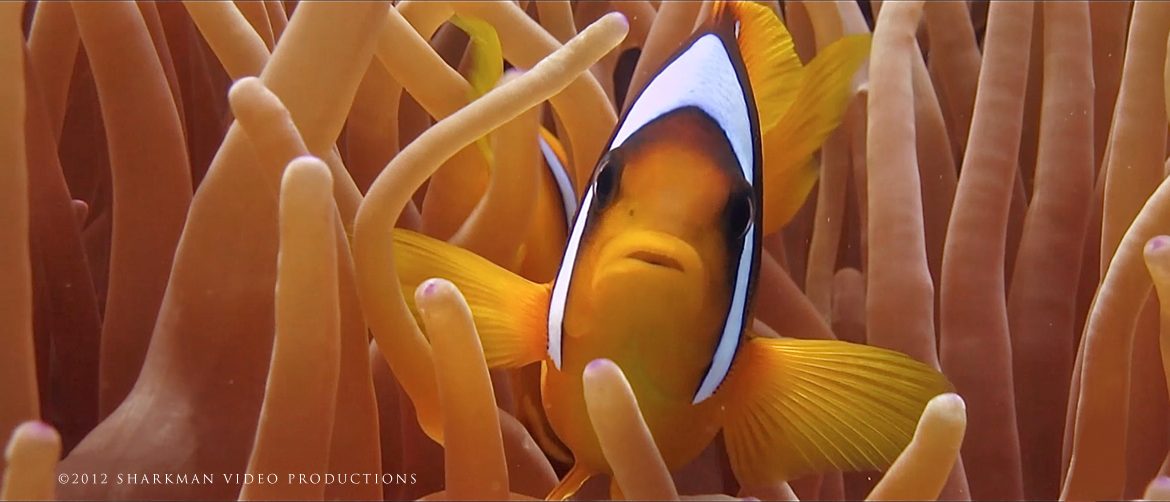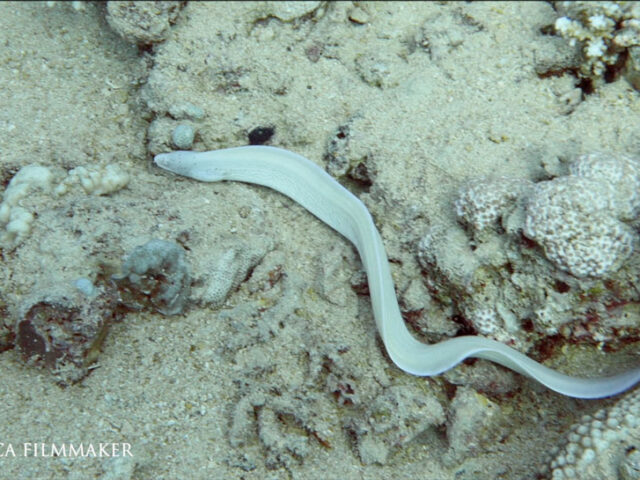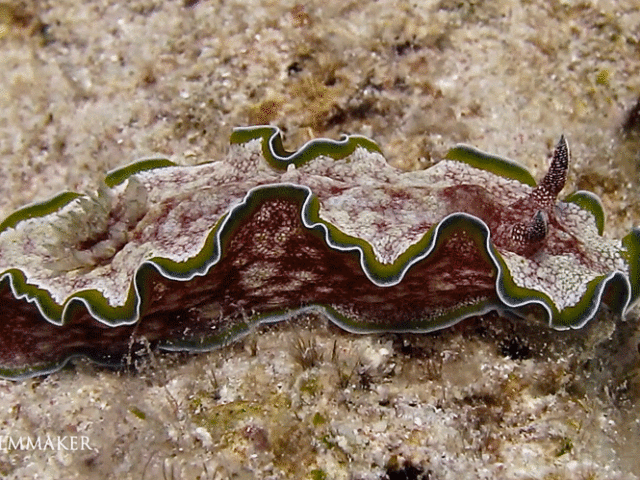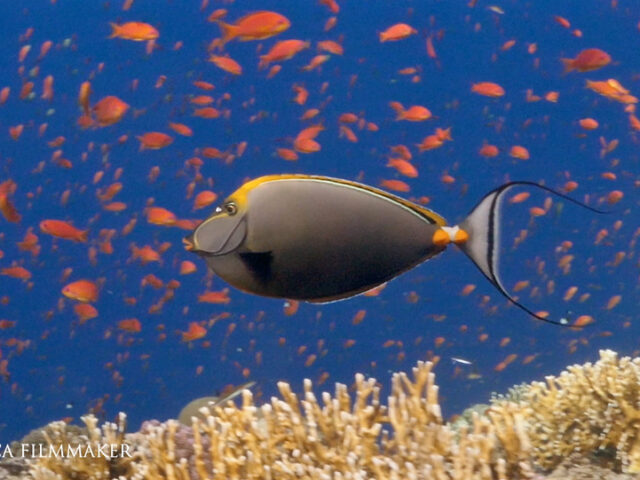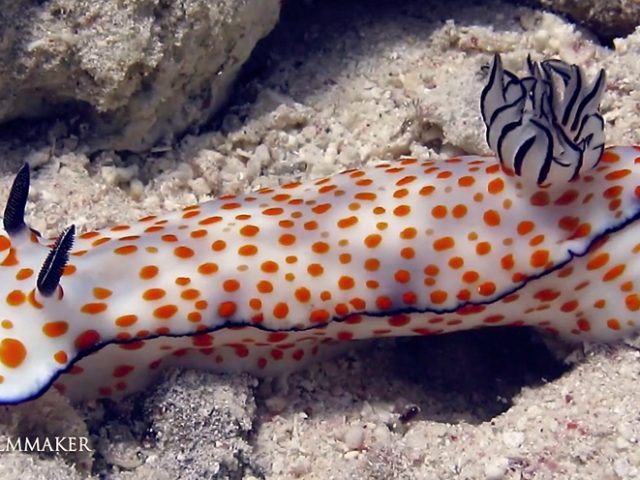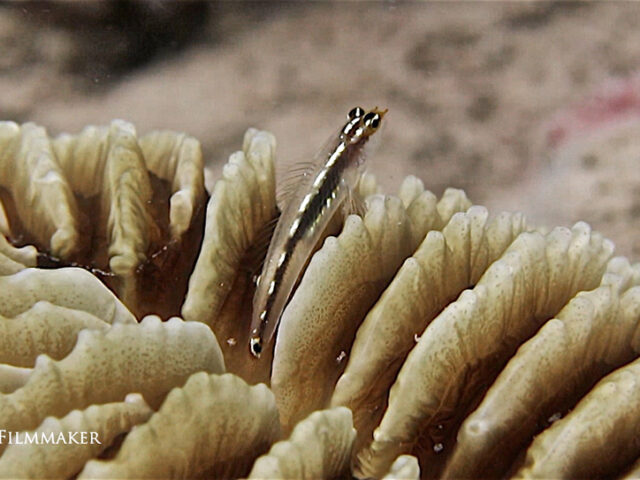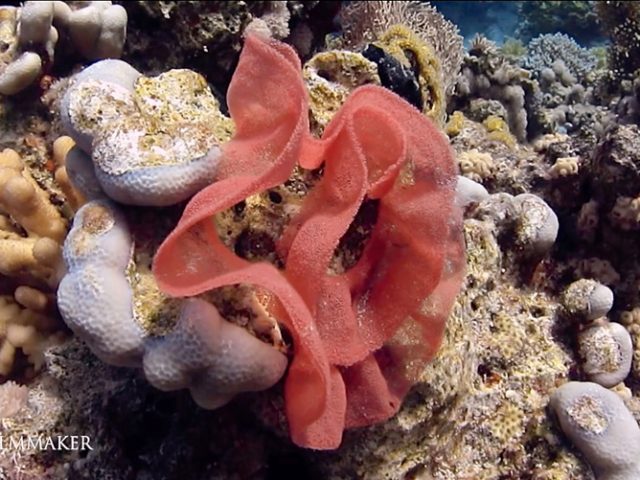These stills of different varieties of marine life have been taken from Nino’s underwater video library. He shot the footage in natural light to preserve the marine creatures behaviour and habits. Below the photos you can read some interesting information about these animals.
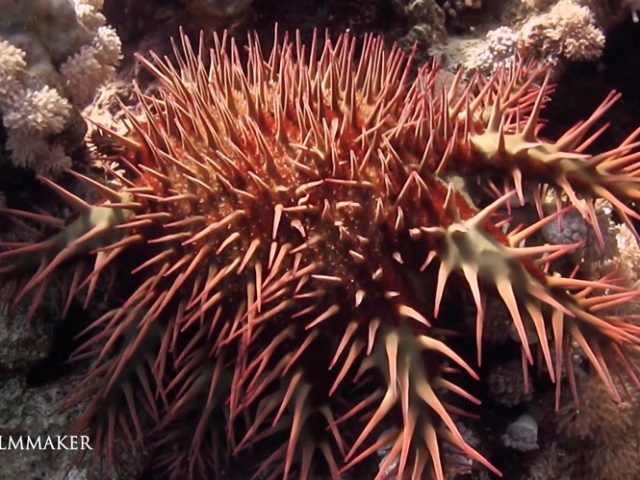
The “Crown of Thorns Seastar”, "Acanthaster Planci", is a large starfish that preys upon hard, or stony, coral polyps (Scleractinia). The crown of thorns starfish receives its name from venomous thorn-like spines that cover its upper surface, resembling the biblical crown of thorns. It is one of the largest starfish in the world. Acanthaster has a very wide Indo-Pacific distribution. It is perhaps most common in Australia, but can occur at tropical and subtropical latitudes from the Red Sea and the east African coast across the Indian Ocean, and across the Pacific Ocean to the west coast of Central America. It occurs where coral reefs or hard coral communities occur in this region. The body form of the crown-of-thorns starfish is fundamentally the same as that of a typical starfish, with a central disk and radiating arms. Its special traits, however, include being disc-shaped, multiple-armed, flexible, prehensile, and heavily spined, and having a large ratio of stomach surface to body mass. Adult crown-of-thorns starfish normally range in size from 25 to 35 cm (9.8 to 13.8 in). The adult crown-of-thorns is a corallivorous predator that usually preys on reef coral polyps, it's a popular idea that the coral and with it whole reefs were being destroyed by these starfish. (Wikipedia)
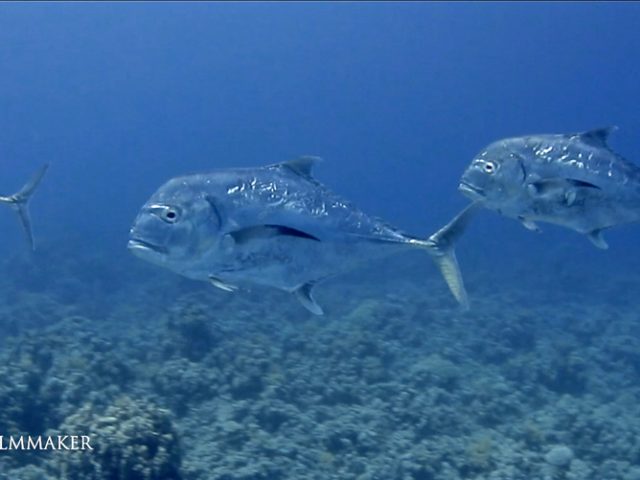
The African pompano (Alectis ciliaris), also known as the pennant-fish or threadfin trevally, is a widely distributed species of tropical marine fish in the jack family, Carangidae. The species is found in tropical waters worldwide, with adults often inhabiting coastlines, while juveniles are usually pelagic, floating with ocean currents. The adult African pompano is similar in appearance to the other members of the genus Alectis, with the concave shape of the head near the eyes; the clearest distinguishing feature. The juveniles are similar to other members of Alectis, having long, filamentous dorsal and anal fintips which are thought to discourage predators. The species lives in depths less than 100 m, consuming a range of crustaceans and small fishes. (Wikipedia)
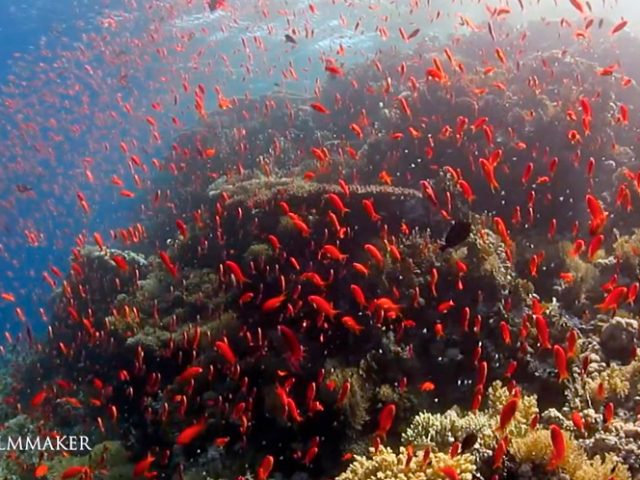
The “Sea Goldie” or “Goldfish" (Pseudanthias squamipinnis), also known as the “Lyretail Coralfish”, “Lyretail Anthias", is a small species of colorful fish in the subfamily “Anthiinae". The sea goldie is found in the western Indian Ocean including the Red Sea, and in the Pacific Ocean as far east as Japan and southeast Australia. It feeds primarily on zooplankton. Like other anthias, the sea goldie is a protogynous hermaphrodite; a male retains a harem of five to 10 females, but when the male dies, one of the females will undergo sex reversal and take the place of the missing male. Spawning occurs at sunset, between December and February (in the Red Sea). The fish lives around coral outcrops in clear lagoons, patch reefs, and steep slopes to a depth of 35 m, often found in the company of Chromis dimidiata. They are often found in very large schools above the reef. (Wikipedia)
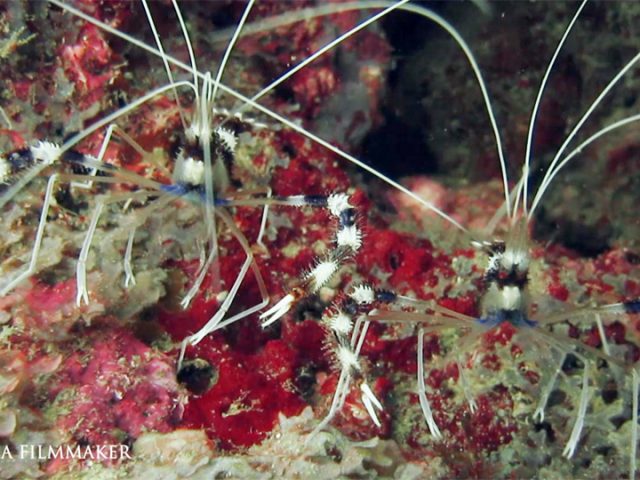
Stenopus hispidus is a shrimp-like decapod crustacean belonging to the infraorder Stenopodidea. Common names include banded coral shrimp and banded cleaner shrimp. It has a pan-tropical distribution, extending into some temperate areas. It reaches a total length of 60 millimetres (2.4 in) and has striking colouration; the ground colour is transparent, but the carapace, abdomen and the large third pereiopod are all banded red and white. The antennae and other pereiopods are white; the abdomen, carapace and third pereiopods are covered in spines. Banded Cleaner Shrimp lives below the intertidal zone, at depth of up to 210 metres (690 ft), on coral reefs. It is a cleaner shrimp and advertises to passing fish by slowly waving its long white antennae. It uses its three pairs of claws to remove parasites, fungi and damaged tissue from the fish. It is monogamous and females are typically larger than the males. (Wikipedia)
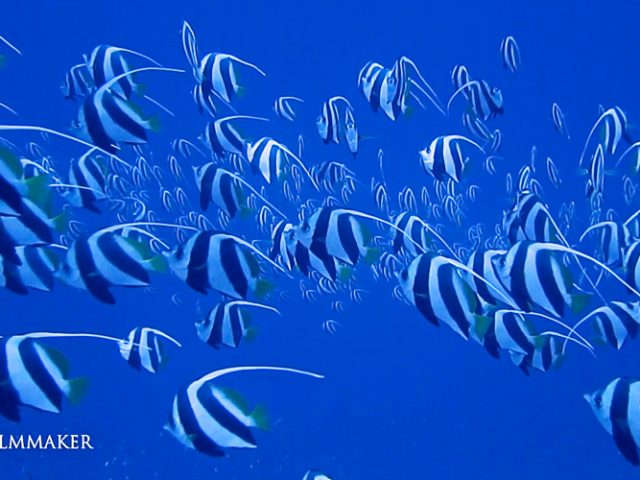
The “Butterflyfish" are a group of conspicuous tropical marine fish of the family “Chaetodontidae"; the “Bannerfish and “Coralfish" are also included in this group. The approximately 129 species in 12 genera are found mostly on the reefs of the Atlantic, Indian, and Pacific Oceans. A number of species pairsoccur in the Indian and Pacific Oceans, members of the huge genus Chaetodon. Butterflyfish look like smaller versions of angelfish (Pomacanthidae), but unlike these, lack preopercle spines at the gill covers. Some members of the genus Heniochus resemble the Moorish idol (Zanclus cornutus) of the monotypic Zanclidae. Among the paraphyletic Perciformes, the former are probably not too distantly related to butterflyfish, whereas the Zanclidae seem far less close. Most species feed on coral polyps and sea anemones. (Wikipedia)
![BATFISH “Platax" is a genus of Indo-Pacific, reef-associated fish belonging to the family Ephippidae, commonly known as “Batfish”. Adults are rather disc-shaped fish, with laterally compressed bodies and large dorsal and anal fins that give individuals a somewhat triangular profile. Platax teira is the largest species, reaching lengths of around 70 centimetres (28 in).[3] The other species reach maximum lengths of around 40–65 cm (16–26 in). Platax can be found in reefs throughout the entire Indo-Pacific region, their range extends from the western Indian Ocean in the Red Sea to as far east as Australia. They are most common around reefs and shipwrecks. (Wikipedia)](https://www.ninodelduca.com/wp-content/uploads/2020/10/BATFISH-640x480.jpg)
“Platax" is a genus of Indo-Pacific, reef-associated fish belonging to the family Ephippidae, commonly known as “Batfish”. Adults are rather disc-shaped fish, with laterally compressed bodies and large dorsal and anal fins that give individuals a somewhat triangular profile. Platax teira is the largest species, reaching lengths of around 70 centimetres (28 in).[3] The other species reach maximum lengths of around 40–65 cm (16–26 in). Platax can be found in reefs throughout the entire Indo-Pacific region, their range extends from the western Indian Ocean in the Red Sea to as far east as Australia. They are most common around reefs and shipwrecks. (Wikipedia)
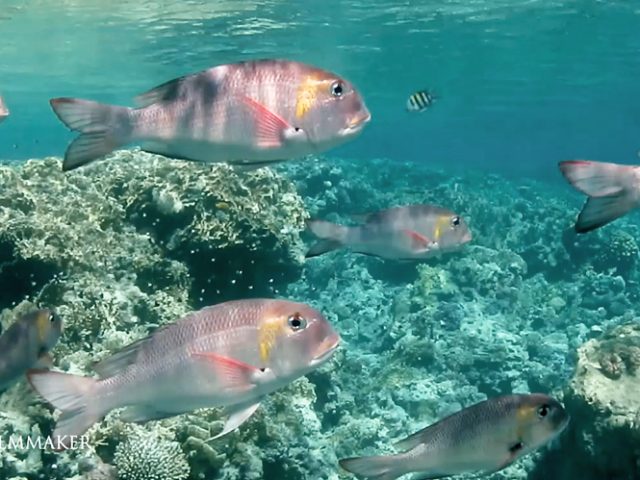
Monotaxis grandoculis, the humpnose big-eye bream, bigeye barenose, bigeye bream or bigeye emperor, is a species of emperor fish native to the Indian Ocean and the West and Central Pacific Ocean to the Hawaiian Islands and Red Sea. It inhabits areas with sand or rubble substrates adjacent to coral reefsat depths of from 1 to 100 metres (3.3 to 328.1 ft), mostly between 5 to 30 metres (16 to 98 ft). This species can reach a length of 40 centimetres (16 in). (Wikipedia)
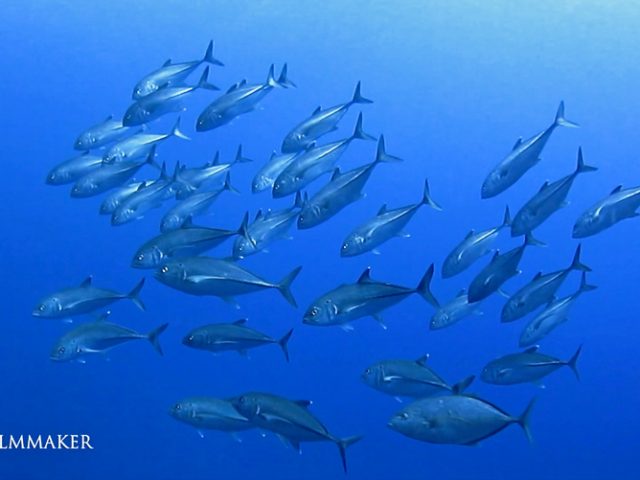
The “Bigeye Trevally" (Caranx sexfasciatus), also known as the “Bigeye Jack", “Dusky Jack", is a species of widespread large marine fish classified in the jack family “Carangidae". The bigeye trevally is distributed throughout the tropical waters of the Indian and Pacific Oceans, Red Sea, ranging from South Africa in the west to California and Ecuador in the east, including Australia to the south and Japan in the north. The bigeye trevally is best distinguished by its colouration, having a dark second dorsal fin with a white tip on the lobe, and also possessing a small dark spot on the operculum. Other more detailed anatomical features also set the species apart from other members of Caranx. The species is known to grow to a length of 120 cm and 18 kg. It is predominantly an inshore fish, inhabiting reefs down to depths of around 100 m in both coastal zones and offshore islands. The bigeye trevally is commonly found in large slow moving schools during the day, becoming active at night when it feeds, taking a variety of fish, crustaceans, cephalopods and other invertebrates. (Wikipedia)
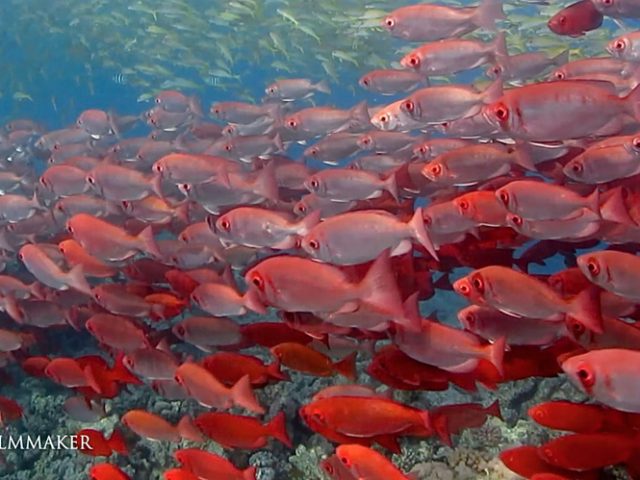
The “Priacanthidae", the “Bigeyes", are a family of 18 species of marine fish. The common name of "bigeye" refers to the member species' unusually large eyes, suited to their carnivorous and nocturnal lifestyles. Priacanthidae are typically colored bright red, but some have patterns in silver, dusky brown, or black. Most species reach a maximum total length of about 30 cm (12 in), although in a few species lengths of over 50 cm (20 in) are known. Most members of this family are native to tropical and subtropical parts of the Indian and Pacific Oceans, Red Sea. They tend to live near rock outcroppings or reefs, although a few are known to inhabit open waters. Many species are found in relatively deep waters, below depths reachable by normal scuba diving. (Wikipedia)
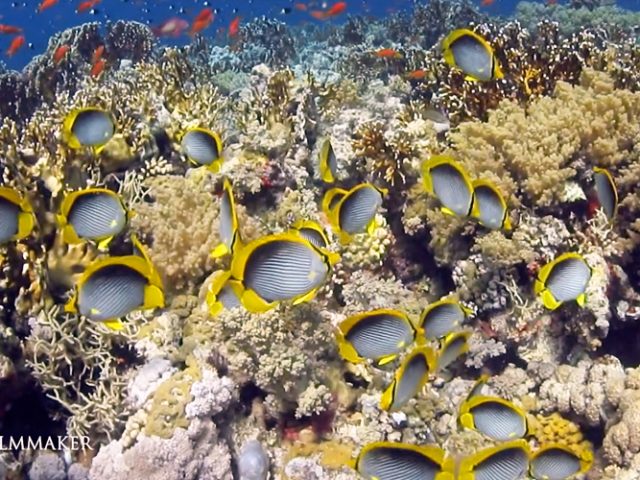
Or “Black-Backed Butterflyfish" (Chaetodon melannotus) is a species of butterflyfish (family Chaetodontidae). It is widespread through the Indo-Pacific area from the Red Sea and East Africa to Samoa, to southern Japan and throughout Micronesia. This fish grows up to 18 cm (c. 7 in) long, and may live for up to 20 years. They are all of oval shape, silvery with yellow fins and snout, ascending diagonal stripes, and black markings around the eyes, on the caudal peduncle, and sometimes on the back. Black-backed butterflyfish are generally found between 4 and 20 m deep, usually solitary, in pairs or school during the breeding season. (Wikipedia)
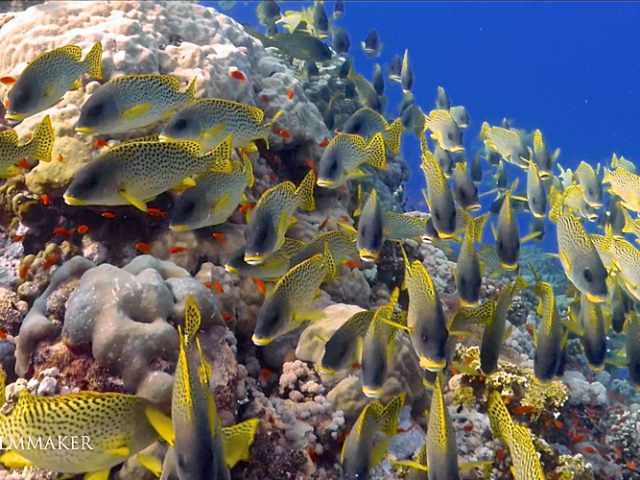
"Plectorhinchus Gaterinus", commonly known as the “Blackspotted Rubberlip" or "African Grunt", is a species of fish belonging to the family Haemulidae. This species can be found in the Western Indian Ocean, from Persian Gulf and the Red Sea to Natal, South Africa, Mauritius, Madagascar and Comoro Islands. These marine tropical fish are reef-associated and may also occur in sand banks and near estuaries. They can reach a depth of 55 m. Plectorhinchus gaterinus commonly reaches a length of 30 centimetres (12 in), with a maximum size of 50 centimetres (20 in) in males. These fishes have 13 dorsal spines, 19-20 dorsal soft rays, three anal spines and seven anal soft rays. Body of the adults is silvery with black spots and yellow lips and fins. The forehead of the head is gray. This species is oviparous. Blackspotted rubberlips mainly eat benthic vertebrates, crustaceans and other invertebrates. They usually occurs by day in small groups or large swarms along coral slopes and under ledges. (Wikipedia)
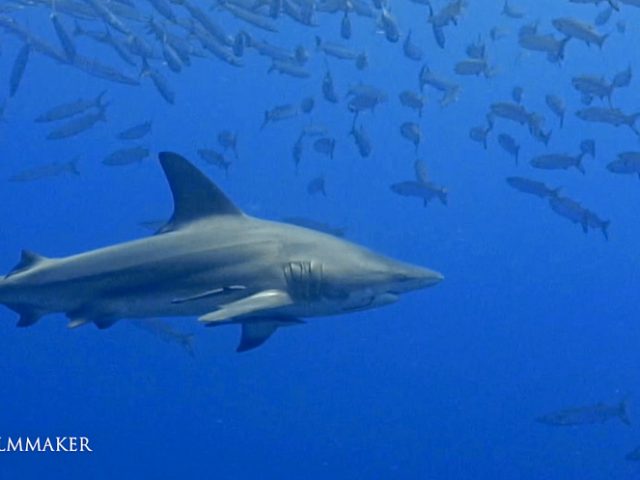
Or “Oceanic Blacktip" (Carcharhinus limbatus) is a species of requiem shark, and part of the family Carcharhinidae. Not to be confused with the blacktip reef shark. It is common to coastal tropical and subtropical waters around the world, including brackish habitats. Genetic analyses have revealed substantial variation within this species, with populations from the western Atlantic Ocean isolated and distinct from those in the rest of its range. The blacktip shark has a stout, fusiform body with a pointed snout, long gill slits, and no ridge between the dorsal fins. Most individuals have black tips or edges on the pectoral, dorsal, pelvic, and caudal fins. It usually attains a length of 1.5 m (4.9 ft). Swift, energetic piscivores, blacktip sharks are known to make spinning leaps out of the water while attacking schools of small fish. Their demeanor has been described as "timid" compared to other large requiem sharks. Both juveniles and adults form groups of varying size. Like other members of its family, the blacktip shark is viviparous. Fish make up some 90% of the blacktip shark's diet. A wide variety of fish have been recorded as prey for this species: sardines, herring, anchovies, ladyfish, sea catfish, cornetfish, flatfish, threadfins, mullet, mackerel, jacks, groupers, snook, porgies, mojarras, emperors, grunts, butterfish, tilapia, triggerfish, boxfish, and porcupinefish. (Wikipedia)
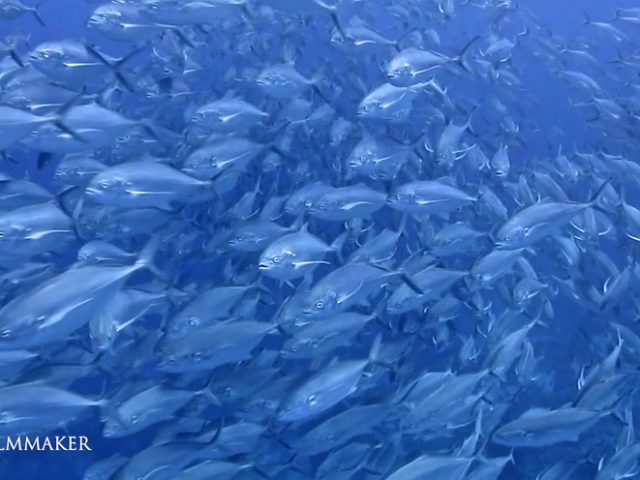
The “Blue Runner" (Caranx crysos), also known as the "Egyptian Scad”, “Hardtail Jack" or “Hardnose", is a common species of moderately large marine fish classified in the jack family, Carangidae. The blue runner is distinguished from similar species by several morphological features, including the extent of the upper jaw, gill raker count and lateral line scale counts. The blue runner is known to reach a maximum length of 70 cm and 5.05 kg in weight, but is much more common below 35 cm. The species inhabits both inshore and offshore environments, predominantly over reefs. The blue runner is a schooling, predatory fish, predominantly taking fish in inshore environments, as well as various crustaceans and other invertebrates. Fish living offshore feed nearly exclusively on zooplankton. (Wikipedia)
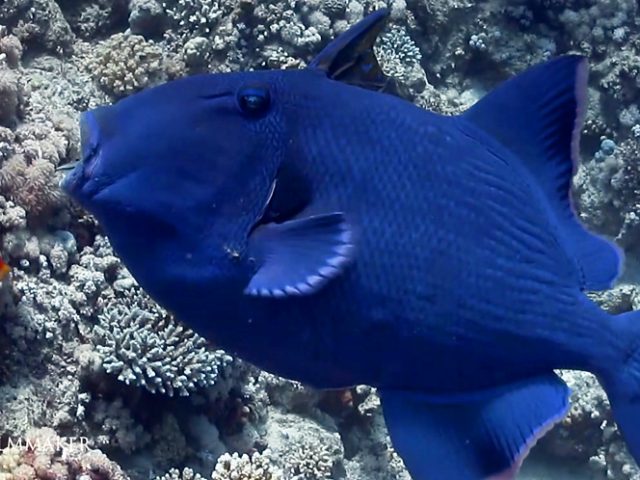
Triggerfish are about 40 species of often brightly colored fish of the family “Balistidae". Often marked by lines and spots, they inhabit tropical and subtropical oceans throughout the world, with the greatest species richness in the Indo-Pacific. Most are found in relatively shallow, coastal habitats, especially at coral reefs, but a few, such as the oceanic triggerfish (Canthidermis maculata), are pelagic. Triggerfish have an oval-shaped, highly compressed body. The head is large, terminating in a small but strong- jawed mouth with teeth adapted for crushing shells. The eyes are small, set far back from the mouth, at the top of the head. As a protection against predators, triggerfish can erect the first two dorsal spines: The first (anterior) spine is locked in place by erection of the short second spine, and can be unlocked only by depressing the second, “trigger” spine, hence the family name “triggerfish”. The rather bizarre anatomy of the triggerfish reflects their typical diet of slow-moving, bottom dwelling crustaceans, mollusks, sea urchins and other echinoderms, generally creatures with protective shells and spines. Triggerfish males migrate to their traditional spawning sites prior to mating and establish territories; they are fierce in guarding their territories as having a territory is essential for reproduction. A male's territory is used for spawning and parental care. Most male territories are located over a sandy sea bottom or on a rocky reef. (Wikipedia)
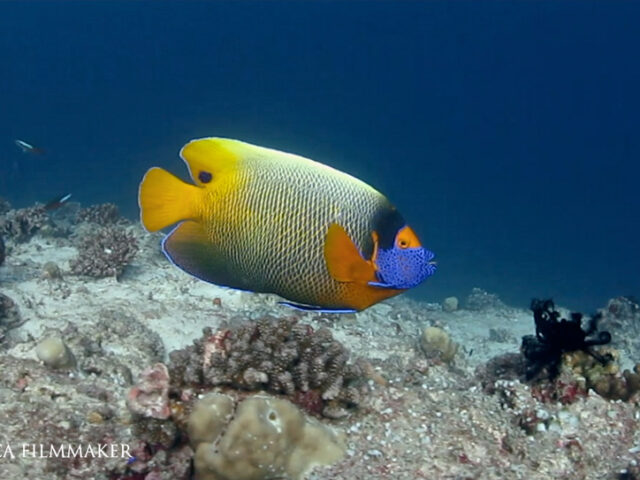
Pomacanthus xanthometopon is a ray-finned fish in the family Pomacanthidae found in shallow parts of the Indo-Pacific. It is commonly known as the blueface angelfish or the yellowface angelfish because of its striking facial colouration. It is found on coral reefs in the eastern part of the tropical Indo-Pacific; its range includes the Maldive Islands, Malaysia, Indonesia, Japan, Taiwan, the Philippines, northern Australia and Micronesia. The blueface angelfish grows to a maximum length of 38 centimetres (15 in) and is laterally compressed. The mouth is just above the tip of the snout, the face is yellow with a dense network of brilliant blue lines on the bottom half and a plain yellow mask around the eyes. It favours lagoons, outer reef slopes and channels at depths down to about 25 metres (82 ft) and is often found among rocks and near caves. The juveniles frequently live inside caves. The bluface Angelfish feeds on tunicates, sponges, other encrusting organisms and algae. (Wikipedia)
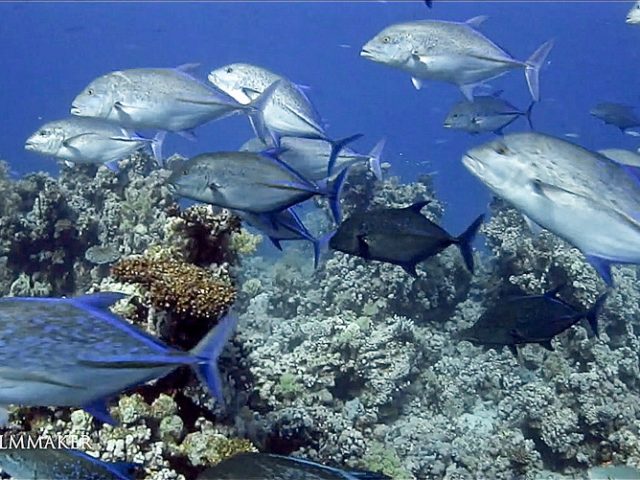
The bluefin trevally, Caranx melampygus (also known as the bluefin jack, bluefin kingfish, bluefinned crevalle, blue ulua, omilu and spotted trevally), is a species of large, widely distributed marine fish classified in the jack family, Carangidae. The bluefin trevally is distributed throughout the tropical waters of the Indian and Pacific Oceans, ranging from Eastern Africa in the west to Central America in the east, including Japan in the north and Australia in the south. The species grows to a maximum known length of 117 cm and a weight of 43.5 kg, however is rare above 80 cm. Bluefin trevally are easily recognised by their electric blue fins, tapered snout and numerous blue and black spots on their sides. It is similar in shape to a number of other large jacks and trevallies, having an oblong, compressed body with the dorsal profile slightly more convex than the ventral profile, particularly anteriorly. The bluefin trevally inhabits both inshore environments such as bays, lagoons and shallow reefs, as well as deeper offshore reefs, atolls and bomboras. It is a strong predatory fish, with a diet dominated by fish and supplemented by cephalopods and crustaceans as an adult. Juveniles consume a higher amount of small crustaceans, but transfer to a more fish based diet as they grow. The species displays a wide array of hunting techniques ranging from aggressive midwater attacks, reef ambushes and foraging interactions with other larger species, snapping up any prey items missed by the larger animal. (Wikipedia)
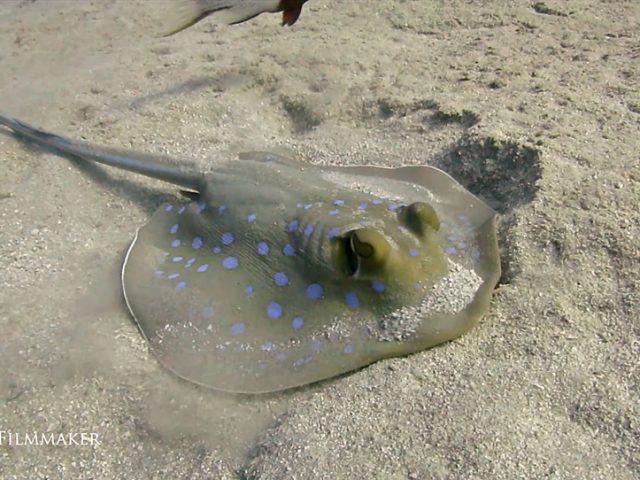
The “Bluespotted Ribbontail Ray" (Taeniura lymma) is a species of stingray in the family “Dasyatidae". Found from the intertidal zone to a depth of 30 m (100 ft), this species is common throughout the tropical Indian and western Pacific Oceans in nearshore, coral reef-associated habitats. It is a fairly small ray, not exceeding 35 cm (14 in) in width, with a mostly smooth, oval pectoral fin disc, large protruding eyes, and a relatively short and thick tail with a deep fin fold underneath. It can be easily identified by its striking color pattern of many electric blue spots on a yellowish background, with a pair of blue stripes on the tail. At night, small groups of bluespotted ribbontail rays follow the rising tide onto sandy flats to root for small benthic invertebrates and bony fishes in the sediment. When the tide recedes, the rays separate and withdraw to shelters on the reef. Reproduction is aplacental viviparous, with females giving birth to litters of up to seven young. It excavates sand pits in search of molluscs, polychaete worms, shrimps, crabs, and small benthic bony fishes; when prey is located, it is trapped by the body of the ray and maneuvered into the mouth with the disc. Known predators of the bluespotted ribbontail ray include hammerhead sharks (Sphyrna) and bottlenose dolphins (Tursiops); it is also potentially preyed upon by other large fish and marine mammals. This ray is capable of injuring humans with its venomous tail spines, though it prefers to flee if threatened. (Wikipedia)
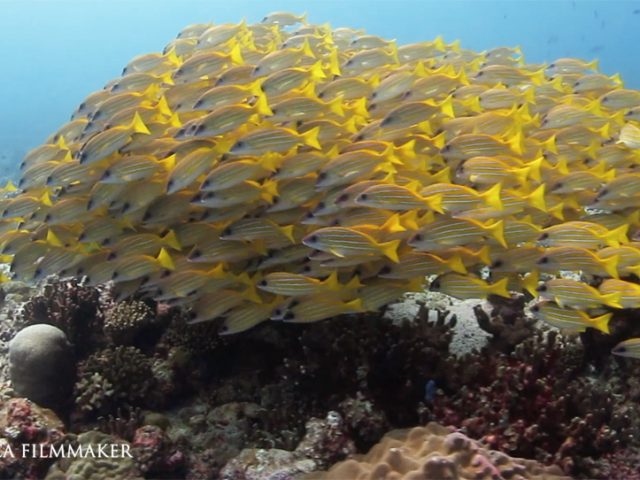
The bluestripe snapper, bluestripe sea perch or blue-line snapper, Lutjanus kasmira, is a species of snapper native to the Indian Oceanfrom the coast of Africa and the Red Sea to the central Pacific Ocean. The body is moderately deep in profile, with the dorsal profile of the head steeply sloped, having a well-developed preopercular notch and knob; the back and sides of the fish are bright yellow, with the lower sides and underside of head fading to white. Four bright-blue stripes run longitudinally on the side of the fish, with several faint greyish stripes on lowermost part of sides. Like many snappers, it inhabits coral reefs, occurring in both shallow lagoons and on outer reef slopes to depths of at least 60 m (200 ft); they frequently gather in large aggregations around coral formations, caves or wrecks during daylight hours. The bluestripe snapper has a varied diet, feeding on fish, shrimp, crabs, stomatopods, cephalopods and planktonic crustaceans, as well as plant and algal materials. (Wikipedia)
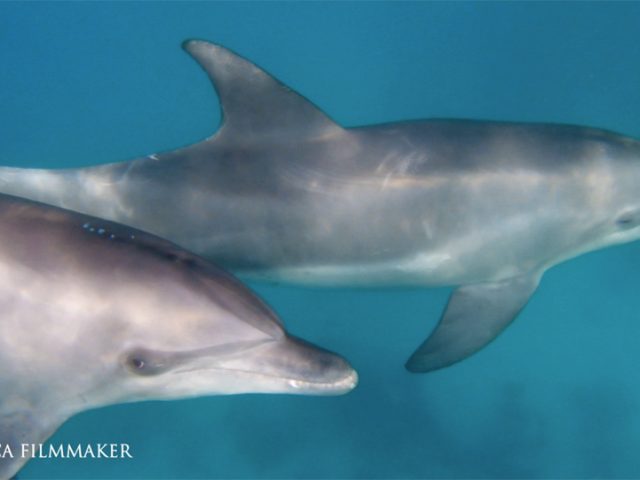
Bottlenose dolphins, the genus Tursiops, are the most common members of the family Delphinidae, the family of oceanic dolphin. Bottlenose dolphins inhabit warm and temperate seas worldwide, being found everywhere except for the Arcticand Antarctic Circle regions. The bottlenose dolphin weighs an average of 300 kg (660 pounds). It can reach a length of just over 4 meters (13 feet); its color varies considerably, is usually dark gray on the back and lighter gray on the flanks, but it can be bluish-grey, brownish-grey or even nearly black, and is often darker on the back from the rostrum to behind the dorsal fin; older dolphins sometimes have a few spots. They can live for more than 40 years. The dolphin's search for food is aided by a form of sonar known as echolocation: it locates objects by producing sounds and listening for the echoes. Numerous investigations of bottlenose dolphin intelligence have been conducted, examining mimicry, use of artificial language, object categorization and self-recognition. They can use tools (sponging; using marine sponges to forage for food sources they normally could not access) and transmit cultural knowledge from generation to generation, and their considerable intelligence has driven interaction with humans. Bottlenose dolphins have the third largest encephalization levels of any mammal on Earth (humans have the largest), sharing close ratios with those of humans and other great apes, which more than likely contributes to their high intelligence and emotional intelligence. (Wikipedia)
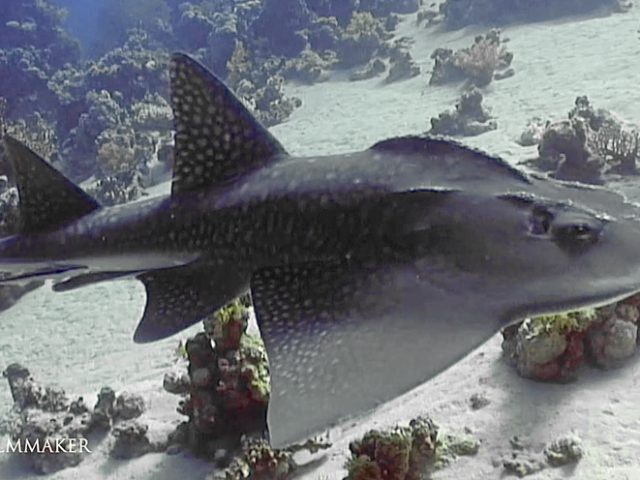
The “Bowmouth Guitarfish" (Rhina ancylostoma), also called the "Shark Ray" or “Mud Skate", is a species of ray and a member of the family Rhinidae. Its evolutionary affinities are not fully resolved, though it may be related to true guitarfish and skates. This rare species occurs widely in the tropical coastal waters of the western Indo-Pacific, at depths of up to 90 m (300 ft). Highly distinctive in appearance, the bowmouth guitarfish has a wide and thick body with a rounded snout and large shark-like dorsal and tail fins. Its mouth forms a W-shaped undulating line, and there are multiple thorny ridges over its head and back. It has a dorsal color pattern of many white spots over a bluish gray to brown background, with a pair of prominent black markings over the pectoral fins. This large species can reach a length of 2.7 m (8.9 ft) and weight of 135 kg (298 lb). Usually found near the sea floor, the bowmouth guitarfish prefers sandy or muddy areas near underwater structures. It is a strong-swimming predator of bony fish, crustaceans, and molluscs. (Wikipedia)
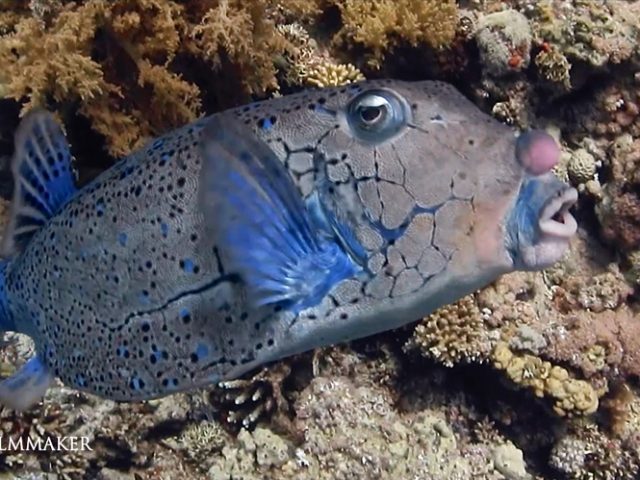
“Ostraciidae" is a family of squared, bony fish belonging to the order Tetraodontiformes, closely related to the pufferfish and filefish. Fish in the family are known variously as “Boxfish”, “Cofferfish”, “Cowfish" and “Trunkfish". It contains about 23 extant species in 6 extant genera. Members of this family occur in a variety of different colors, and are notable for the hexagonal or "honeycomb" patterns on their skin. They swim in a rowing manner. Their hexagonal plate-like scales are fused together into a solid, triangular or box-like carapace, from which the fins, tail, eyes and mouth protrude. Because of these heavy armoured scales, Ostraciidae are limited to slow movements, but few other fish are able to eat the adults. Although the adults are in general quite square in shape, young Ostraciidae are more rounded; the young often exhibit brighter colors than the adults. Boxfish occur in the Atlantic, Indian, and Pacific oceans, generally at middle latitudes. (Wikipedia)
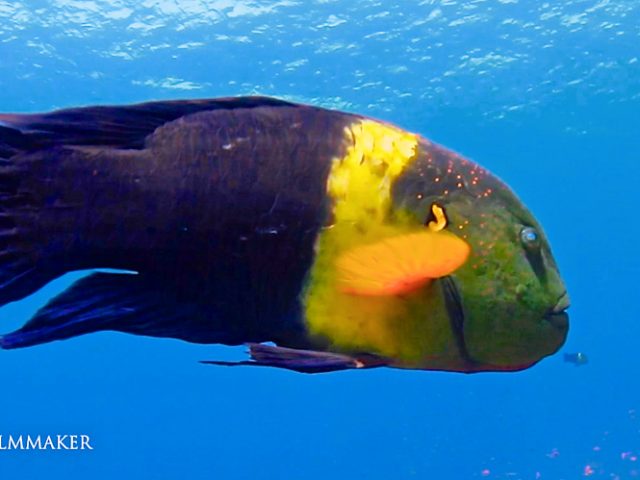
The “Broomtail Wrasse" (Cheilinus lunulatus) is a species of wrasse native to the Red Sea and Indian Ocean. It can reach an average length of about 35 cm (14 in), with a maximum of 50 cm (20 in) in males. In adults, the head is large and bright green, with small spots. The lips are large and blue. The pectoral fins are yellow, while the abdominal, the anal, and caudal fins are dark blue. The body is yellow-green in the middle and dark purple in the other part. Close to the operculum is a characteristic bright-yellow marking on a black background. It has a long fringed caudal fin, resembling an old broom (hence the common name). Broomtail wrasses can be found on coral reefs and on adjacent sand and seagrass habitats, at depths of from 2 to 30 m (6.6 to 98.4 ft). (Wikipedia)
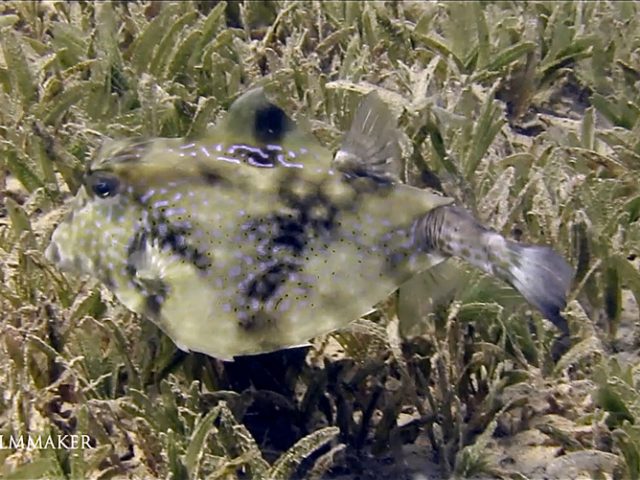
Tetrosomus gibbosus, commonly called camel cowfish because of the hump on its dorsal keel, is one of 22 species in the boxfish family, Ostraciidae. It is normally around 20 cm (7.9 in) long when it is fully grown, but can reach up to 30 cm (11.8 in) in length. Fish in the genus Tetrosomus are characterized by the presence of a carapace, a hard upper shell formed by thick scale plates. The body is completely encased in this bony shell, except for a few small openings such as the mouth, eyes and gills. Other common names include helmet cowfish, humpback turretfish and thornbacked boxfish. It is a species of boxfish native to the Indo-West Pacific. Camel Cowfish is mainly found at depths of 37–110 m (121–361 ft) on slopes or over muddy bottoms, but can sometimes be seen near shallow seagrass beds. Like other boxfish species, its flesh is poisonous; it feeds on a wide variety of invertebrates and algae. (Wikipedia)
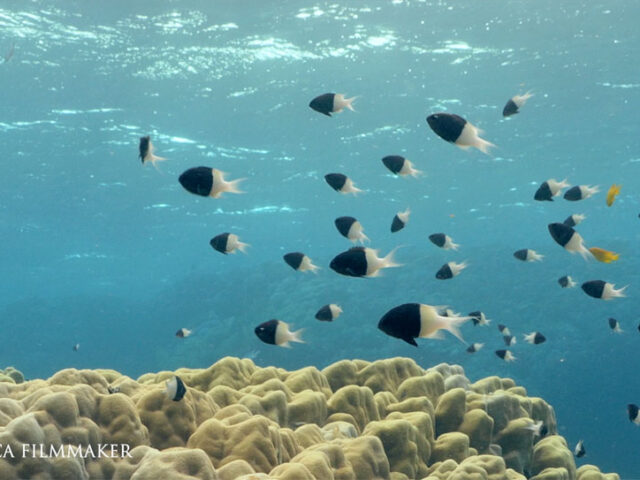
Chromis iomelas, also known as the Half and Half Chromis, is a species of reef dwelling fish in the family Pomacentridae. It is split in color, being solid black from the middle of the dorsal fin to the nose, and solid white from the middle of the dorsal fin to the end of the caudal fin. It grows to a size of 8 cm in length. This species is from the Pacific ocean. It can be found on the Great Barrier Reef, around northern New Guinea, Samoa, the Society Islands and Red Sea. (Wikipedia)
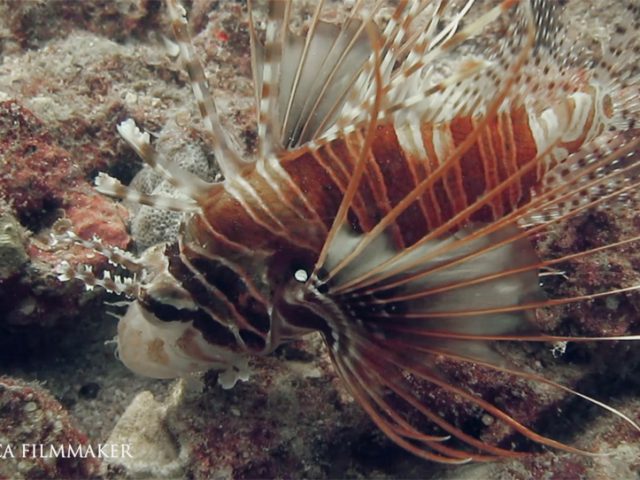
The clearfin lionfish (Pterois radiata), also called the tailbar lionfish, radiata lionfish, fireworks fish or radial firefish, is a carnivorous, ray-finned fishwith venomous spines that lives in the Indian and western Pacific Oceans. This is the only lionfish species which has spines without any markings. It can also be recognized by the pair of horizontal white stripes on its caudal peduncle. It grows to a length of about 24 cm (9 in), though a more usual size is 20 cm (8 in). The dorsal fin has 12 or 13 long, venomous spines and 10 to 12 soft rays. The large pectoral fins flare out to the side and are clear and unbanded. The head and body colour is reddish-brown with about six vertical dark bands of different colour on the body separated by thin white lines. Two white horizontal lines occur on the caudal peduncle which distinguishes this fish from other similar lionfishes. Clearfin lionfish are native to the western Indo-Pacific region. Its range extends from South Africa and the Red Sea to Indonesia, the Society Islands, the Ryukyu Islands, northern Australia and New Caledonia. It is found on both inshore and offshore rocky reefs at depths to about 25 m (82 ft). This species is mainly nocturnal, it spends the day hiding in rock crevices, in small caves or under overhangs; it emerges at night to feed on invertebrates such as crabs and shrimps. (Wikipedia)
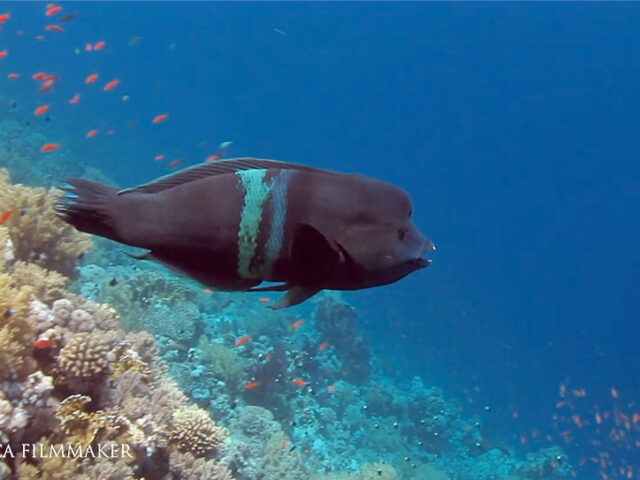
Clown sand wrasse or Clown coris or just Clown wrasse can grow to 120 cm in length. There is a marked difference in appearance between juveniles and adults; juveniles are white and orange with false eyes on the dorsal fin, while adults are uniformly dark green or with light banding and developing a prominent forehead. Occurs in the vicinity of sand or rubble patches of exposed outer reef flats, lagoon reefs, and seaward reefs. Feeds mainly on hard-shelled invertebrates including crustaceans, mollusks and sea urchins. (Wikipedia)
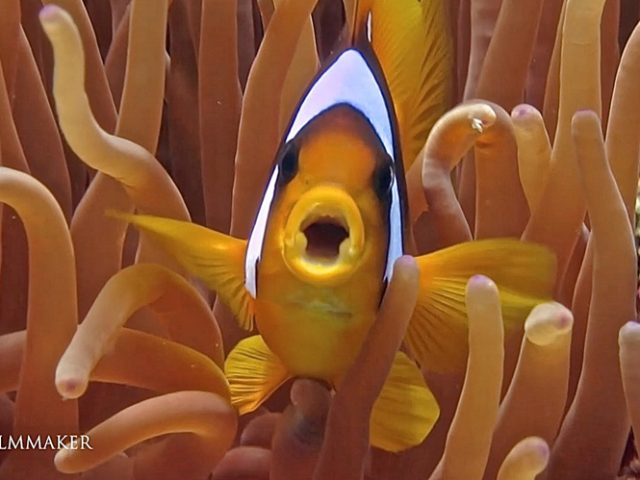
“Clownfish" or “Anemonefish" are fish from the subfamily “Amphiprioninae" in the family “Pomacentridae". In the wild, they all form symbiotic mutualisms with sea anemones. Depending on species, anemonefish are overall yellow, orange, or a reddish or blackish color, and many show white bars or patches. The largest can reach a length of 15–16 cm (5.9–6.3 in), while the smallest barely achieve 7–8 cm (2.8–3.1 in). They are native to colder waters of the Indian and Pacific Oceans, including the Great Barrier Reef and the Red Sea. While most species have restricted distributions, others are widespread. Anemonefish live at the bottom of shallow seas in sheltered reefs or in shallow lagoons. "Sea anemones" are a group of marine predatory animals of the order “Actiniaria". A typical sea anemone is a single polyp attached to a hard surface by its base, but some species live in soft sediment and a few float near the surface of the water. The polyp has a columnar trunk topped by an oral disc with a ring of tentacles and a central mouth. The tentacles can be retracted inside the body cavity or expanded to catch passing prey. They are armed with cnidocytes (stinging cells). In many species, additional nourishment comes from a symbiotic relationship with single-celled dinoflagellates, zooxanthellae or with green algae, zoochlorellae, that live within the cells. Several species of fish and invertebrates live in symbiotic or commensal relationships with sea anemones, most famously the "Clownfish". The symbiont receives the protection from predators provided by the anemone's stinging cells, and the anemone utilises the nutrients present in its faeces. Sea anemones are found in both deep oceans and shallow coastal waters worldwide; the majority of species cling on to rocks, shells or submerged timber, often hiding in cracks or under seaweed, but some burrow into sand and mud, and a few are pelagic. (Wikipedia)
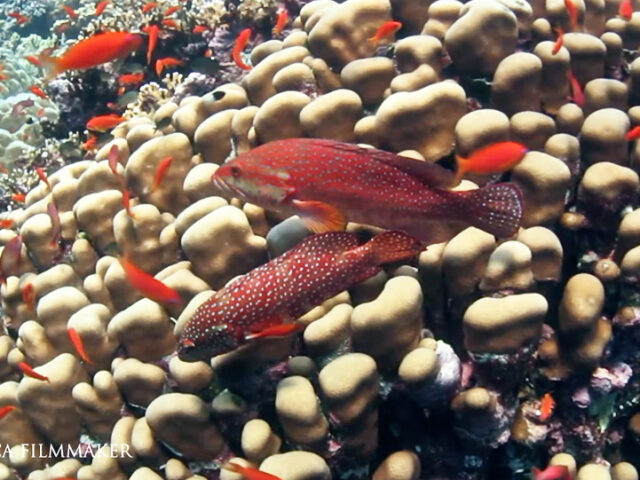
Cephalopholis miniata, coral grouper, coral hind, coral rock cod, coral cod, coral trout, round-tailed trout or vermillion seabass is a species of marine ray-finned fish, a grouper from the subfamily Epinephelinae which is in the family Serranidae which also includes the anthias and sea basses. It is associated with coral reefs and occurs in the Indo-Pacific. The colour of the body is orange-red to reddish brown with many small bright blue spots which cover the head, body and the dorsal, anal and caudal fins. They attain a maximum total length of 50 centimetres (20 in). Coral Grouper is found in clear water where there are coastal and offshore coral reefs, it prefers exposed rather than protected areas. It is often seen in caves and below ledges. The remainder of its diet consists of crustaceans. (Wikipedia)
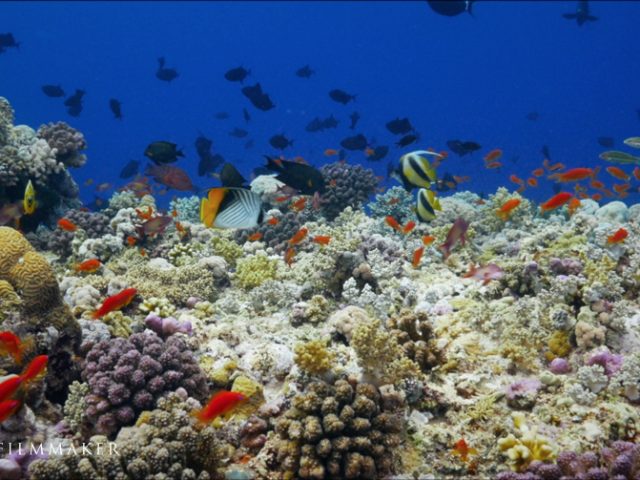
A coral reef is an underwater ecosystem characterized by reef-building corals. Reefs are formed of colonies of coral polyps held together by calcium carbonate. Most coral reefs are built from stony corals, whose polyps cluster in groups. Coral belongs to the class Anthozoa in the animal phylum Cnidaria, which includes sea anemones and jellyfish. Unlike sea anemones, corals secrete hard carbonate exoskeletons that support and protect the coral. Most reefs grow best in warm, shallow, clear, sunny and agitated water. Sometimes called rainforests of the sea, shallow coral reefs form some of Earth's most diverse ecosystems. They occupy less than 0.1% of the world's ocean area, about half the area of France, yet they provide a home for at least 25% of all marine species, including fish, mollusks, worms, crustaceans, echinoderms, sponges, tunicates and other cnidarians. Coral reefs flourish in ocean waters that provide few nutrients. They are most commonly found at shallow depths in tropical waters, but deep water and cold water coral reefs exist on smaller scales in other areas. (Wikipedia)
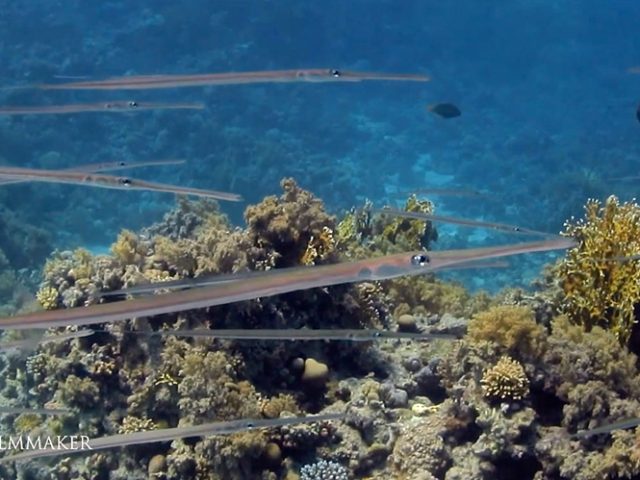
The “Cornetfish" or “Flutemouths" are a small family, the “Fistulariidae", of extremely elongated fish in the order Syngnathiformes. The family consists of a single genus, “Fistularia", with four species, found worldwide in tropical and subtropical marine environments. Ranging up to 200 cm (6.6 ft) in length, cornetfish are as thin and elongated as many eels, but are distinguished by very long snouts, distinct dorsal and anal fins, and forked caudal fins whose center rays form a lengthy filament. The lateral line is well-developed and extends onto the caudal filament. They generally live in coastal waters or on coral reefs, where they feed on small fish, crustaceans, and other invertebrates. (Wikipedia)
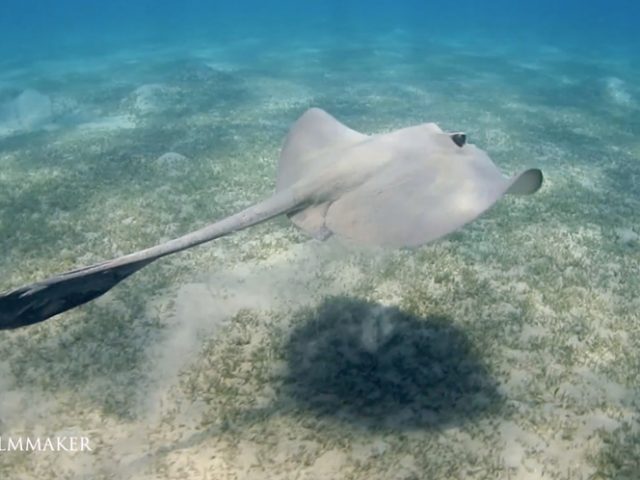
The “Cowtail Stingray" (Pastinachus sephen) is a species of stingray in the family “Dasyatidae", it has a widespread distribution in the tropical waters of the Indo-Pacific, from South Africa and the Red Sea to Japan and Australia, including Melanesia and Micronesia. The most distinctive characteristic of the cowtail stingray is the large, flag-like ventral fold on its tail, which is especially prominent when the ray is swimming. They are usually found on sandy bottoms in coastal waters and on coral reefs to a depth of 60 meters (200 feet). The pectoral fin disk of the cowtail stingray is very thick, with almost straight anterior margins and rounded apices, and measuring 1.1-1.3 times as long as wide. The snout is broadly rounded and blunt, the eyes are very small and widely spaced and the mouth is narrow, with 20 rows of distinctive hexagonal, high-crowned teethin each jaw and five papillae on the mouth floor. The tail is broad-based, with a filamentous tip and a single venomous spine located well backwards of the pelvic fins. This species may reach 3 meters (9.8 feet) long and 1.8 meters (5.9 feet) across, and 250 kg (550 lb) in weight. (Wikipedia)
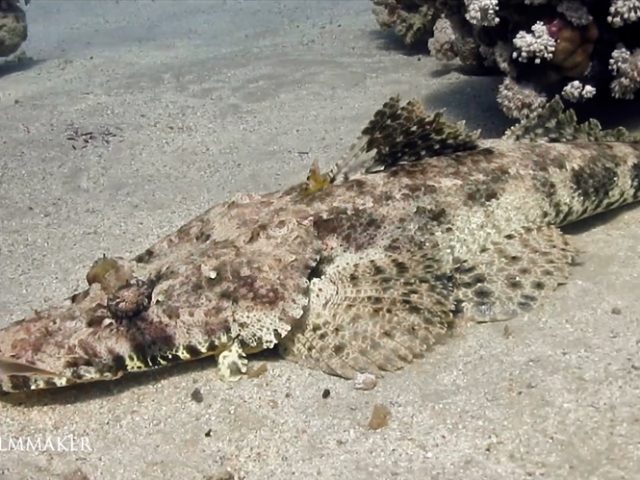
The “Crocodilefish" (Cymbacephalus beauforti), also known as "De Beaufort's flathead" or "Giant flathead", is a member of the order Scorpaeniformes, which also includes the scorpionfish and stonefish. It is a medium-sized fish which grows up to 50 cm (19.7 in), but the average size mostly observed is 35 cm (13.8 in). The body is covered with a pattern like a mosaic of beige to brown spots or even greenish to grey separated by an interlacing of blue lines which ideally camouflaged them with their habitat; it is elongated and the head is particular because of its flat appearance like a duck bill; they have lappets at the rear of their globulous eyes, which help to break up the outline of the black iris and improve their camouflage. It is widely distributed throughout the tropical waters of the center of the Indo-West Pacific. Crocodilefish dwell in sandy patch and detritic zone where their camouflage is most effective, usually associated with reefs or mangroves in shallow water and protected areas. They are found in a range of depth from 2 to 30 m. They are carnivorous, their diet is based on small fish and crustaceans. (Wikipedia)
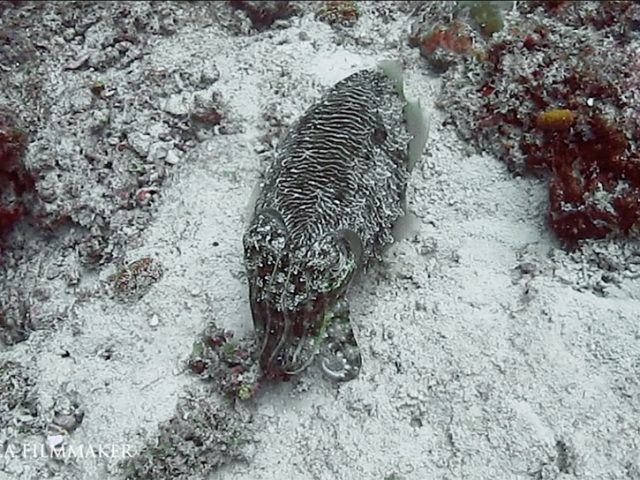
Cuttlefish or cuttles are marine molluscs of the order Sepiida. They belong to the class Cephalopoda, which also includes squid, octopuses, and nautiluses. Cuttlefish have a unique internal shell, the cuttlebone, which is used for control of buoyancy. It has large, W-shaped pupils, eight arms and two tentacles furnished with denticulated suckers, with which they secure their prey. They generally range in size from 15 to 25 cm (6 to 10 in). Cuttlefish eat small molluscs, crabs, shrimp, fish, octopus, worms and other cuttlefish. Their predators include dolphins, sharks, fish, seals, seabirds and other cuttlefish. The average life expectancy of a cuttlefish is about 1–2 years. Studies are said to indicate cuttlefish to be among the most intelligent invertebrates, they also have one of the largest brain-to-body size ratios of all invertebrates. (Wikipedia)
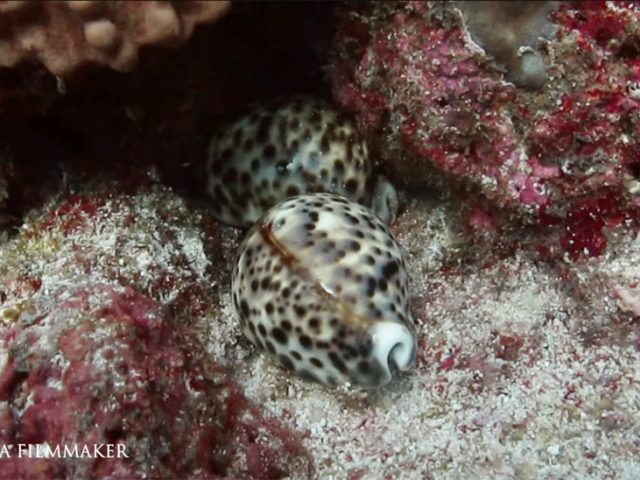
Cypraea is a genus of medium-sized to large sea snails or cowries, marine gastropod mollusks in the family Cypraeidae, the cowries. They have adult shells which are very rounded, almost like an egg; they do not look like a typical gastropod shell. In virtually all of the species in the family Cypraeidae, the shells are extremely smooth and shiny; this is because in the living animal, the shell is nearly always fully covered with the mantle. Typically, no spire is visible in the fully adult shell, and there is a long, narrow, aperture which is lined with “teeth”. Cowries have no operculum, sponges are the most commonly described prey. (Wikipedia)
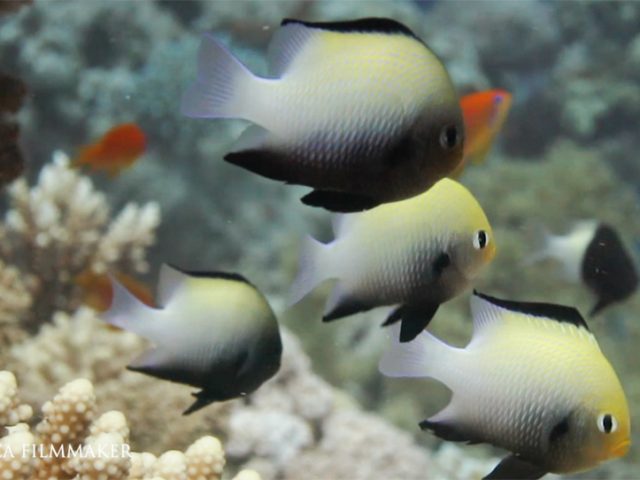
Dascyllus marginatus (marginate dascyllus or Red Sea dascyllus) is a damselfish from the Western Indian Ocean, Red Sea and the Gulf of Oman. Its common size is 5 centimetres. Adults are usually associated with the corals Stylophora pistillata, Stylophora wehisi, species of Acropora and Porites. Monogamous, oviparous; eggs are demersal and adhere to the substrate, males guard and aerate the eggs. (Wikipedia)
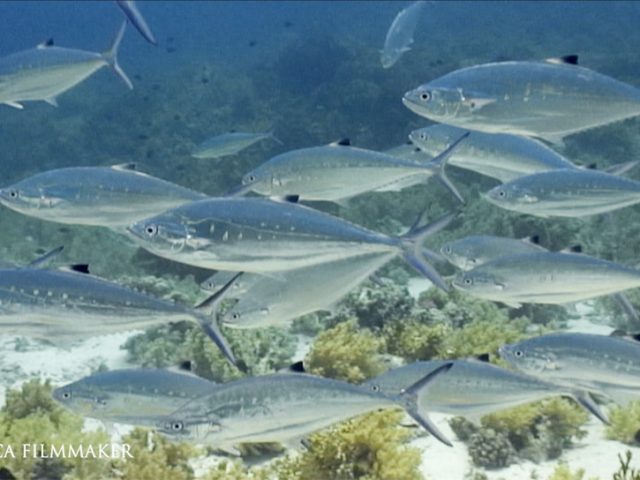
The doublespotted queenfish (Scomberoides lysan) is a tropical game fish in family Carangidae (jacks). It is associated with reefs and ranges widely throughout the Indian and Pacific Oceans. Other common names for this fish are giant dart, large-mouthed leatherskin, leatherskin, queenfish, skinny fish. They are known to reach up to 110 cm total length and mass up to 11.0 kg (24 lb.), primarily silver in color, with dark coloration on the dorsal and caudal fins and a row of dark spots on either side of the lateral line. Scales needle-like and embedded in tough skin; breast scales sharply lanceolate and embedded on middle of body below lateral line but lack the scutes of some other jacks. This species ranges eastward from the Red Sea and eastern Africa to Hawaii, the Marquesas, and the Tuamotu Islands. It is found as far north as southern Japan and south to New South Wales and Rapa Iti. It occupies relatively clear waters from the surface to about 100 m (330 ft.); juveniles inhabit shallow water near the shore, including brackish areas. Adults prey on fish and crustaceans. This species is venomous with the venom found on the spines of the dorsal and anal fins. (Wikipedia)
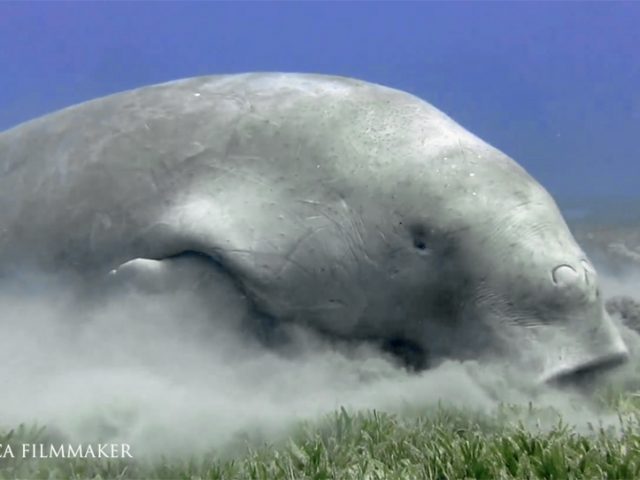
The dugong (Dugong dugon) is a medium-sized marine mammal. It is one of four living species of the order Sirenia, which also includes three species of manatees. It is the only living representative of the once-diverse family Dugongidae. The dugong is largely dependent on seagrass communities for subsistence and is thus restricted to the coastal habitats which support seagrass meadows, with the largest dugong concentrations typically occurring in wide, shallow, protected areas such as bays, mangrove channels, the waters of large inshore islands and inter-reefal waters. It is easily distinguished from the manatees by its fluked, dolphin-like tail, but also possesses a unique skull and teeth. The dugong has been hunted for thousands of years for its meat and oil. Traditional hunting still has great cultural significance in several countries in its modern range, particularly northern Australia and the Pacific Islands ; with its long lifespan of 70 years or more, and slow rate of reproduction, it is especially vulnerable to extinction. (Wikipedia)
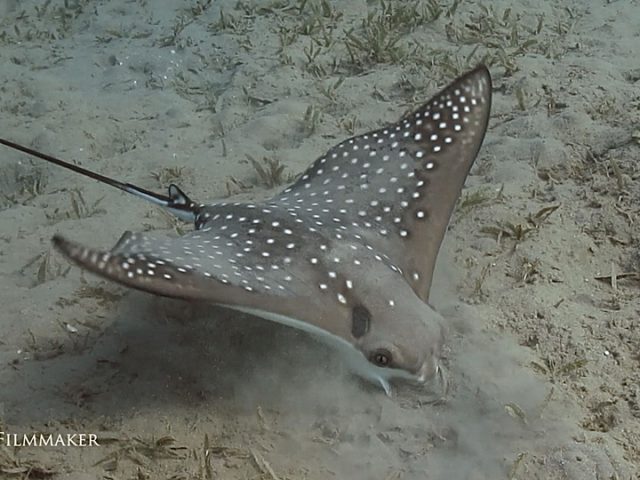
The "Eagle Rays" are a group of cartilaginous fish in the family "Myliobatidae", consisting mostly of large species living in the open ocean rather than on the sea bottom. Eagle rays feed on mollusks and crustaceans, crushing their shells with their flattened teeth. They are excellent swimmers and are able to breach the water up to several metres above the surface. Compared with other rays, they have long tails, and well-defined, rhomboidal bodies. They are ovoviviparous, giving birth to up to six young at a time. They range from 0.48 to 9.1 m (1.6 to 29.9 ft) in length. Eagle rays live close to the coast in depths of 1 to 30 m (3 to 98 ft) and in exceptional cases they are found as deep as 300 m (980 ft). It is most commonly seen cruising along sandy beaches in very shallow waters, its two wings sometimes breaking the surface and giving the impression of two sharks traveling together. (Wikipedia)
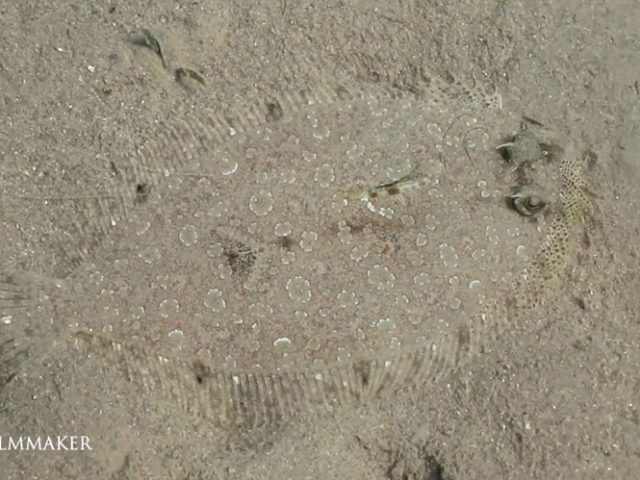
“Sole" is a fish belonging to several families. Generally speaking, they are members of the family “Soleidae", but, outside Europe, the name sole is also applied to various other similar flatfish, especially other members of the sole suborder Soleoidei as well as members of the flounder family. The "Egyptian Sole" (Solea aegyptiaca) lives on the sandy or muddy seabed of the Mediterranean Sea and is now colonising the Red Sea. It often semi-immerses itself in the substrate. The upper side is greyish-brown while the underside is white. It grows to a maximum length of about 70 cm (28 in). The small eyes are close to each other on the right side of the body. This gives the fish the possibility of lurking half-buried in the sand for passing prey. (Wikipedia)
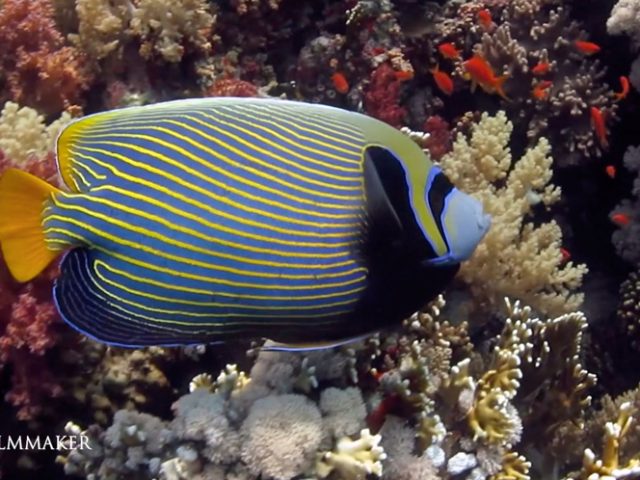
The “Emperor Angelfish" (Pomacanthus imperator) is a species of marine angelfish. It is a reef-associated fish, native to the Indian and Pacific Oceans, from the Red Sea to Hawaii and the Austral Islands; this species is generally associated with stable populations and faces no major threats of extinction. It dwells in reef-associated areas at depths ranging from 1–100 m. Emperor angelfish is omnivorous, feeding on both small invertebrates and plants, sponges and algae make up its primary diet; the fish has bulky, strong jaws for chewing up the sponges, which are made up of tiny, needle-like pieces of silica. Adults have yellow and blue stripes, its size is about 40 cm (15.75 in) in length. (Wikipedia)
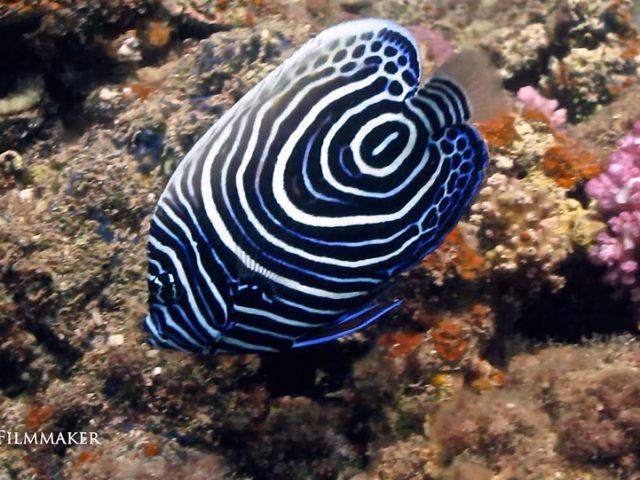
“Emperor Angelfish Juveniles" (Pomacanthus imperator) is a species of marine angelfish. It's a reef-associated fish, native to the Indian and Pacific Oceans, from the Red Sea to Hawaii and the Austral Islands. Emperor Angelfish Juveniles are dark blue with electric blue and white rings; adults have yellow and blue stripes, with black around the eyes. It takes about 24 to 30 months for an emperor angelfish to acquire its adult coloring; full adult size is about 40 cm (15.75 in) in length. They act as cleaner fish feeding off parasites and dead skin of larger fish species. Subadults move to reef front holes and surge channels, while mature adults are found in caves in areas of rich coral growth on clear lagoon, seaward, or channel reefs. (Wikipedia
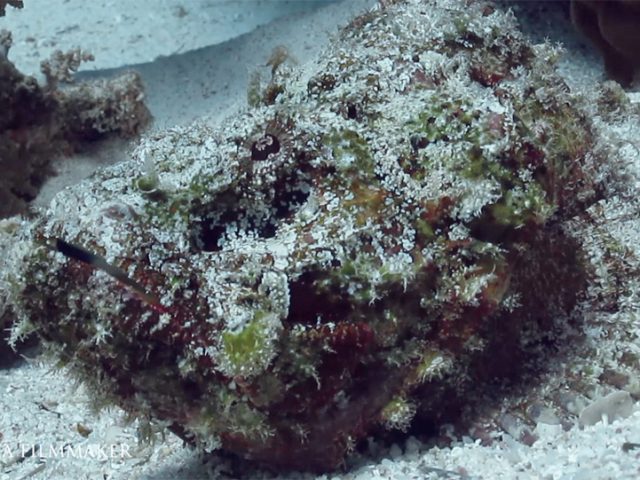
Scorpaenopsis diabolus, the false stonefish is a carnivorous ray-finned fish in the order Scorpaeniformes, the scorpionfish and flatheads. It has venomous spines and lives in the tropical Indian and Pacific Oceans. It is a bottom-dwelling predator that relies on its camouflage to catch passing prey. The false stonefish has a broad head with a wide mouth, a humped back, a tapering body and can reach 30 cm (12 in) in length. Its dorsal fin has 12 venomous spines and eight to 10 soft rays. The anal fin has three spines and five to six soft rays. The skin is rough with low conical projections, spines and tassels. The colouring is a combination of mottled grey and white with reddish-brown blotches and the fish is well-camouflaged among stones and corals. It is found on the seabed among rubble, seaweed-covered rocks or on rocks encrusted with coralline algae on reef flats, lagoons and the seaward side of reefs. Its range extends from South and East Africa and the Red Sea to Japan, Hawaii, French Polynesia, Australia and New Caledonia. (Wikipedia)
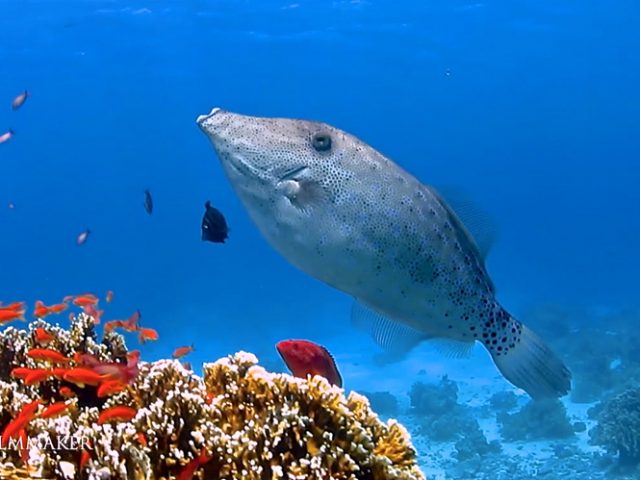
The “Filefish" (Monacanthidae) are a diverse family of tropical to subtropical tetraodontiform marine fish, which are also known as “Foolfish”, “Leatherjackets" or “Shingles". They live in the Atlantic, Pacific and Indian Oceans. Filefish are closely related to the triggerfish, pufferfish and trunkfish. Their laterally compressed bodies and rough, sandpapery skin inspired the filefish's common name. Appearing very much like their close relatives the triggerfish, filefish are rhomboid-shaped fish that have beautifully elaborate cryptic patterns. Deeply keeled bodies give a false impression of size when these fish are viewed facing the flanks. Filefish have soft, simple fins with comparatively small pectoral fins and truncated, fan-shaped tail fins; a slender, retractable spine crowns the head. The small terminal mouths of filefish have specialized incisor teeth on the upper and lower jaw; in the upper jaw there are four teeth in the inner series and six in the outer series; in the lower jaw, there are 4-6 in an outer series only. The snout is tapered and projecting; eyes are located high on the head. Adult filefish are generally shallow water fish, inhabiting depths of no more than about 30 metres. They may be found in lagoons or associated with seaward reefs and seagrass beds. Either solitary, in pairs or small groups depending on the species, filefish are not terribly good swimmers. The feeding habits of filefish vary among the species, with some eating only algae and seagrass; others also eat small benthic invertebrates, such as tunicates, gorgonians, and hydrozoans; and some species eat corals. The largest filefish species is the scrawled filefish (Aluterus scriptus) at up to 110 cm (43 in) in length; most species are below 60 cm (24 in) in length. (Wikipedia)
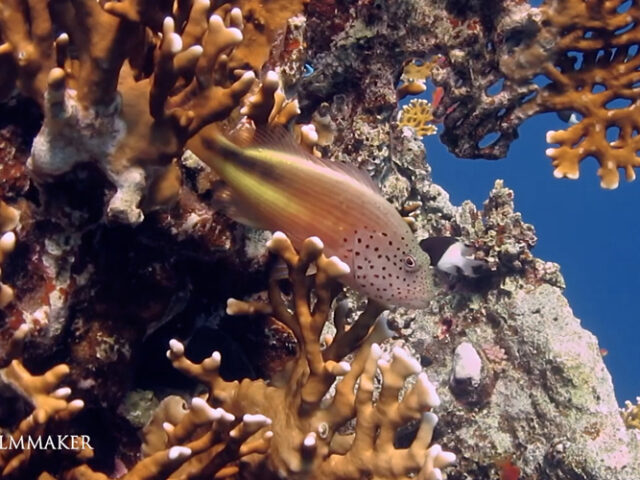
The black-sided hawkfish, freckled hawkfish or Forster's hawkfish (Paracirrhites forsteri), is a species of hawkfish from the Indo-Pacific; Its range extends from East Africa and the Red Sea to Japan, New Caledonia and Australasia. The hawkfish reaches to a maximum total length of about 22 cm (9 in). The dorsal fin has ten spines and eleven soft rays. There is considerable variation in the colouring both among adults and as a result of changes during growth; the main colour is usually yellowish but there is a broad black or dark brown lateral band, mainly on the rear half of the body. The sides of the head and the front of the body are whitish or grey with red speckles. Forster’s hawkfish is found on the seaward side of reefs and on soft-bottomed lagoons to depths of 30 m (100 ft) and more; it is an ambush predator; it usually lies in wait on a head of coral, propped up by its stiff pectoral fins, ready to dart out at passing crustaceans or small fish. It is mainly a solitary fish. (Wikipedia)
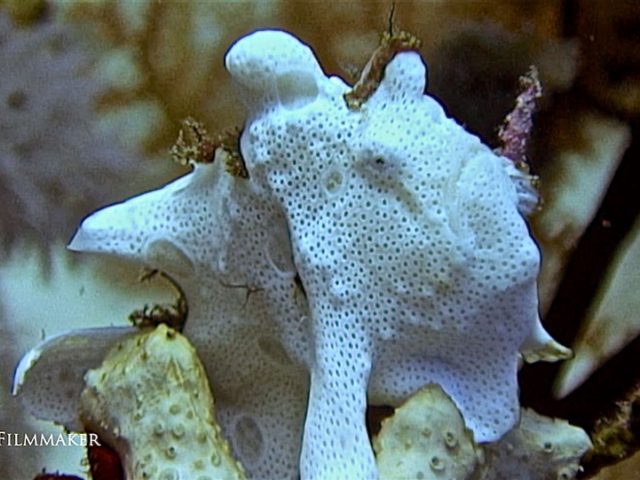
“Frogfish" are any member of the anglerfish family Antennariidae, of the order Lophiiformes. They are found in almost all tropical and subtropical oceans and seas around the world, the primary exception being the Mediterranean Sea. Frogfishes are small, short and stocky, and sometimes covered in spinules and other appendages to aid in camouflage. The camouflage aids in protection from predators and enables them to lure prey. Many species can change colour; some are covered with other organisms such as algae or hydrozoa. In keeping with this camouflage, frogfishes typically move slowly, lying in wait for prey, and then striking extremely rapidly, in as little as 6 milliseconds. Frogfishes generally do not move very much, preferring to lie on the sea floor and wait for prey to approach. Once the prey is spotted, they can approach slowly using their pectoral and pelvic fins to walk along the floor. (Wikipedia)
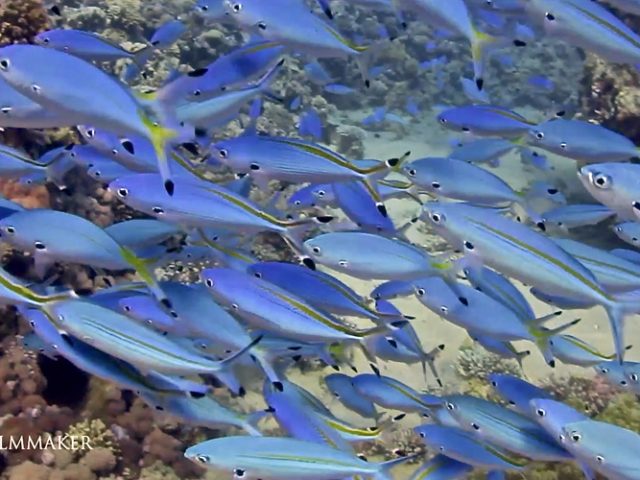
The “Fusiliers" are a family, “Caesionidae", of fish in the order “Perciformes". The family includes about 23 species. They are related to the snappers, but adapted for feeding on plankton, rather than on larger prey. They are found at reefs in the Indo-Pacific. They are cylindrical, streamlined fish, of up to 60 cm (24 in), though most species only reach about half that length. Their upper jaws are extensible, and adapted for picking plankton. (Wikipedia)
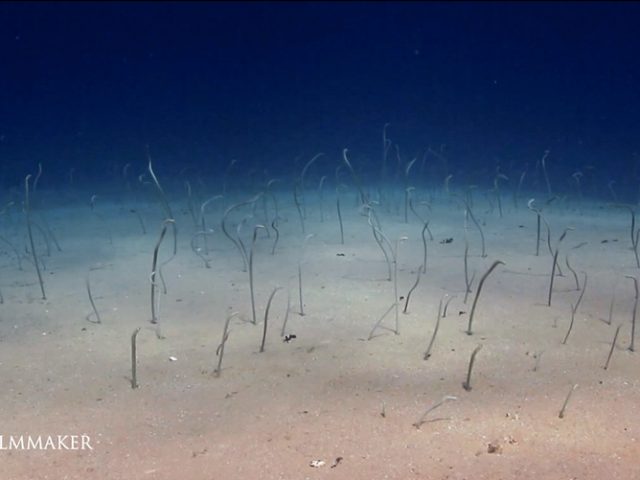
The “Garden Eels" are the subfamily “Heterocongrinae" in the conger eel family Congridae. The majority of garden eels live in the Indo-Pacific, Red Sea, but species are also found in warmer parts of the Atlantic Ocean (including the Caribbean) and East Pacific. These small eels live in burrows on the sea floor and get their name from their practice of poking their heads from their burrows while most of their bodies remain hidden. Since they tend to live in groups, the many eel heads "growing" from the sea floor resemble the plants in a garden. They vary greatly in colour depending on the exact species involved. The largest species reaches about 120 cm (47 in) in length, but most species do not surpass 60 cm (24 in).
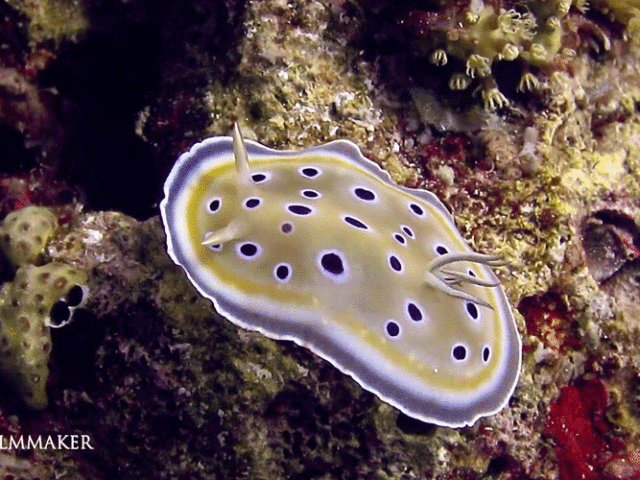
Also known as Geniobranchus Geminus, is a species of very colorful sea slug, a dorid nudibranch, a marine gastropod mollusc in the family Chromodorididae. It can reach a maximum size of 5 cm in length. It has four distinctive coloured lines around the mantle edge. Starting from a thin white outer line, then a light grayish line, followed by another white line and finally a bright golden yellow line. The background coloration from the back is light brown to yellowish speckled with mauve ocelli circled with a white margin. The foot, clearer and with a white margin, also has ocelli. The rhinophores are yellow or purple and laminated, gills are white outlined with beige. This sea slug lives in the Indian Ocean from Kenya to Sri Lanka and in the Red Sea and has a predilection for the external slopes of coral reefs. (Wikipedia)

“Solenostomus", also known as “Ghost Pipefish”, “False Pipefish" or "Tubemouth Fish", is a genus of fish in the order “Syngnathiformes". Solenostomus is the only genus in the family “Solenostomidae", and includes six currently recognized species. Ghostpipefish are related to “Pipefishesand Seahorses”. They are found in tropical waters of the Indo-Pacific, Red Sea. The animals, none of which are longer than 15 centimetres (5.9 in), float near motionlessly, with the mouth facing downwards, around a background that makes them nearly impossible to see. They feed on tiny crustaceans, sucked inside through their long snout. They live in open waters except during breeding, when they find a coral reef or muddy bottom, changing color and shape to minimize visibility. In many respects, they are similar to the pipefishes, but can be distinguished by the presence of pelvic fins, a prominent, spiny, dorsal fin, and star-shaped plates on the skin. Unlike true pipefish, female ghostpipefish use their enlarged pelvic fins to brood their eggs until they hatch. (Wikipedia)
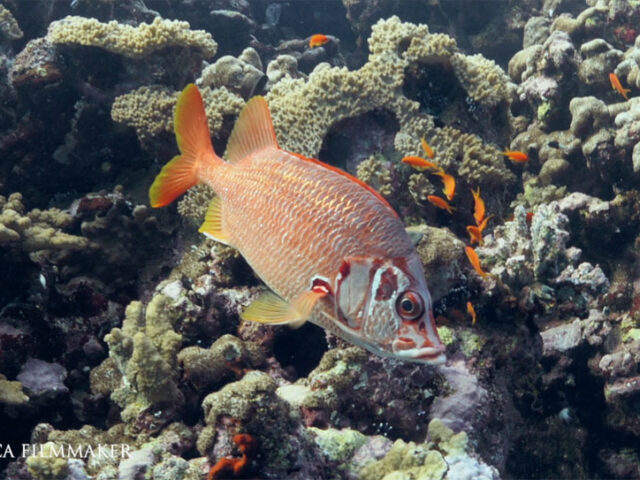
Sargocentron spiniferum, common name sabre squirrelfish, giant squirrelfish and spiny squirrelfish, is a large Indo-Pacific species of squirrelfish belonging to the family Holocentridae. The body is oval and laterally compressed. The head has a pointed snout and large eyes, being largely nocturnal. The basic colour is bright red. It has silver scale margins, a spinous dorsal fin and a large deep red patch just behind the eyes. The lower jaw protrudes beyond the upper jaw. It bears a very long preopercle spine (near the gill-opening). This species is widespread throughout the tropical Indo-Pacific, from the Red Sea and Indian Ocean up to Hawaii, Japan and southern Australia. It can be found in tropical waters on coral reefs, from shallow water to a depth of 120 m (390 ft). (Wikipedia)
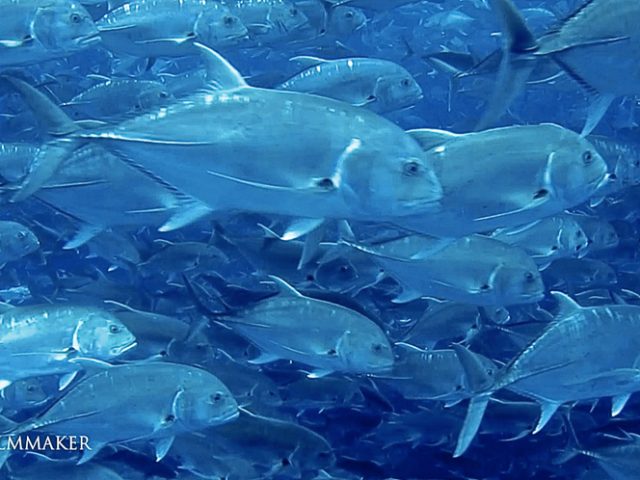
The “Giant Trevally" (Caranx ignobilis), also known as the “Lowly Trevally”, “Barrier Trevally”, “Giant Kingfish" or “Ulua", is a species of large marine fish classified in the jack family, Carangidae. The giant trevally is distributed throughout the tropical waters of the Indo-Pacific region, with a range stretching from South Africa in the west to Hawaii in the east, including Japan in the north and Australia in the south. Two were documented in the eastern tropical Pacific in the 2010s (one captured off Panama and another sighted at the Galápagos), but it remains to be seen if the species will become established there. The giant trevally is distinguished by its steep head profile, strong tail scutes, and a variety of other more detailed anatomical features. It is normally a silvery colour with occasional dark spots, but males may be black once they mature. It is the largest fish in the genus Caranx, growing to a maximum known size of 170 cm (67 in) and a weight of 80 kg (176 lbs). The giant trevally inhabits a wide range of marine environments, from estuaries, shallow bays and lagoons as a juvenile to deeper reefs, offshore atolls and large embayments as an adult. It is an apex predator in most of its habitats, and is known to hunt individually and in schools. The species predominantly takes various fish as prey, although crustaceans, cephalopods and molluscs make up a considerable part of their diets in some regions. (Wikipedia)
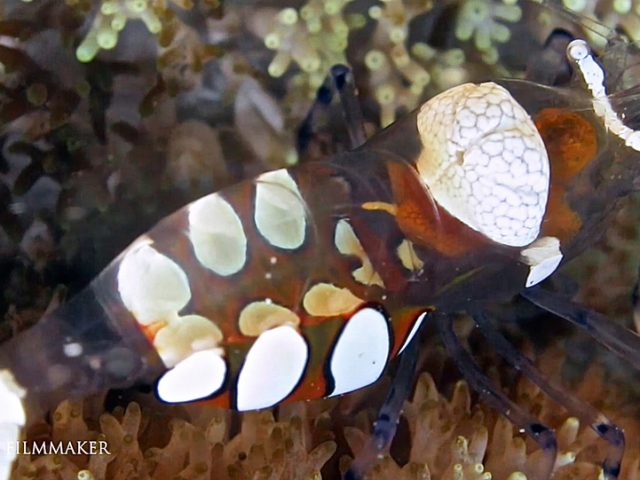
"Periclimenes brevicarpalis", the "Glass Anemone Shrimp" or "Peacock-Tail Anemone Shrimp", is a species of shrimp belonging to the family Palaemonidae. Periclimenes brevicarpalis can reach a length of 0.5 to 1.0 inch. The body is almost transparent, with some white spots over carapace and tail and orange spots outlined in black over the caudal fin. Females are larger than males and have more white spots. This species lives symbiotically with sea anemones, corals and jelly fish. This species can be found in the tropical Pacific and Indian Oceans, Red Sea, including Australia. (Wikipedia)
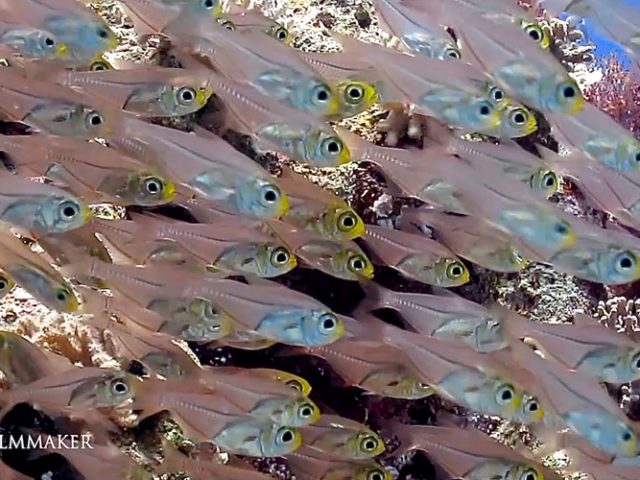
“Dwarf Sweepers" are small, tropical marine (occasionally brackish) perciform fish of the family “Pempheridae". Found in the western Atlantic Ocean and Indo-Pacific region, the family contains about 26 species in two genera. Deeply keeled, compressed bodies and large eyes typify sweepers, their form somewhat like hatchetfish; both cycloid and ctenoid scales may be present. The small, short dorsal fin begins before the body's midpoint and may have four to seven spines; the anal fin is extensive and usually has three spines. The mouth is subterminal and strongly oblique. Species of the genus Parapriacanthus have much more cylindrical bodies. Some species possess photophores. All but the curved sweeper (Pempheris poeyi) possess a gas bladder. Colouration is relatively subdued. Characteristically shallow water, schooling fish (especially as juveniles), sweepers are nocturnal and seek shelter under ledges or in the caves, nooks, and crannies of reefs or eroded, rocky shorelines during the day. They are often found sharing these hiding places with cardinalfishes and bigeyes, also nocturnal species. At night, sweepers forage for zooplankton, their primary food. (Wikipedia)
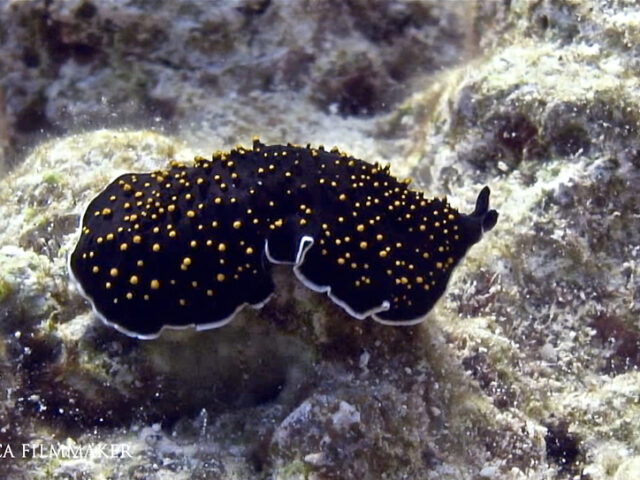
Thysanozoon nigropapillosum is a species of polyclad flatworms belonging to the family Pseudocerotidae. Some common names include gold-speckled flatworm, marine flatworm, yellow papillae flatworm, yellow-spotted flatworm and yellow-spotted polyclad flatworm. This species is widespread in the tropical Indo-Pacific. The dorsal surface is deep black and covered with numerous yellow-tipped papillae varying in size; the ventral surface is dark brown; the outer margin of the body is slightly wavy and bordered in opaque white. They have small ear-like pseudotentacles in the middle of the anterior end. The flatworms swim by propelling themselves through the water with a rhythmic undulating motion of the body. (Wikipedia)
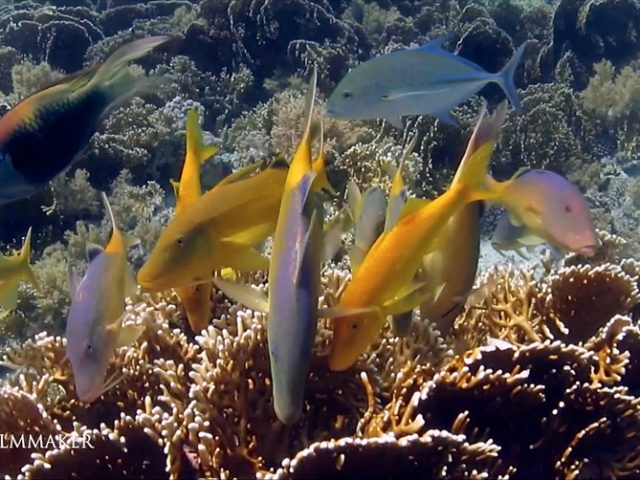
“Goldsaddle Goatfish" or “Yellowsaddle Goatfish", "Parupeneus Cyclostomus", is a species of goatfish native to the Indo-Pacific. This fish is usually colored yellow with a bluish sheen to the dorsal part, but with a golden yellow variant. It can reach 50 cm (20 in) in total length, though most do not exceed 35 cm (14 in). It occurs solitarily or in groups, in all areas of the coral reefs and detrital bottom area from 1 to 95 m deep. It uses its barbels to probe holes and force out prey. It is found in the Indo-Pacific from the Red Sea to South Africa, the Hawaiian Islands, and the Ryukyu Islands. (Wikipedia)
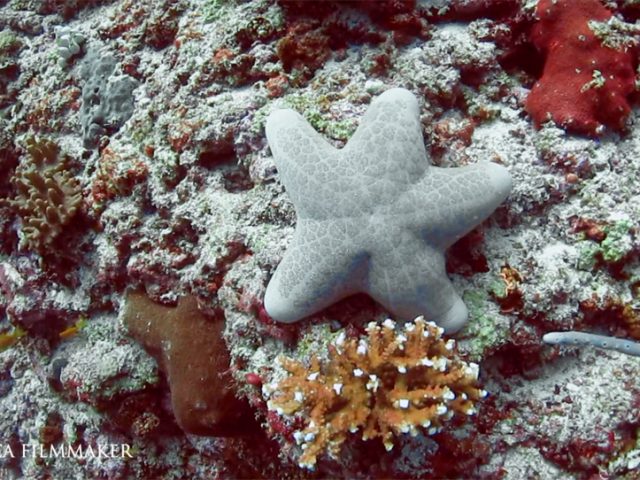
Choriaster is monotypic genus in the family Oreasteridae containing the single species Choriaster granulatus commonly known as the granulated sea star. Other common names include big-plated sea star and doughboy starfish. Choriaster granulatus is a large sea star with a convex body and five short arms. The maximum growth radius is about 27 cm. It is a pale pink color with brown papillae in the center. It has been found individually or in groups in the Indo-West Pacific region along coral reefs; It has also been found in the Red Sea, Fiji and Great Barrier Reef. Granulated Sea Star prefers shallow waters, it is a carnivore and has its mouth on the underside of its body, like other sea stars. Their prey is absorbed outside their mouths by forcing out their digestive organs from their stomach; Its prey include carrion and small invertebrates such as coral polyps. (Wikipedia)
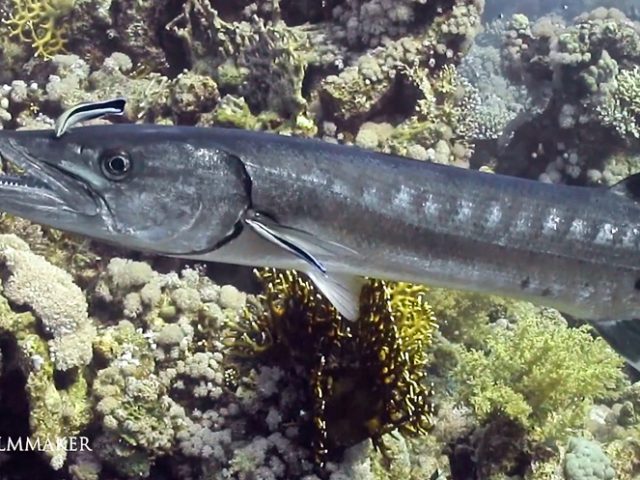
The “Great Barracuda" (Sphyraena barracuda) also known as the “Giant Barracuda", is a common species of barracuda found in subtropical oceans around the world; it is present in tropical to warm temperate waters, in subtropical parts of the Indian, Pacific and Atlantic oceans, from mangrove areas to deep reef, with a lower depth limit of 110 meters. Great barracudas are large fish. Mature specimens are usually around 60–100 cm (24–39 in) in length and weigh 2.5–9.0 kg (5.5–19.8 lb). Exceptionally large specimens can exceed 1.5 m (4.9 ft) and weigh over 23 kg (51 lb). The record-sized specimen caught on rod-and-reel weighed 46.72 kg (103.0 lb) and measured 1.7 m (5.6 ft), while an even bigger specimen measured 2 m (6.6 ft). Great barracuda's coloration is blue-gray above, fading to silvery and chalky-white below. In general, barracudas are elongated fish with powerful jaws. The diets of these top predators of reefs are composed almost totally of fish of all kinds, of cephalopods, and occasionally of shrimps. Large barracudas, when gorged, may attempt to herd a school of prey fish in shallow water where they guard over them until they are ready for another hunt. (Wikipedia)
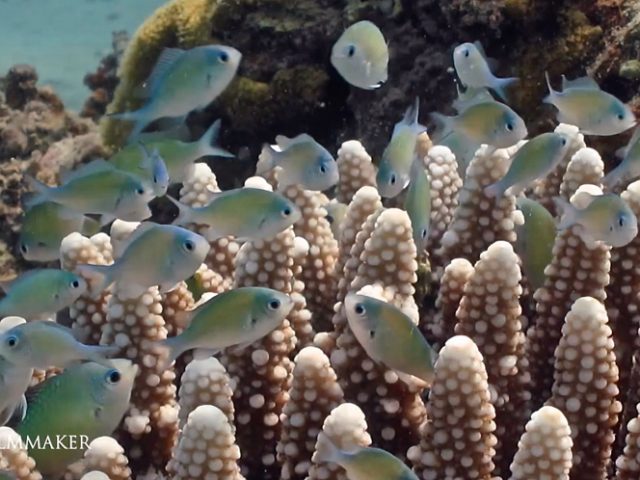
"Chromis Viridis" is a species of damselfish. Individuals tend to be iridescent apple-green and light blue, and reach a maximal length of 10 cm. it is sometimes called the “Blue-Green Chromis", but that may also refer to Chromis caerulea, the blue puller, a close relative that is sometimes considered conspecific. The species is found in the Indo-Pacific, including the Red Sea. It is found in tropical and subtropical waters. In the Indian Ocean, eastern Africa, Madagascar, Seychelles, the Persian Gulf, the Arabian Sea, the Maldives, Sri Lanka, the Andaman Sea, Australia, and Indonesia. In the Pacific Ocean, they are found in the Gulf of Thailand, Indonesia, the Philippines, China, Taiwan, Japan, the Great Barrier Reef, New Zealand, New Caledonia, Polynesia, Melanesia, and Hawaii in the Indo-Pacific part of the Pacific Ocean. In the eastern Pacific Ocean, they are found from the Gulf of California south to Peru and the Galapagos Islands. There are some reports of this species in the Mediterranean Sea. They live in coral reefs and lagoons. Individuals of this species are encountered in depths of 1 to 12 metres (3.3 to 39.4 ft). They have 12 dorsal rays, 9 to 11 soft dorsal rays, 2 anal spines, and 9 to 11 anal soft rays on their fins. It is a blue green fish. When they are breeding, males turn more yellowish. Phytoplankton, zooplankton, and algae, copepods, Artemia and amphipods make up the diet of this fish in the wild. This fish also feeds on eggs that fail to hatch. It feeds by ram jawing. The green chromis is not housed with larger predatory fish, as they may become food themselves. Groupers, lionfish, and eels all present an element of danger for this species. They live in aggregations around Acropora coral heads. (Wikipedia)
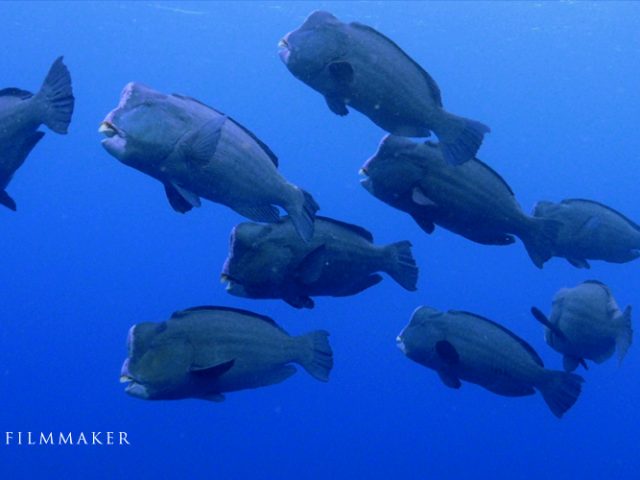
The green humphead parrotfish (Bolbometopon muricatum) is the largest species of parrotfish, growing to lengths of 1.5 m (4.9 ft) and weighing up to 75 kg (165 lb). Other common names include bumphead parrotfish, humphead parrotfish, double-headed parrotfish, buffalo parrotfish and giant parrotfish. It is found on reefs in the Indian and Pacific Oceans, from the Red Sea in the west to Samoa in the east, and from the Yaeyama Islands in the north to the Great Barrier Reef, Australia, in the south. Unlike wrasses, it has a vertical head profile, and unlike other parrotfishes, it is uniformly covered with scales except for the leading edge of the head, which is often light green to pink. The adult develops a bulbous forehead and the teeth plates are exposed, being only partly covered by lips. The species is slow-growing and long-lived (up to 40 years), with delayed reproduction and low replenishment rates. This species is gregarious and usually occurs in small aggregations, but group size can be quite large on seaward and clear outer lagoon reefs, exceeding 75 individuals. (Wikipedia)
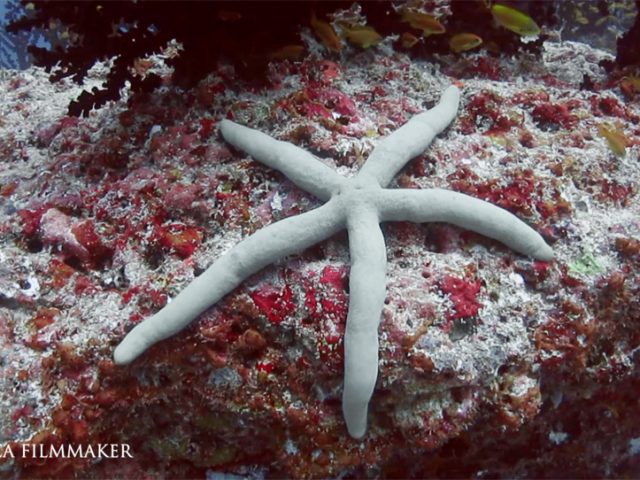
Linckia guildingi, also called the common comet star, Guilding's sea star or the green Linckia, is a species of sea star found in the shallow waters of the tropical Pacific Ocean, Indian Ocean, Atlantic Ocean and the Caribbean Sea. It has a small disc and usually 5 (occasionally 4 or 6) long cylindrical arms. The upper surface appears smooth but is in fact rough to the touch with low, firm nodules. Though this starfish is often green, it comes in a range of colours including various shades of brown, blue and dull red. (Wikipedia)
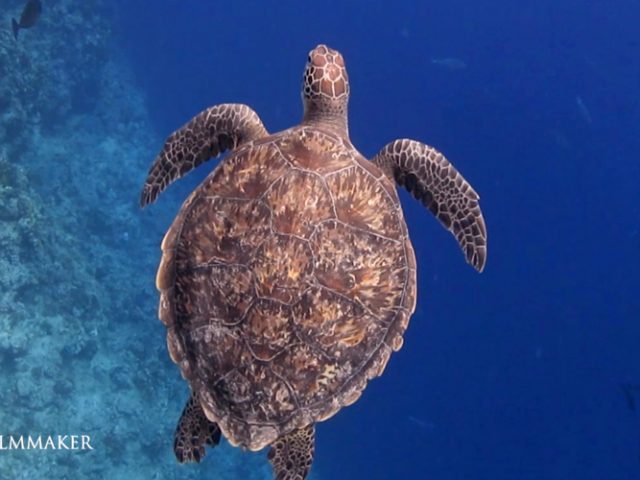
The "Green Sea Turtle" (Chelonia mydas), also known as the “Green Turtle”, "Black (sea) Turtle" or "Pacific Green Turtle", is a large sea turtle of the family “Cheloniidae". Its range extends throughout tropical and subtropical seas around the world, with two distinct populations in the Atlantic and Pacific Oceans, but it is also found in the Indian Ocean and Red Sea. This sea turtle's dorsoventrally flattened body is covered by a large, teardrop-shaped carapace; it has a pair of large, paddle-like flippers. It is usually lightly colored, although in the eastern Pacific populations parts of the carapace can be almost black. Like other sea turtles, green sea turtles migrate long distances between feeding grounds and hatching beaches. Many islands worldwide are known as Turtle Island due to green sea turtles nesting on their beaches. Females crawl out on beaches, dig nests and lay eggs during the night. Later, hatchlings emerge and scramble into the water. Those that reach maturity may live to 80 years in the wild. Green Sea Turtles move across three habitat types, depending on their life stage. They lay eggs on beaches. Mature turtles spend most of their time in shallow, coastal waters with lush seagrass beds. Adults frequent inshore bays, lagoons and shoals with lush seagrass meadows. Entire generations often migrate between one pair of feeding and nesting areas. The diet of green turtles changes with age, juveniles are carnivorous, but as they mature they become omnivorous, the young eat fish eggs, molluscs, jellyfish, small invertebrates, worms, sponges, algae, and crustaceans. Most adult sea turtles are strictly herbivorous. They migrate long distances between feeding sites and nesting sites; some swim more than 2,600 kilometres (1,600 mi) to reach their spawning grounds. (Wikipedia)
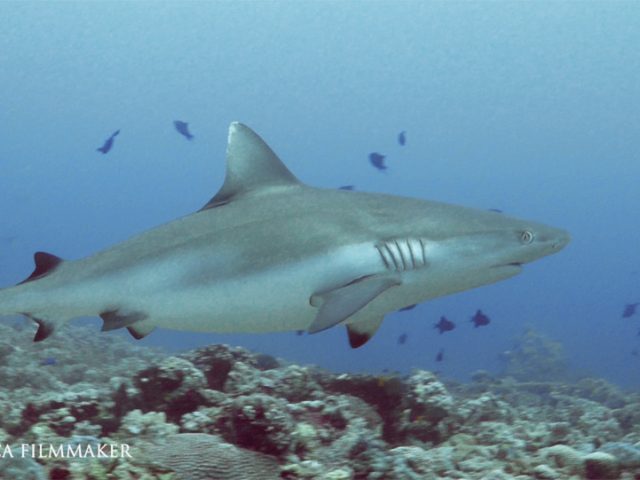
The “Grey Reef Shark" (Carcharhinus amblyrhynchos, sometimes misspelled amblyrhynchus or amblyrhinchos) is a species of requiem shark, in the family Carcharhinidae. One of the most common reef sharks in the Indo-Pacific, it is found as far east as Easter Island and as far west as South Africa. This species is most often seen in shallow water near the drop-offs of coral reefs. The grey reef shark has the typical "reef shark" shape, with a broad, round snout and large eyes. This species can be distinguished from similar species by the plain or white-tipped first dorsal fin, the dark tips on the other fins, the broad, black rear margin on the tail fin, and the lack of a ridge between the dorsal fins. Most individuals are less than 1.9 m (6.2 ft) long. Grey reef sharks are fast-swimming, agile predators that feed primarily on free-swimming bony fish and cephalopods. Their aggressive demeanor enables them to dominate many other shark species on the reef, despite their moderate size. Many grey reef sharks have a home range on a specific area of the reef, to which they continually return. However, they are social rather than territorial. During the day, these sharks often form groups of five to 20 individuals near coral reef drop-offs, splitting up in the evening as the sharks begin to hunt. Adult females also form groups in very shallow water, where the higher water temperature may accelerate their growth or that of their unborn young. Like other members of its family, the grey reef shark is viviparous, meaning the mother nourishes her embryos through a placental connection. Litters of one to six pups are born every other year. Grey reef sharks feed also squid and octopus being the second-most important food group, and crustaceans such as crabs and lobsters making up the remainder. These sharks hunt individually or in groups, and have been known to pin schools of fish against the outer walls of coral reefs for feeding. (Wikipedia)
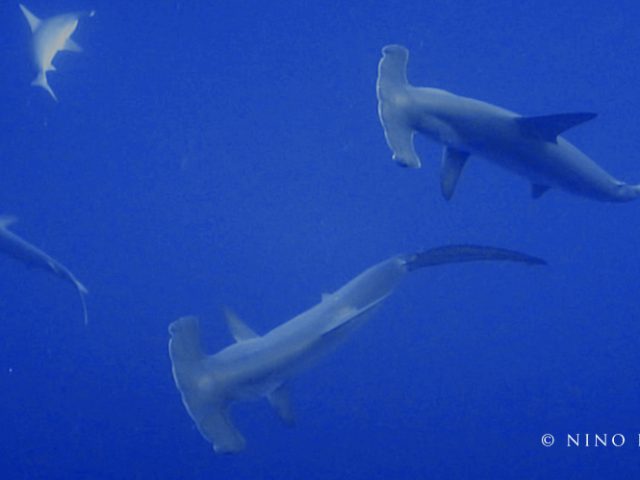
The “Hammerhead Sharks" are a group of sharks in the family “Sphyrnidae", so named for the unusual and distinctive structure of their heads, which are flattened and laterally extended into a "hammer" shape called a cephalofoil. Most hammerhead species are placed in the genus “Sphyrna", while the winghead shark is placed in its own genus, “Eusphyra". Many, but not necessarily mutually exclusive, functions have been proposed for the cephalofoil, including sensory reception, manoeuvering, and prey manipulation. Hammerheads are found worldwide in warmer waters along coastlines and continental shelves. Unlike most sharks, hammerheads usually swim in schools during the day, becoming solitary hunters at night. Some of these schools can be found near Malpelo Island in Colombia, the Galapagos Islands in Ecuador, Cocos Island off Costa Rica and near Molokai in Hawaii. Large schools are also seen in the waters off southern and eastern Africa and in the Red Sea. Hammerhead sharks are known to eat a large range of prey such as fish (including other sharks), squid, octopus, and crustaceans. Stingrays are a particular favorite. These sharks are often found swimming along the bottom of the ocean, stalking their prey. Their unique heads are used as a weapon when hunting down prey. The hammerhead shark uses its head to pin down stingrays and eats the ray when the ray is weak and in shock. The great hammerhead, tending to be larger and more aggressive than most hammerheads. (Wikipedia)
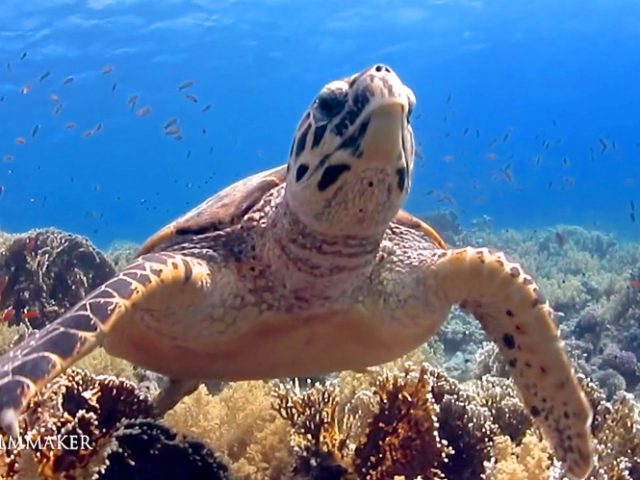
The "Hawksbill Sea Turtle" (Eretmochelys imbricata) is a critically endangered sea turtle belonging to the family “Cheloniidae". It is the only extant species in the genus “Eretmochelys". The species has a worldwide distribution, with Atlantic and Indo-Pacific subspecies. The hawksbill's appearance is similar to that of other marine turtles. In general, it has a flattened body shape, a protective carapace, and flipper-like limbs, adapted for swimming in the open ocean. Adult hawksbill sea turtles typically grow to 1 m (3 ft) in length, weighing around 80 kg (180 lb) on average. It is easily distinguished from other sea turtles by its sharp, curving beak with prominent tomium, and the saw-like appearance of its shell margins. Hawksbill shells slightly change colors, depending on water temperature. While this turtle lives part of its life in the open ocean, it spends more time in shallow lagoons and coral reefs. While they are omnivorous, sea sponges are their principal food; they constitute 70–95% of the turtles' diets. The World Conservation Union, primarily as a result of Human fishing practices, classifies E. imbricata as critically endangered. Hawksbill shells were the primary source of tortoiseshell material used for decorative purposes. The Convention on International Trade in Endangered Species outlaws the capture and trade of hawksbill sea turtles and products derived from them. (Wikipedia)
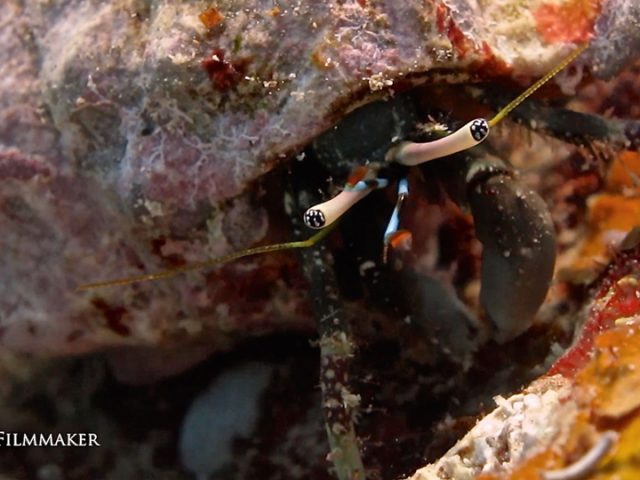
"Hermit crabs" are decapod crustaceans of the superfamily “Paguroidea". Most of the approximately 1,110 species possess an asymmetrical abdomen that is concealed in a scavenged mollusc shell carried around by the hermit crab. They can be divided into two groups: the first group is the marine hermit crabs, they spend most of their life underwater as aquatic animals, live in varying depths of saltwater from shallow reefs and shorelines to deep sea bottoms. The second group, the land hermit crabs, spend most of their life on land as terrestrial species in tropical areas, though even they require access to both freshwater and saltwater to keep their gills damp or wet to survive and to reproduce. (Wikipedia)
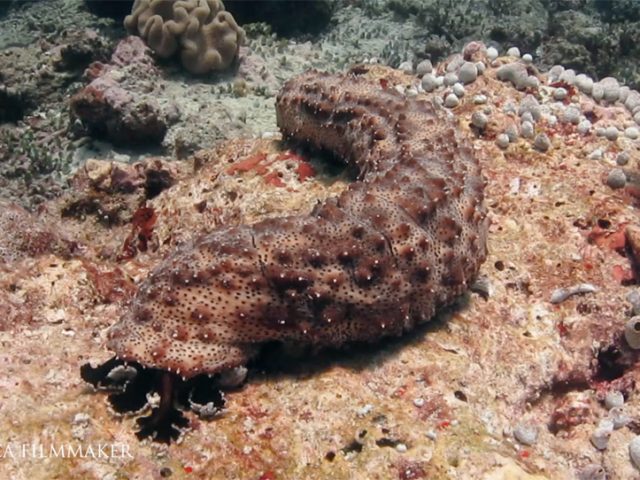
Holothuria is the type genus of the marine animal family Holothuriidae, part of the class Holothuroidea, commonly known as sea cucumbers. Members of the genus are found in coastal waters in tropical and temperate regions. They are typically 10 to 30 cm (4 to 12 in) in length. The body ranges from almost spherical to worm-like and lacks the arms found in many other echinoderms, such as starfish. They are soft bodied, limbless invertebrates that dwell on the ocean floor and are usually detritivore. The holothuria resemble a cucumber in form. (Wikipedia)
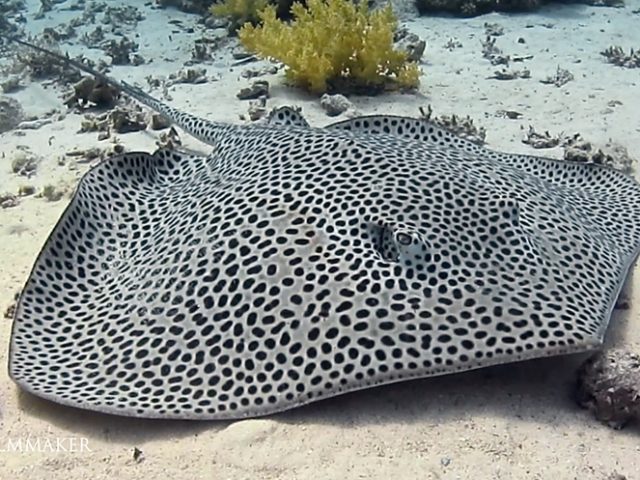
The “Honeycomb Stingray” or “Reticulate Whipray" (Himantura uarnak) is a species of stingray in the family Dasyatidae. It inhabits coastal and brackish waters across the Indo-Pacific region from South Africa to Taiwan to Australia, favoring sandy habitats. A large species reaching 2 m (6.6 ft) in width, the reticulate whipray has a diamond-shaped pectoral fin disc and an extremely long tail without fin folds. Both its common and scientific names refer to its ornate dorsal color pattern of many small, close-set dark spots or reticulations on a lighter background. The pectoral fin disc of the reticulate whipray is diamond-shaped and wider than long, with the leading margins almost straight and the snout and outer corners angular. The eyes are small and immediately followed by the spiracles (paired respiratory openings). A short and wide curtain of skin with a minutely fringed rear margin is present between the long, thin nostrils. The mouth is relatively small, with a deep concavity at the center of the lower jaw and shallow furrows at the corners extending onto the lower jaw. Often encountered resting on the bottom during daytime, the reticulate whipray is a predator of bottom-dwelling invertebrates and bony fish. (Wikipedia)
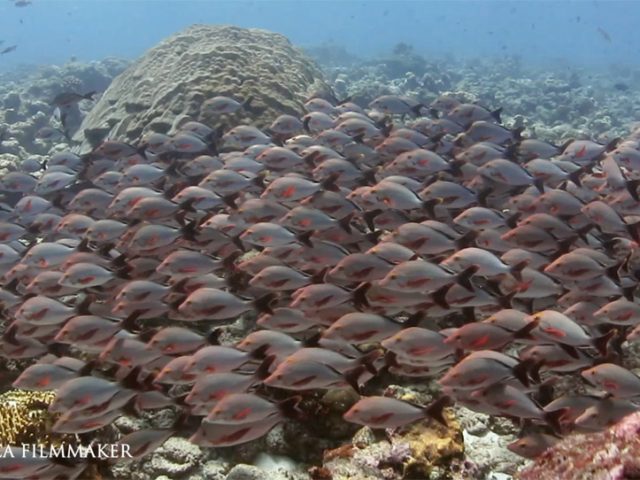
The humpback red snapper or paddletail snapper, Lutjanus gibbus, is a species of snapper native to the Indian Ocean from the coast of Africa and the Red Sea to the western Pacific Ocean. It is mostly an inhabitant of coral reefs at depths of from 1 to 150 m (3.3 to 492.1 ft), with the juveniles being found in beds of seagrass or on sheltered coral reefs and subadults and adults found on sloping substrates. This species can reach a length of 50 cm (20 in). It is a commercially important species, as well as being sought after as a game fish. It is also a popular species for display in public aquaria. Most are active carnivores, feeding on crustaceans or other fish. (Wikipedia)
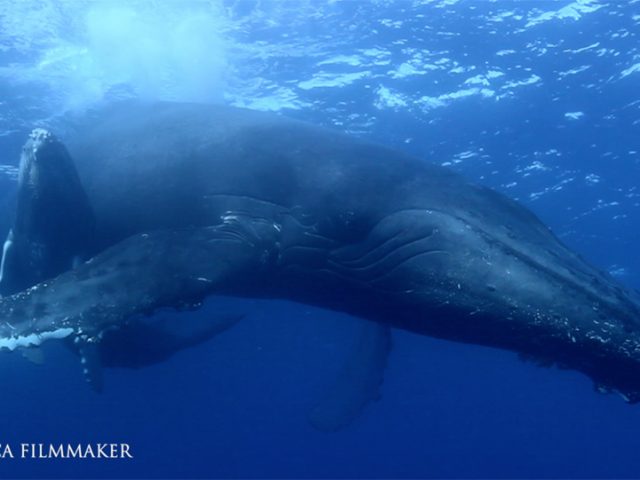
The humpback whale (Megaptera novaeangliae) is a species of baleen whale. It is one of the larger rorqual species, with adults ranging in length from 12–16 m (39–52 ft) and weighing around 25–30 metric tons (28–33 short tons). The humpback has a distinctive body shape, with long pectoral fins and a knobbly head. It is known for breaching and other distinctive surface behaviors, making it popular with whale watchers. Males produce a complex songlasting 10 to 20 minutes, which they repeat for hours at a time. All the males in a group will produce the same song, which is different each season. Its purpose is not clear, though it may help induce estrus in females. Found in oceans and seas around the world, humpback whales typically migrate up to 25,000 km (16,000 mi) each year. They feed in polar waters and migrate to tropical or subtropical waters to breed and give birth, fasting and living off their fat reserves. Their diet consists mostly of krill and small fish. Humpbacks have a diverse repertoire of feeding methods, including the bubble net technique. Like other large whales, the humpback was a target for the whaling industry. The species was once hunted to the brink of extinction; its population fell by an estimated 90% before a 1966 moratorium. While stocks have partially recovered to some 80,000 animals worldwide, entanglement in fishing gear, collisions with ships and noise pollution continue to affect the species. (Wikipedia)
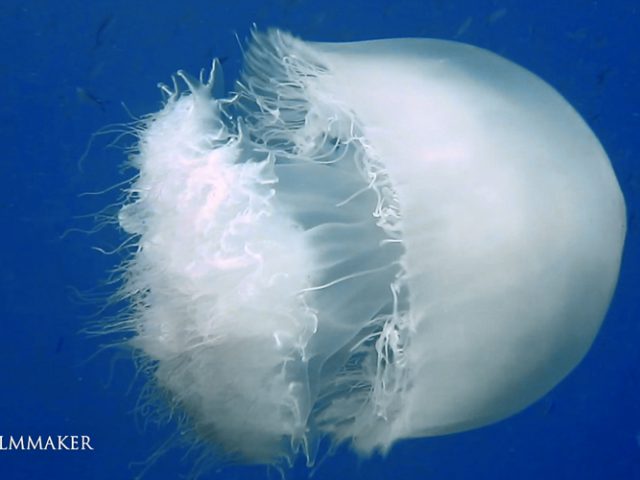
“Jellyfish" or “Sea Jellies" are the informal common names given to the medusa-phase of certain gelatinous members of the "subphylum Medusozoa", a major part of the "phylum Cnidaria". Jellyfish are mainly free-swimming marine animals with umbrella-shaped bells and trailing tentacles, although a few are not mobile, being anchored to the seabed by stalks. The bell can pulsate to provide propulsion and highly efficient locomotion. The tentacles are armed with stinging cells and may be used to capture prey and defend against predators. Jellyfish have a complex life cycle; the medusa is normally the sexual phase, the planula larva can disperse widely and is followed by a sedentary polyp phase. They are found all over the world, from surface waters to the deep sea. “Scyphozoans" (the "true jellyfish") are exclusively marine, but some “hydrozoans" with a similar appearance live in freshwater. Large, often colorful, jellyfish are common in coastal zones worldwide. The medusae of most species are fast growing, mature within a few months and die soon after breeding, but the polyp stage, attached to the seabed, may be much more long-lived. Jellyfish have been in existence for at least 500 million years and possibly 700 million years or more, making them the oldest multi-organ animal group. (Wikipedia)
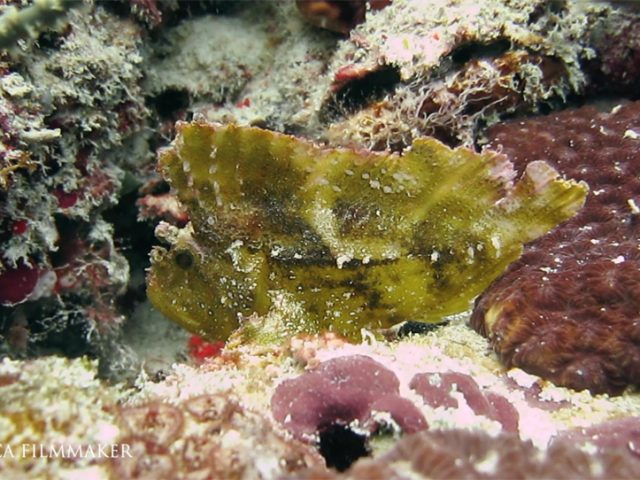
The leaf scorpionfish (Taenianotus triacanthus) or paperfish is a species of marine fish, the sole member of its genus. It is about 10 cm (4 in) long fully grown. Their color varies from green, red, pink, brown, ocher and yellowish to a ghostly white. The fish is almost as flat as a leaf and resembles a leaf in many other ways. The head and mouth are large. Through their eyes is a dark line. The large dorsal fin starts just behind the eyes and has 12 spines and eight to 11 soft rays, its anal fin has three spines and five or six soft rays. The venom of the leaf scorpionfish is considerably weaker than that of the lionfish and stonefish. The skin often has blotches that enhance a camouflage effect. The Leaf Scorpionfish resembles a dead leaf lying in the water, to enhance this camouflage, it even makes gentle sideways movements in its pelvic area which make it resemble a drifting inert object. It is an ambush predator, waiting until suitable prey, a small fish or shrimp, approaches ; when the leaf scorpionfish is close enough, the prey is sucked in by a sudden opening of its mouth. It eats small crustaceans, fish and larvae. This fish is widespread from east African coast and the Red Sea to the tropical Indo-Pacific, north to the Galapagos Islands, the Ryukyu Islands, Hawaii and the coast of New South Wales. It can be found in tropical waters on coral reefs, from shallow water to a depth of 130 m. (Wikipedia)
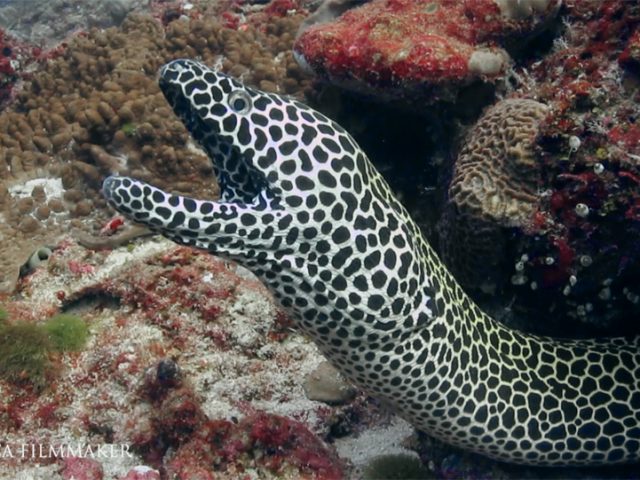
The laced moray (Gymnothorax favagineus), also known as the leopard moray, tessellate moray or honeycomb moray, is a species of marine fishin the family Muraenidae. It is a large moray which can reach a maximum length of 300 cm, but specimens usually encountered are much smaller. Its serpentine in shape body has a white to yellowish background color dotted with numerous black spots which latter vary in size and shape depending on the individual and on the environment in which the animals live. It is widespread throughout the Indo-West Pacific area from eastern coast of Africa, Red Sea included, until Papua New Guinea and from south Japan to the Great Barrier Reef. It lives on the outer slopes of coral reefs, during the day, it sits sheltered in crevices between 3.3 and 148.5 feet (1 and 45 meters) deep. The Leopard Moray is carnivorous, it leaves its lair at night to actively hunt its preys along the reef, it feeds mainly on small fish and cephalopods. (Wikipedia)
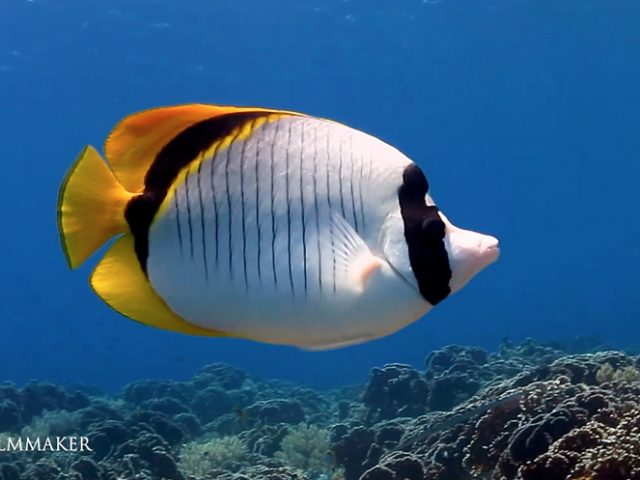
The “Lined Butterflyfish" (Chaetodon lineolatus) is a butterflyfish (family Chaetodontidae), one of the largest species in the genus Chaetodon. They have a wide range from the Red Sea to South Africa and as far east as southern Japan and Hawaii. Lined butterflyfish may grow up to 30 cm (nearly 12 in) long. They are white in color, with thin black vertical bars which join a thick black band at the base of the tail and dorsal fin. The tail, dorsal, and anal finsare yellow. This uncommon fish is found in pairs or swimming alone or occasionally in spawning aggregations. It occurs between 2 and 50 m depth, in coral-rich areas of reefs and lagoons. Coral polyps, small anemones, algae and invertebrates make up their diet. (Wikipedia)
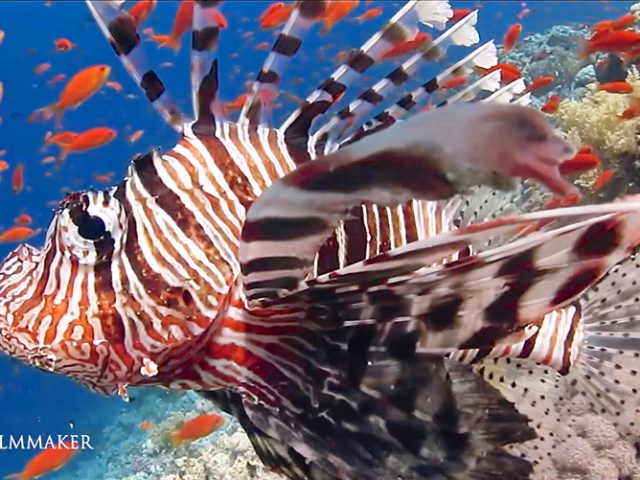
“Red Lionfish" (Pterois volitans) is a venomous coral reef fish in the family Scorpaenidae, order Scorpaeniformes. It is natively found in the Indo-Pacific region, but has become an invasive problem in the Caribbean Sea, as well as along the East Coast of the United States. This and a similar species, Pterois miles, have both been deemed invasive species. Red Lionfish are clad in white stripes alternated with red/maroon/brown stripes. Adults in this species can grow as large as 47 cm (18.5 in) in length, making it one of the largest species of lionfish in the ocean, while juveniles are typically shorter than 1 inch (2.5 cm). The average red lionfish lives around 10 years. As with many species within the family Scopaenidae, it has large, venomous spines that protrude from the body, similar to a mane, giving it the common name lionfish. The venomous spines make the fish inedible or deter most potential predators. (Wikipedia)
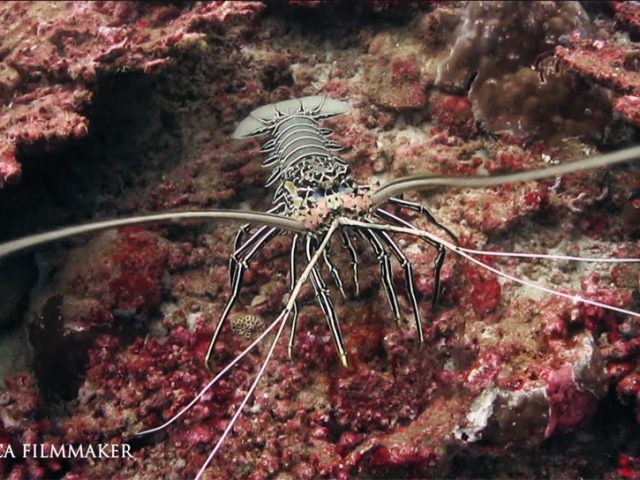
Lobsters are a family (Nephropidae, sometimes also Homeridae) of large marine crustaceans. They have long bodies with muscular tails, and live in crevices or burrows on the sea floor. Lobsters are invertebrates with a hard protective exoskeleton. Like most arthropods, they must moult to grow, which leaves them vulnerable. During the moulting process, several species change color. Lobsters have eight walking legs; the front three pairs bear claws, the first of which are larger than the others. Because lobsters live in murky environments at the bottom of the ocean, they mostly use their antennae as sensors. They live in all oceans, on rocky, sandy or muddy bottoms from the shoreline to beyond the edge of the continental shelf. They generally live singly in crevices or in burrows under rocks, they are omnivores and typically eat live prey such as fish, mollusks, other crustaceans, worms, and some plant life. In general, they are 25–50 cm (10–20 in) long. (Wikipedia)
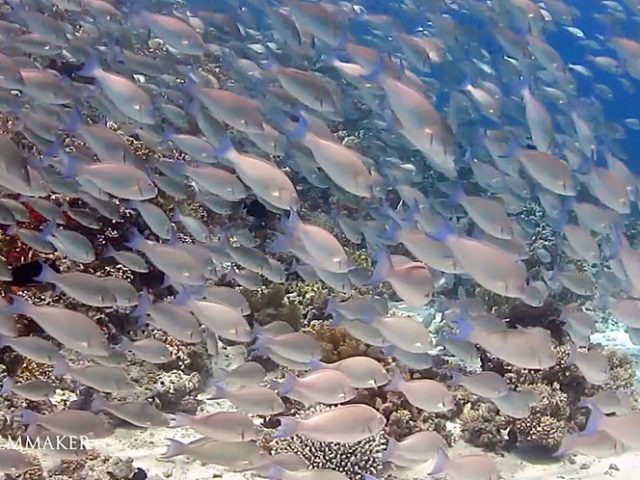
Longnose Parrotfish (Hipposcarus harid) routinely aggregate in large schools once a year during June/July in Ras Mohammed, Red Sea North. Their numerous teeth are arranged in a tightly packed mosaic on the surface of their jaw bones, forming a parrot-like beak with which they rasp algae from coral and other rocky substrate. Their feeding activity is important for the production and distribution of coral sands in the reef, and can prevent algal overgrowth of the reef structure. As all kinds of Parrotfish, after they digest the edible portions from the rock, they excrete it as sand, helping create small islands and the sandy beaches. The teeth grow continuously, replacing material worn away by feeding. Their pharyngeal teeth grind up the coral and rocks the fish ingest during feeding. In most parrotfish species, juveniles have a different color pattern from adults, juveniles of some tropical species can alter their color temporarily to mimic other species. (Wikipedia)
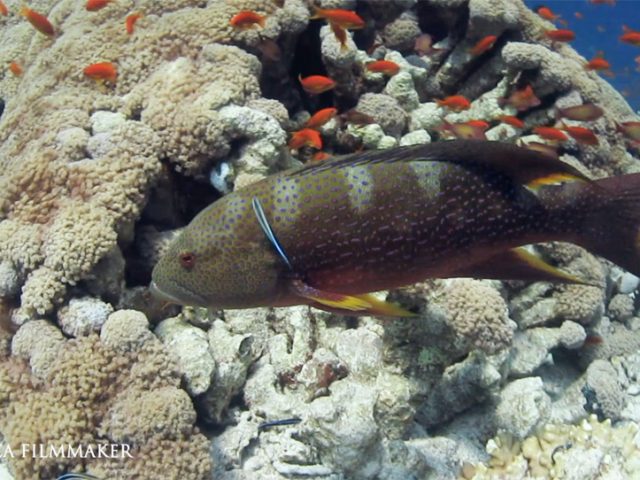
The yellow-edged lyretail (Variola louti) also known as the yellowedge coronation trout , fairy cod, lunar tail rock cod, lunartailed cod, lyre-tail codor moontail seabass,, is a species of marine ray-finned fish, a grouper from the subfamily Epinephelinae which is part of the family Serranidae, which also includes the anthias and sea basses. It is found in the Indo-Pacific region is commoner than the congeneric white-edged lyretail. They have a reddish colour on the upper body which frequently shades to orangish to white on the lower part of the body ; they are marked with many small bluish or pinkish spots on the head, body and fins. The rear margins of the fins are yellow. It has an Indo-Pacific distribution and is found from the east coast of Africa where it occurs from Durban in South Africa to the Red Sea through the tropical Indian Ocean east into the Pacific Ocean where it occurs as far north as southern Japan, south to Australia and east to the Pitcairn Islands. This grouper is normally observed in clear-water areas at depths greater than 15 metres (49 ft) but less than 350 metres (1,150 ft), showing a preference for islands and offshore reefs over continental shores. It feeds mostly on fish, as well as on crabs, shrimps and stomatopods. (Wikipedia)
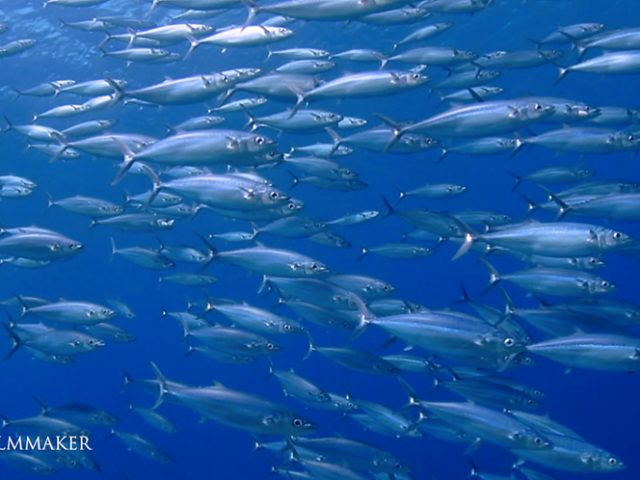
“Mackerel" is a common name applied to a number of different species of pelagic fish, mostly from the family Scombridae. They are found in both temperate and tropical seas, mostly living along the coast or offshore in the oceanic environment. Mackerel species typically have vertical stripes on their backs and deeply forked tails. Many are restricted in their distribution ranges and live in separate populations or fish stocks based on geography. Some stocks migrate in large schools along the coast to suitable spawning grounds, where they spawn in fairly shallow waters. After spawning they return the way they came in smaller schools to suitable feeding grounds, often near an area of upwelling. Smaller mackerel are forage fish for larger predators, including larger mackerel. Flocks of seabirds, whales, dolphins, sharks, and schools of larger fish such as tuna and marlin follow mackerel schools and attack them in sophisticated and cooperative ways. (Wikipedia)
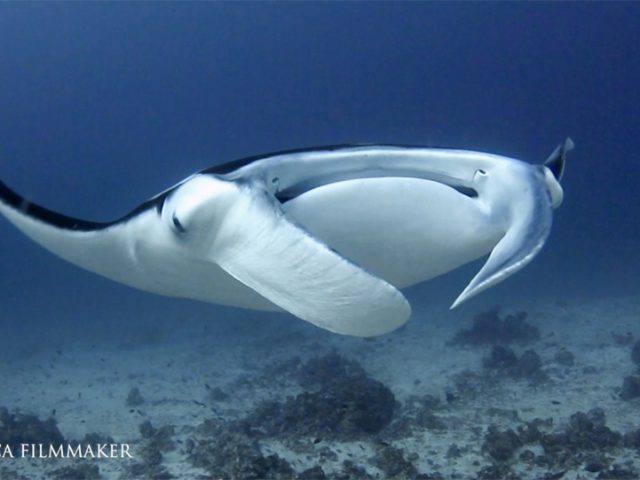
"Manta Rays" are large rays belonging to the genus Manta. The larger species, M. birostris, reaches 7 m (23 ft) in width, while the smaller, M. alfredi, reaches 5.5 m (18 ft 1 in). Both have triangular pectoral fins, horn-shaped cephalic fins and large, forward-facing mouths. They are classified among the Myliobatiformes (stingrays and relatives) and are placed in the family Myliobatidae (eagle rays). Mantas are found in warm temperate, subtropical and tropical waters. Both species are pelagic; M. birostris migrates across open oceans, singly or in groups, while M. alfredi tends to be resident and coastal. They are filter feeders and eat large quantities of zooplankton, which they gather with their open mouths as they swim. Gestation lasts over a year, and mantas give birth to live pups. Mantas may visit cleaning stations for the removal of parasites. Both species are listed as vulnerable by the International Union for Conservation of Nature. Anthropogenic threats include pollution, entanglement in fishing nets, and direct harvesting for their gill rakers for use in Chinese medicine. (Wikipedia)
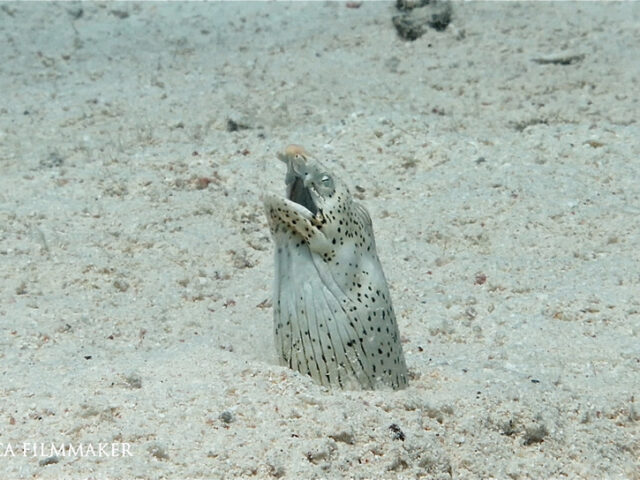
Callechelys marmorata, also known as the marbled snake eel, is a benthic marine fish belonging to the family Ophichthidae which refers to serpentine in shape fish. The Marbled snake eel is a medium-sized fish which grows up to 87 cm. It is widely distributed throughout the tropical waters of the Indian Ocean, Red Sea included, to the western Pacific Ocean. It inhabits the sandy and muddy bottoms close to coastal reef from 1 until 37 m depth. The Marbled snake eel has a nocturnal activity. (Wikipedia)
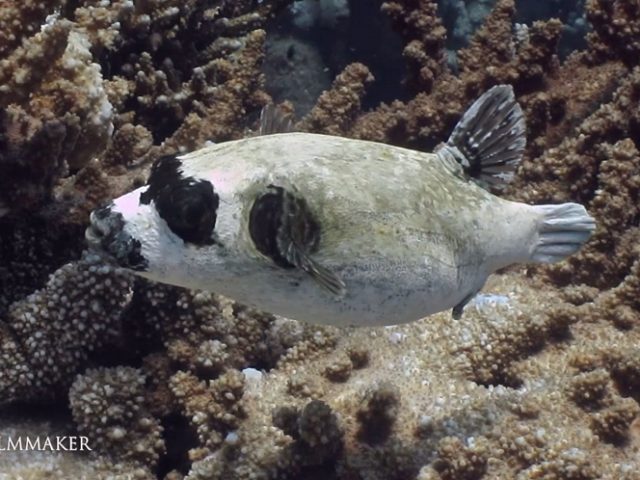
The “Masked Puffer" (Arothron diadematus) is a pufferfish in the family “Tetraodontidae". It lives in the Red Sea only. Maximum length 30 cm, olive-green/grey with a black mask over the eyes and pectoral fins, mouth has a black border. Usually solitary but schools during mating period. It lives on the coral reefs, from surface to 20m depth. (Wikipedia)
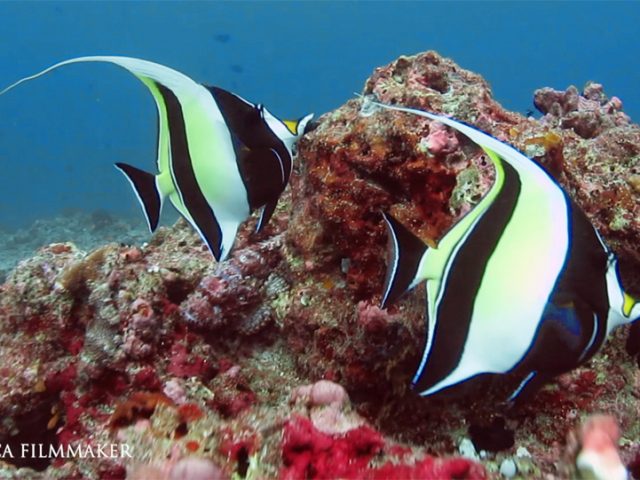
The Moorish idol (Zanclus cornutus) is a marine fish species, the sole extant representative of the family Zanclidae in order Perciformes. A common inhabitant of tropical to subtropical reefs and lagoons, the Moorish idol is notable for its wide distribution throughout the Indo-Pacific. The Moorish idol got its name from the Moors of Africa, who purportedly believed the fish to be a bringer of happiness. With distinctively compressed and disk-like bodies, Moorish idols stand out in contrasting bands of black, white and yellow, which makes them attractive to aquarium keepers. The fish have relatively small fins, except for the dorsal fin, whose six or seven spines are dramatically elongated to form a trailing, sickle-shaped crest called the philomantis extension. Moorish idols have small terminal mouths at the end of long, tubular snouts; many long bristle-like teeth line the mouth. Generally denizens of shallow waters, they prefer flat reefs. Their range includes East Africa, the Indian Ocean, Persian Gulf and the Ducie Islands; Hawaii, southern Japan, and all of Micronesia; they are also found from the southern Gulf of California south to Peru. Sponges, coral polyps, tunicates, and other benthic invertebrates constitute the bulk of the Moorish Idol. (Wikipedia)
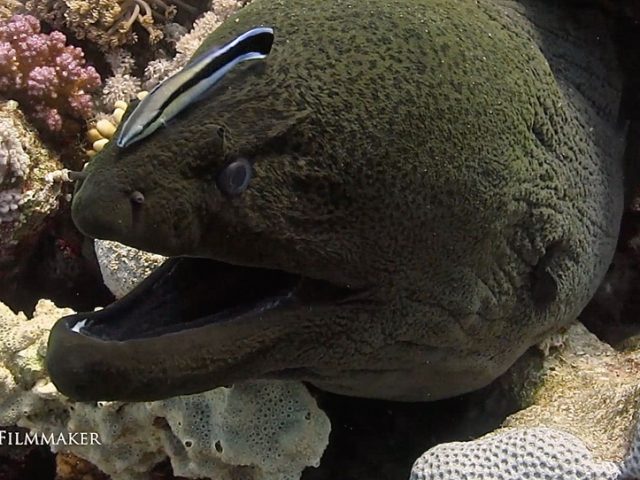
"Moray eels" or “Muraenidae", are a family of eels whose members are found worldwide. The approximately 200 species in 15 genera are almost exclusively marine, but several species are regularly seen in brackish water, and a few are found in fresh water. The dorsal fin extends from just behind the head along the back and joins seamlessly with the caudal and anal fins. Most species lack pectoral and pelvic fins, adding to their serpentine appearance. Their eyes are rather small; morays rely mostly on their highly developed sense of smell, lying in wait to ambush prey. The body is generally patterned. In some species, the inside of the mouth is also patterned. Their jaws are wide, framing a protruding snout. Most possess large teeth used to tear flesh or grasp slippery prey items. "Cleaner fish" are fish that provide a service to other species by removing dead skin and ectoparasites. The cleaning symbiosis is an example of mutualism, an ecological interaction that benefits both parties involved. The best known cleaner fish are the cleaner wrasses of the genus Labroides found on coral reefs in the Indian Ocean and Pacific Ocean. These small fish maintain so-called cleaning stations where other fish, known as hosts, congregate and perform specific movements to attract the attention of the cleaner fish. (Wikipedia)

The “Humphead Wrasse" (Cheilinus undulatus) is a species of wrasse mainly found on coral reefs in the Indo-Pacific region. It is also known as the "Māori Wrasse", "Napoleon Wrasse", "Napoleon Fish". It is the largest living member of the family Labridae. Males are typically larger than females and are capable of reaching lengths of up to 2 meters from tip to tail and weighing up to 180 kg, but the average length is generally a little less than 1 meter. Females rarely grow larger than one meter in length. This species of fish can be easily identified by its large size, thick lips, two black lines behind its eyes, and the hump that appears on the forehead of larger adults. The color of the humphead wrasse can vary between a dull blue-green to more vibrant shades of green and purplish-blue. This particular reef fish prefers to live singly but adults are occasionally observed moving in small groups. The humphead wrasses can be located with in the east coast of Africa and Red Sea, as well as in the Indian Ocean to the Pacific Ocean. Juvenile and adult humphead wrasses are found in different ranges. Juveniles are usually found in shallow, sandy ranges that are bordering coral reef waters, while adults are mostly found in offshore and deeper areas of the coral reefs, typically in outer-reef slopes and channels, but can also be found in lagoons. Humphead wrasses are found in small groups or larger combinations within their habitat. It mainly eats invertebrates such as mollusks (particularly gastropods and pelecypods), echinoids, crustaceans, annelids and fish. (Wikipedia)
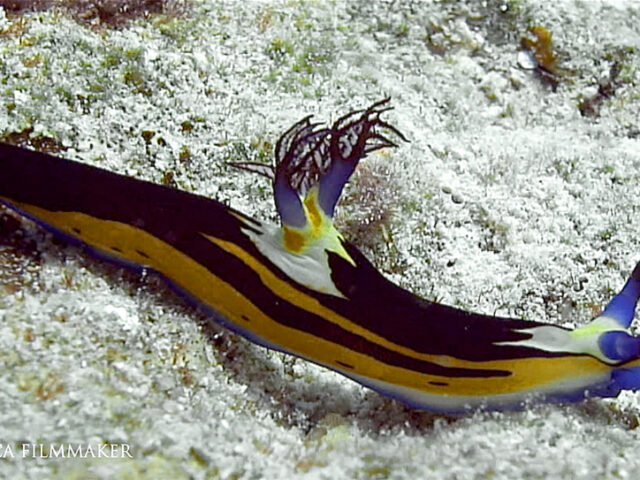
is a species of colourful sea slug, a dorid nudibranch, a marine gastropod mollusk in the family Polyceridae. This species is known from the Red Sea. Nembrotha megalocera is a large black and orange-yellow nembrothid that grows to at least 45 mm in length. It has a blue foot. The rhinophores are red and purple and the gill stalks are white and yellow, it eats colonial ascidians. (Wikipedia)
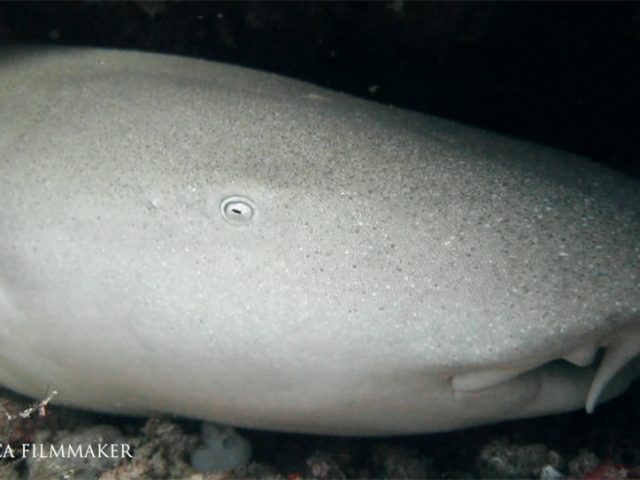
The nurse shark (Ginglymostoma cirratum) is an elasmobranch fish within the family Ginglymostomatidae. It has two rounded dorsal fins, rounded pectoral fins, an elongated caudal fin, a broad head and brownish in color. ; maximum adult length is currently documented as 3.08 m (10.1 ft). Nurse sharks are a typically inshore bottom-dwelling species. Juveniles are mostly found on the bottom of shallow coral reefs, seagrass flats and around mangrove islands, whereas older individuals typically reside in and around deeper reefs and rocky areas, where they tend to seek shelter in crevices and under ledges during the day and leave their shelter at night to feed on the seabed in shallower areas. Nurse sharks are opportunistic predators that feed primarily on small fish (e.g. stingrays) and some invertebrates (e.g. crustaceans, molluscs, tunicates). They are typically solitary nocturnal animals, rifling through bottom sediments in search of food at night, but often gregarious during the day forming large sedentary groups. (Wikipedia)
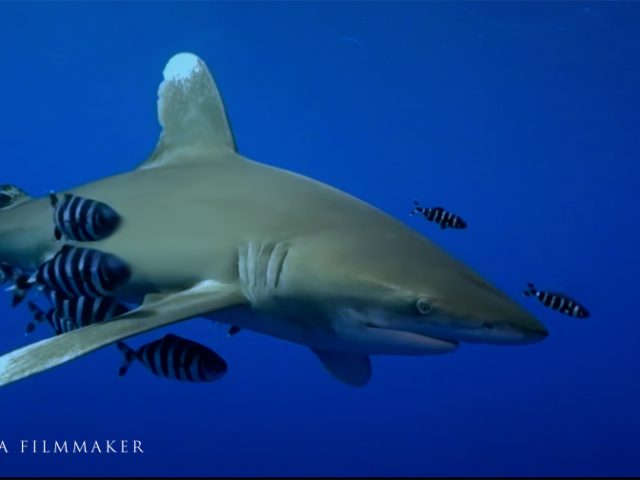
The “Oceanic Whitetip Shark" (Carcharhinus longimanus), also known as "Brown Milbert's Sand Bar Shark”, “Brown Shark”, “Lesser White Shark”, “Nigano Shark”, “Oceanic White-Tipped Whaler", is a large pelagic requiem shark inhabiting tropical and warm temperate seas. Its stocky body is most notable for its long, white-tipped, rounded fins. The oceanic whitetip is found globally in deep, open oceans, with a temperature greater than 18 °C (64 °F). It spends most of its time in the upper layer of the ocean, to a depth of 150 m (490 ft) and prefers off-shore, deep-ocean areas. Longimanus' most distinguishing characteristics are its long, wing-like pectoral and dorsal fins. The fins are significantly larger than most other shark species, and are conspicuously rounded. The shark's nose is rounded and its eyes are circular, with nictitating membranes. It is bronze, brown, bluish, or grey dorsally (the colour varies by region), and white ventrally (although it may occasionally have a yellow tint). The oceanic whitetip shark is a medium-sized requiem shark. The largest specimen ever caught measured 4 m (13 ft). Recent studies show steeply declining populations because its large fins are highly valued as the chief ingredient of Cinese "shark fin soup". (Wikipedia)
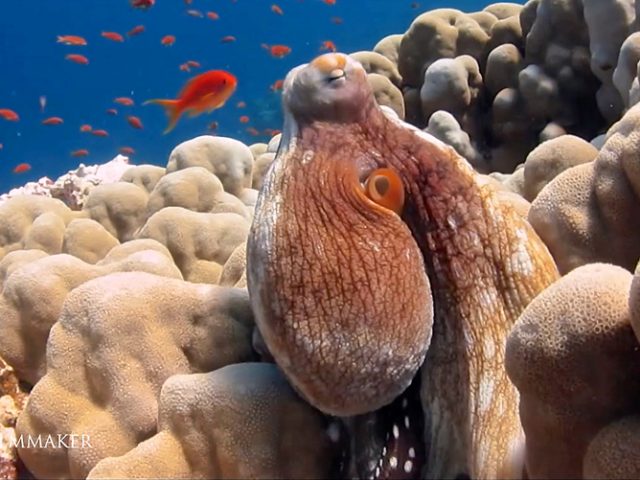
The “Octopus" is a soft-bodied, eight-limbed mollusc of the order “Octopoda". Around 300 species are recognised, and the order is grouped within the class Cephalopoda with squids, cuttlefish, and nautiloids. Like other cephalopods, the octopus is bilaterally symmetric with two eyes and a beak, with its mouth at the center point of the eight limbs (traditionally called "arms", sometimes mistakenly called "tentacles"). The soft body can rapidly alter its shape, enabling octopuses to squeeze through small gaps. They trail their eight appendages behind them as they swim. The siphon is used both for respirationand for locomotion, by expelling a jet of water. Octopuses have a complex nervous system and excellent sight, and are among the most intelligent and behaviourally diverse of all invertebrates. Octopuses inhabit various regions of the ocean, including coral reefs, pelagic waters, and the seabed; some live in the intertidal zone and others at abyssal depths. They use camouflage when hunting, and to avoid predators. To do this they use specialised skin cells (Chromatophores) which change the appearance of the skin by adjusting its colour, opacity, or reflectivity. This colour-changing ability is also used to communicate with or warn other octopuses. Octopuses that are diurnal and live in shallow water have evolved more complex skin than their nocturnal and deep-sea counterparts. (Wikipedia)
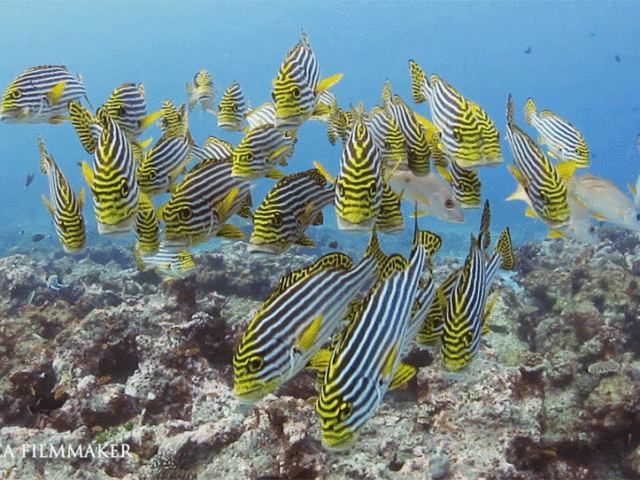
Plectorhinchus vittatus, is a species of grunt native to the Indian Ocean and the western Pacific Ocean. This species can be found on both coral and rock reefs at depths from 2 to 25 m (6.6 to 82.0 ft). The Indian Ocean oriental sweetlips reach up to 72 cm (28 in) in SL. Juveniles are striped black. As they age, the stripes in the tail are replaced by black dots on a yellow background. (Wikipedia)
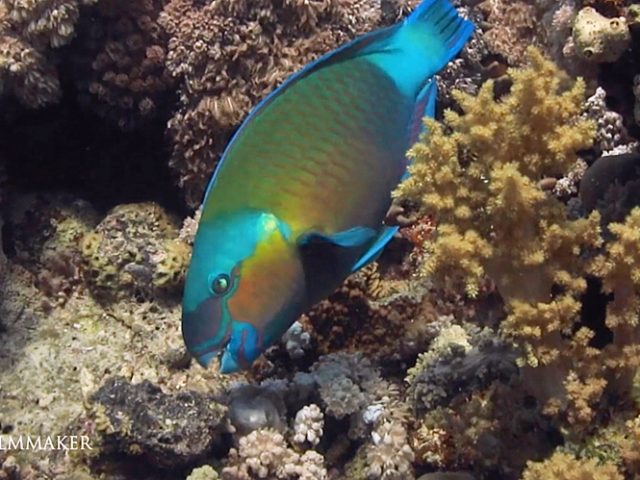
“Parrotfish" are a group of marine species found in relatively shallow tropical and subtropical oceans around the world. With about 95 species, this group displays its largest species richness in the Indo-Pacific. They are found in coral reefs, rocky coasts, and seagrass beds, and can play a significant role in bioerosion. Parrotfish are named for their dentition, which is distinct from other fish, including other labrids. Their numerous teeth are arranged in a tightly packed mosaic on the external surface of their jaw bones, forming a parrot-like beak with which they rasp algae from coral and other rocky substrates. Their feeding activity is important for the production and distribution of coral sands in the reef biome, and can prevent algal overgrowth of the reef structure. Maximum sizes vary within the family, with the majority of species reaching 30–50 cm (12–20 in) in length. (Wikipedia)
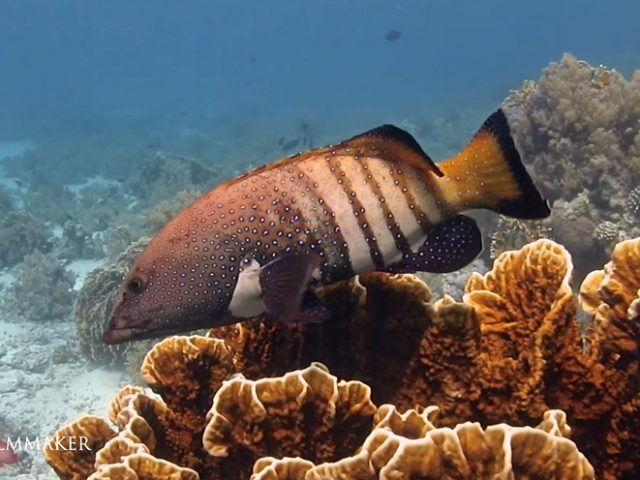
"Cephalopholis Argus", also known “Bluespotted Grouper" and “Celestial Grouper", is a fish from the Indo-Pacific which is variously a commercial gamefish, an invasive species, and occasionally an aquarium resident. This is a medium-sized fish that can reach a length of 60 centimeters (24 in). Small individuals are dark brown with hundreds of small, dark-edged iridescent blue spots. Larger specimens sometimes develop four to six lighter vertical bars on the back half of its body. The species is extremely widely distributed, occurring in warm waters from the Red Sea to South Africa and east to French Polynesia and the Pitcairn group. It is also present in northern Australia, Lord Howe Island, and Japan, and has been introduced to the Hawaiian Islands. It makes use of a variety of habitats but prefers the exposed fronts of reefs, at depths of up to 40 m. Hunting, they lie on the bottom and surge forward, preferring juvenile surgeonfish and crustaceans. Alternatively they may hover motionless in the water column before attacking. This grouper may follow and cooperate with another predator species, such as an octopus or eel or camouflage themselves in a school of surgeonfish. (Wikipedia)
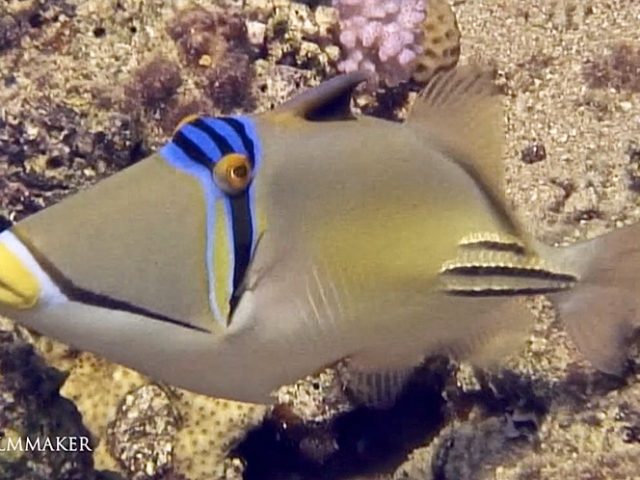
The “Picasso Triggerfish" (Rhinecanthus aculeatus), also known as the “Lagoon Triggerfish”, the “Blackbar Triggerfish” and the “Picassofish", is a triggerfish, up to 30 cm in length, found on reefs in the Indo-Pacific region. They live in the reefs and sandy areas of coral reefs where it eats just about everything that comes along. They are always restlessly swimming around and can vigorously protect their territory against intruders, including divers, especially when guarding their eggs during reproduction season. Their territory extends in a cone from the nest toward the surface, so swimming upwards can put a diver further into the fish's territory; a horizontal swim away from the nest site is best when confronted by an angry triggerfish. The rather bizarre anatomy of the triggerfishes reflects their typical diet of slow-moving, bottom dwelling crustaceans, mollusks, sea urchins and other echinoderms, generally creatures with protective shells and spines. Many will also take small fish. (Wikipedia)
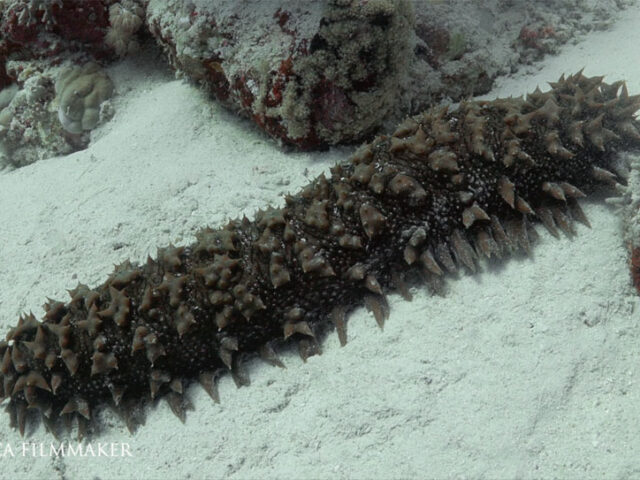
Thelenota ananas, also known as pineapple sea cucumber, oloturia ananas, tripang, is a species of sea cucumber found in tropical Indo-Pacific waters from the Red Sea and East Africa to Hawaii and Polynesia. It is a species of sea cucumber characterized by its large size, warm colors, and pointed, star-shaped teats covering the entire body, grouped in rows of 2 or 3. It is found in clean, sandy bottoms of lagoons with a depth of up to 30 m, or in slabs near large coral heads and coral rubble. Pineapple Sea Cucumber plays an important role in coral reef ecosystems by recycling nutrients, bioturbating sediments, buffering sea water from ocean acidification to local scales, prey to a range of predators, and acting as a host for symbiotic biota. (Wikipedia)
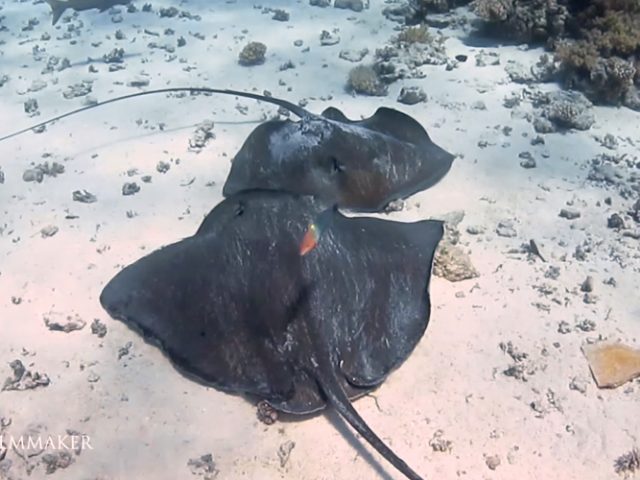
The pink whipray (Himantura fai) is a species of stingray in the family Dasyatidae, with a wide but ill-defined distribution in the tropical Indo-Pacific from southern Africa to Polynesia. It is a bottom dweller that generally inhabits shallow water under 70 m (230 ft) deep, in sandy areas associated with coral reefs. It has a diamond-shaped pectoral fin disc wider than long, with a broad-angled snout and a very long, whip-like tail without fin folds. It has only a few small thorns on its back and is uniform brownish to grayish pink in color, becoming much darker past the tail sting. This large ray can reach 1.8 m (5.9 ft) across and over 5 m (16 ft) long. It preys mainly on prawns, but also consumes other benthic invertebrates and bony fishes. When resting, up to ten individuals may pile atop one another, sometimes mixing with other species. (Wikipedia)
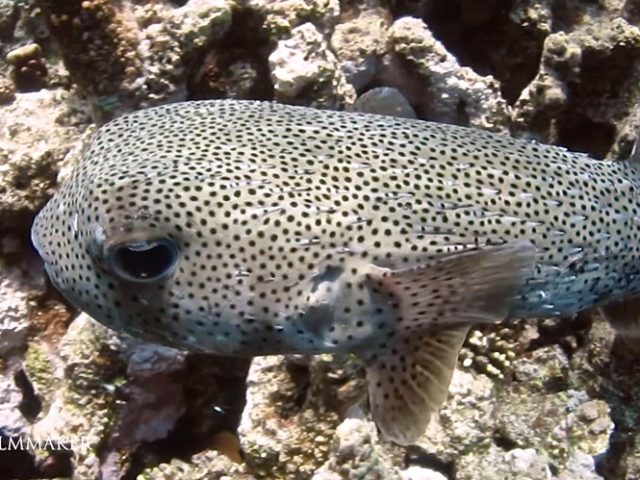
“Porcupinefish" are fish belonging to the family “Diodontidae" (order “Tetraodontiformes"), also commonly called “Blowfish" and, sometimes, “Balloonfish" and “Globefish". Porcupinefish are medium- to large-sized fish, and are found in shallow temperate and tropical seas worldwide. A few species are found much further out from shore, wherein large schools of thousands of individuals can occur. They are generally slow. They have the ability to inflate their bodies by swallowing water or air, thereby becoming rounder. This increase in size (almost double vertically) reduces the range of potential predators to those with much bigger mouths. A second defense mechanism is provided by the sharp spines, which radiate outwards when the fish is inflated. Some species are poisonous, having a tetrodotoxin in their internal organs, such as the ovaries and liver. This neurotoxin is at least 1200 times more potent than cyanide. The poison is produced by several types of bacteria obtained from the fish's diet. As a result of these three defenses, porcupinefish have few predators, although adults are sometimes preyed upon by sharks and killer whales. (Wikipedia)
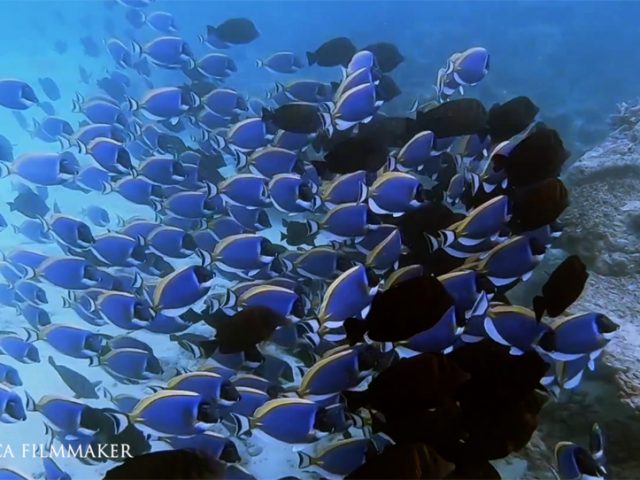
Acanthurus leucosternon is a marine tropical fish belonging to the surgeonfish family, Acanthuridae. Its common names are powder blue tang and powder-blue surgeonfish. The fish can reach an average size of 23 cm (9 in) in length. The body has an oval shape and is compressed laterally. Like other surgeonfish, Acanthurus leucosternon swims with its pectoral fins. It has a "surgeon's scalpel," an erected part of the spine located at the base of the tail. The mouth is small and pointed in a beak-like manner with tiny and sharp teeth for reaching narrow spaces of food. Its sides are blue, the dorsal fin and the base of caudal fin are yellow, its head is black. Powder-Blue Surgeonfish is found in tropical waters from the Indian Ocean, it inhabits shallow and clear coastal waters always associated with a reef. (Wikipedia)
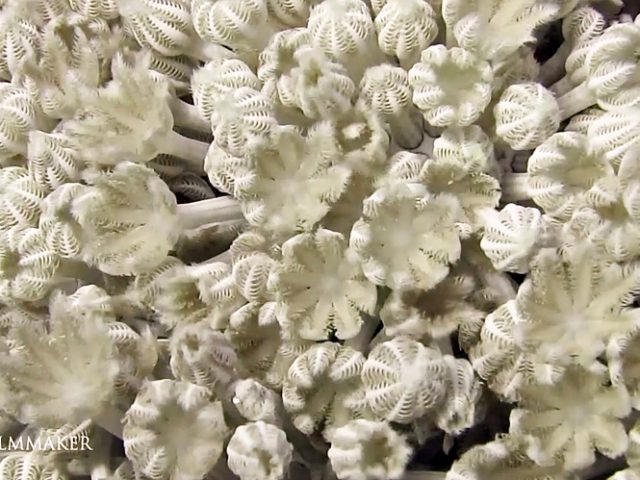
The pulsating xenid (Heteroxenia fuscescens) is a species of soft coral in the family Xeniidae. The polyps of Heteroxenia fuscescens grow to form large clumping colonies up to 60 centimetres (24 in) across. Its polyp stalks are approximately 5 centimetres (2.0 in) long, each stalk ending in a ring of large feathery pinnate tentacles, eight per polyp, as is typical of octocorals Polyps pulsate rhythmically around 40 times/ minute, moving their tentacles in a "pumping" or "pulsating" fashion. The function of this pulsing is not fully understood, some hypotheses include creating a current to assist feeding, respiration and helping to dispose of waste and detritus. It contains zooxanthellae and draws most of its energy from these symbiotes. These corals live on hard bottoms of lagoons, bays and slopes with little current and occurs from the Red Sea to the Indian Ocean. (Wikipedia)
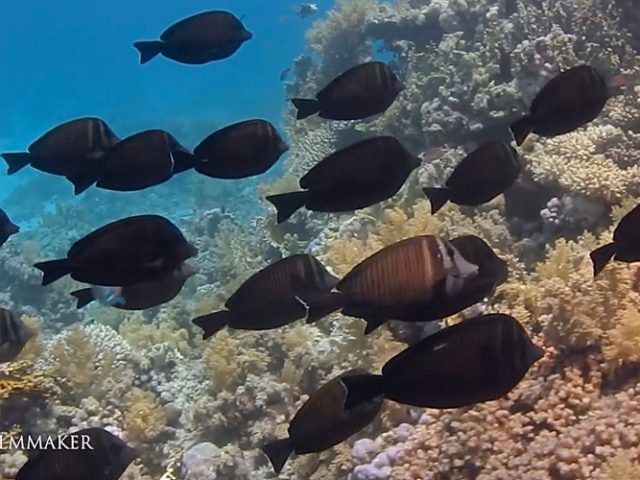
Zebrasoma desjardinii grows to a maximum length of 40 cm (16 in), in general, the upper side of the body alternates orange and dark blue vertical bands, with a larger blue band on the eyes, a spotted ventral region and numerous white spots on the head. Like most surgeonfish on each side of the caudal fin, in the middle of the caudal peduncle, there is a defensive dark spine surrounded by a blue zone. Adults usually can be found in pairs, while juveniles are solitary. When threatened, these fish display their large ventral and dorsal fins. They feed primarily on filamentous algae, various macroalgae and plankton. However, individuals were regularly observed feeding on jellyfish (Scyphozoa) and comb jellies (Ctenophora) in the Red Sea. (Wikipedia)
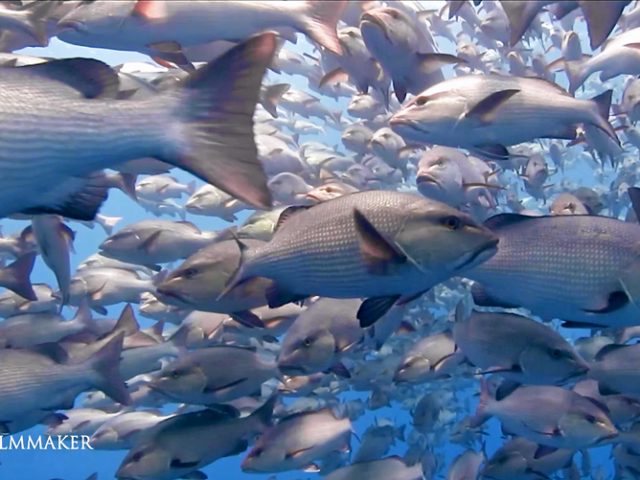
"Lutjanus bohar", the "Two-spot Red Snapper", is a species of snappers belonging to the “Lutjanidae" family. It is also known as the "Red Bass", “Twinspot Snapper" or "Bohar Snapper”. This species is native to the Indian Ocean. It is widespreas in the Indo-Pacific from the east African coast to the western Pacific Ocean, north to the Ryukyu Islands, south to Australia, Red Sea. It can reach a length of 90 cm (35 in), though most do not exceed 76 cm (30 in). The greatest recorded weight for this species is 12.5 kg (28 lb). These large reddish tropical snappers show darker fins, a rounded profile of head and a groove running from the nostrils to the eyes. They have 10 dorsal spines and 3 anal spines. Juveniles and some adults have two silvery-white spots (hence the common name) on the back close to their dorsal fins, while larger adults lose the spots and become mostly red. Large adults may cause ciguatera poisoning. Adult snappers often form large schools on the outer reefs or above sandy areas, mainly to form spawning aggregations. They are carnivorous, mostly feeding on other fish, crustaceans and molluscs. (Wikipedia)
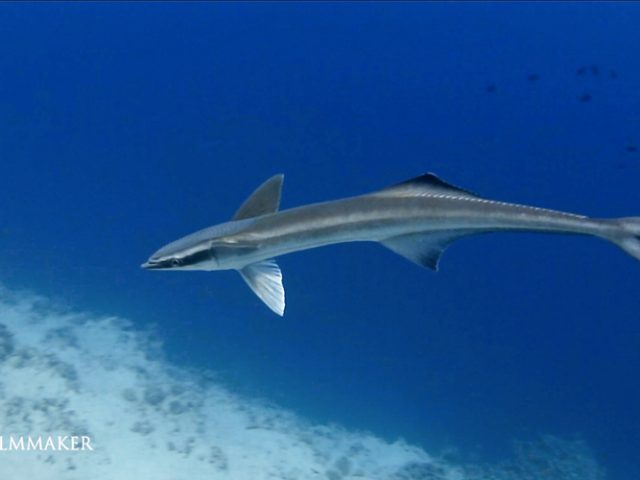
The live sharksucker or slender sharksucker (Echeneis naucrates) is a species of marine fish in the family Echeneidae, the remoras. The species is considered as circumtropical, as it occurs in all tropical and warm temperate waters around the world, except for the eastern Pacific.The species can be found close to the coast, as well as offshore at a maximum depth of 50 m (160 ft). A live sharksucker is known to attach itself temporarily by its modified dorsal fin used as a sucking disc to various hosts, such as sharks, rays, large bony fish, sea turtles, whales, dolphins, ships and even sometimes scubadivers. It is a medium-sized fish which can grow up to 110 cm (43 in) length; its body is elongated and streamlined and its lower jaw is clearly prognathic. The main distinctive feature to distinguish from other fish is the oval-shaped sucking disc, which is a highly modified dorsal fin positioned from the top of the head to the anterior part of the body. The body background colouration is dark grey to dark brown, with a dark belly; a longitudinal stripe runs along the axis side of the body, it is always darker than its background colour with a whitish margin. The caudal fin is black with white corners. Remora eats parasitic crustaceans from the latter, food scraps from the feeding activity of its host, or some small food caught by filtering the water through its villiform teeth while the navigating on its host. (Wikipedia)
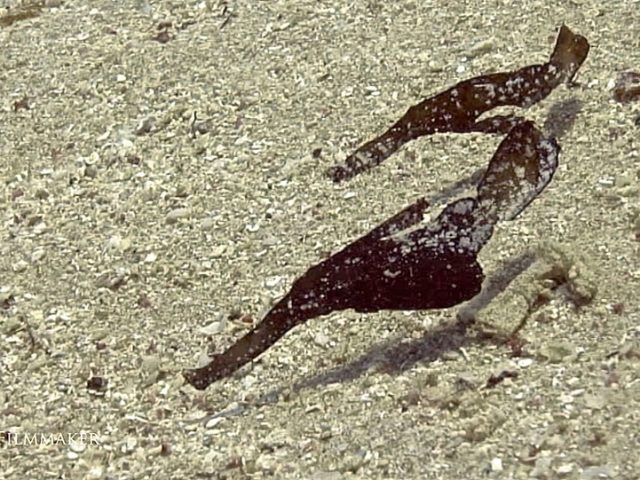
The “Robust Ghost Pipefish" (Solenostomus cyanopterus), also known as the “Blue-Finned Ghost Pipefish”, "Racek's Ghost Pipefish”, “Robust-Snouted Ghost Pipefish" or the “Squaretail Ghost-Pipefish", is a species of false pipefish belonging to the family “Solenostomidae”. Solenostomus cyanopterus can reach a length of 17 cm (6.7 in) and it is the largest of the ghost pipefish. The body may be grey, brown, pink, yellow, or bright green, with small black and white dots. This cryptic species looks very similar to a drifting piece of seagrass. The caudal fin may be truncated, rounded, or lanceolated; the caudal peduncle is quite short or absent. The pelvic fin is sexually dimorphic. It is an uncommon species related to pipefishes and seahorses. It can be distinguished by the presence of the pelvic fins, the prominent spiny dorsal fin, and 27–35 star-shaped plates on the skin. These fish float near motionlessly, with their mouths facing downwards, around a background that makes them nearly impossible to see. They feed on tiny crustaceans, sucked inside through their long snouts. They live in open waters except during breeding, when they find a coral reef or muddy bottom, changing color and shape to minimize visibility. Unlike true pipefish, female ghost pipefish use their enlarged pelvic fins to brood their eggs until they hatch. This species lives in the Red Sea and in the tropical Indo-Pacific, from the coast of East Africa to Fiji, southern Japan and Australia. (Wikipedia)
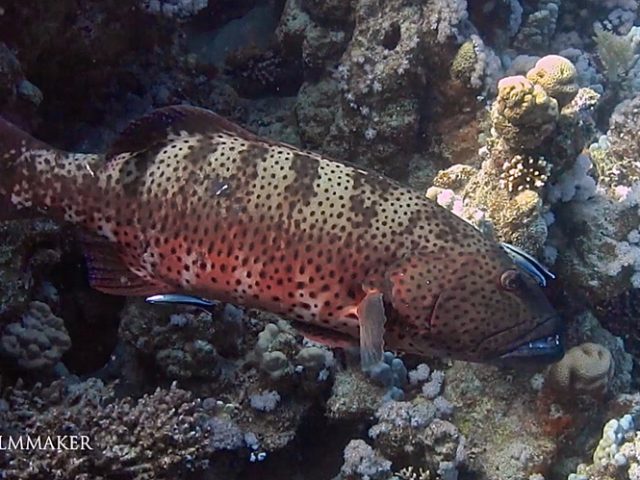
The “Roving Coral Grouper” or “Red Sea Coral Grouper" (Plectropomus pessuliferus) is a species of fish in the family “Serranidae". Other common names are “Violet Coral Trout" and “Leopard Grouper”. This widespread but quite rare species can be found in the Indo-Pacific, from the Red Sea to Fiji. It lives in coral reef, in shallow lagoon and seaward reefs, at a depth range of 25 – 147 m; this grouper reaches a maximum length of 120 cm (in the Red Sea) and at least 63 cm (in the rest of the Indo-Pacific). It has massive body and head with prominent eyes and characteristic large jaws and lips. Its pectoral and caudal fins are darker, sometimes brown, spotted with blue dots. These groupers have very variable colors, from white or beige to red, with large, irregular, vertical, grayish bands. This carnivorous species mainly feed on fish and crustaceans. They sometimes engage in cooperative hunting with the Giant Moray (Gymnothorax javanicus), the Humphead Wrasse (Cheilinus undulatus) or the big Blue Octopus (Octopus cyanea). (Wikipedia)
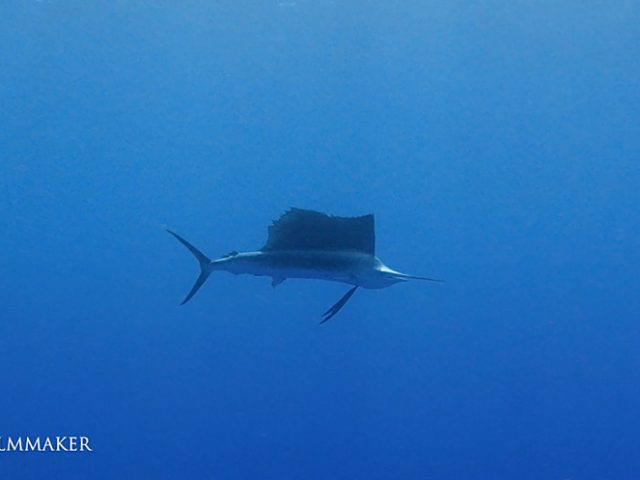
A “Sailfish" is a fish of the genus Istiophorus of billfish living in colder areas of all the seas of the earth. They are predominantly blue to gray in colour and have a characteristic erectile dorsal fin known as a sail, which often stretches the entire length of the back. Another notable characteristic is the elongated bill, resembling that of the swordfish and other marlins. Generally, sailfish do not grow to more than 3 m (9.8 ft) in length and rarely weigh over 90 kg (200 lb). Sailfish have been reported to use their bills for hitting schooling fish by tapping (short-range movement) or slashing (horizontal large-range movement) at them. The sail is normally kept folded down when swimming and raised only when the sailfish attack their prey. The raised sail has been shown to reduce sideways oscillations of the head, which is likely to make the bill less detectable by prey fish. This strategy allows sailfish to put their bills close to fish schools or even into them without being noticed by the prey before hitting them. (Wikipedia)
![SAND LIZARDFISH The sand lizardfish, clearfin lizardfish or variegated lizardfish[1] (Synodus dermatogenys) is a species of lizardfish that lives mainly in the Indo-Pacific. It is found in a marine environment within a reef-associated depth range of about 1–70 meters. The maximum recorded length of the Synodus dermatogenys as an unsexed male is about 24 centimeters (9.44 inches). It can be identified by the five or six red-brown vertical bars that intersect a red horizontal broken band on the flank, immediately below this band is a line of whitish dots although the colours can vary depending on the surroundings. This species is native to the areas of Indo-Pacific, Red Sea, Hawaiian, Line, Marquesan, Tuamoto islands, north to Ryukyu Islands, south to Lord Howe, Micronesia, Southeast Atlantic, Algoa Bay, and South Africa. It is common to find this species in sand-rubble areas of lagoon and seaward reefs to over 20 meters of benthic depth. It buries itself in the sand while exposing its eyes and nostrils. Sand lizardfish is a predator of small fish and crustaceans, its mouth is full of sharp needle-like teeth. (Wikipedia)](https://www.ninodelduca.com/wp-content/uploads/2020/10/SAND-LIZARDFISH-640x480.jpg)
The sand lizardfish, clearfin lizardfish or variegated lizardfish[1] (Synodus dermatogenys) is a species of lizardfish that lives mainly in the Indo-Pacific. It is found in a marine environment within a reef-associated depth range of about 1–70 meters. The maximum recorded length of the Synodus dermatogenys as an unsexed male is about 24 centimeters (9.44 inches). It can be identified by the five or six red-brown vertical bars that intersect a red horizontal broken band on the flank, immediately below this band is a line of whitish dots although the colours can vary depending on the surroundings. This species is native to the areas of Indo-Pacific, Red Sea, Hawaiian, Line, Marquesan, Tuamoto islands, north to Ryukyu Islands, south to Lord Howe, Micronesia, Southeast Atlantic, Algoa Bay, and South Africa. It is common to find this species in sand-rubble areas of lagoon and seaward reefs to over 20 meters of benthic depth. It buries itself in the sand while exposing its eyes and nostrils. Sand lizardfish is a predator of small fish and crustaceans, its mouth is full of sharp needle-like teeth. (Wikipedia)
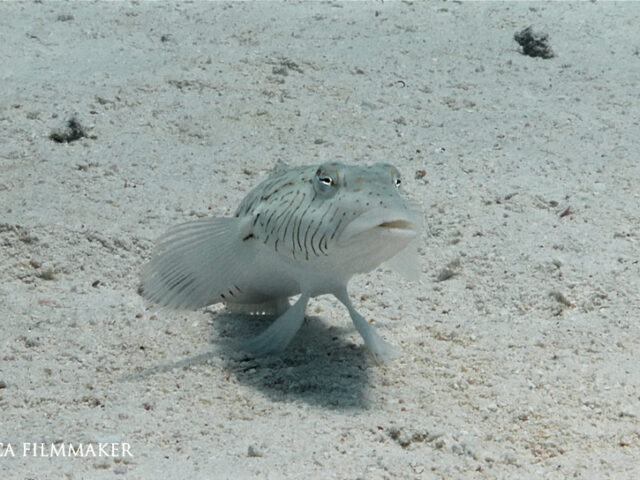
The sandperches are a family, Pinguipedidae, of fish in the percomorph order Trachiniformes. Sandperches are benthic fish which normally occur over sand or rubble substrates in shallow seas. They are found off the coasts of South America, South Africa and in the Indo-Pacific as far east as Japan. They have elongated bodies which are flattened posteriorly and cylindrical towards the head. The body usually patterned with spots and bands, The eyes are positioned near top of head. (Wikipedia)
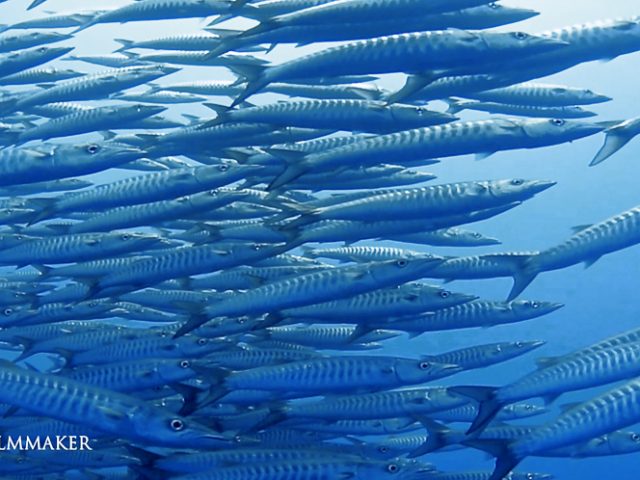
The “Barracuda" is a ray-finned fish known for its large size, fearsome appearance and ferocious behaviour. The barracuda is a saltwater fish of the genus “Sphyraena", the only genus in the family “Sphyraenidae”. It is found in tropical and subtropical oceans worldwide ranging from the eastern border of the Atlantic Ocean to the Red Sea, on its western border the Caribbean Sea, and in tropical areas of the Pacific Ocean. Barracudas reside near the top of the water and near coral reefs and sea grasses. They are snake-like in appearance, with prominent, sharp-edged, fang-like teeth, much like piranha, all of different sizes, set in sockets of their large jaws. They have large, pointed heads with an underbite in many species. In most cases, a barracuda is dark gray, dark green, white, or blue on its upper body, with silvery sides and a chalky-white belly. Coloration varies somewhat between species. For some species, irregular and unorganized black spots or a row of darker cross-bars occur on each side. Their fins may be yellowish or dusky. Barracudas live primarily in oceans. Barracudas often form large schools, living and hunting together. (Wikipedia)
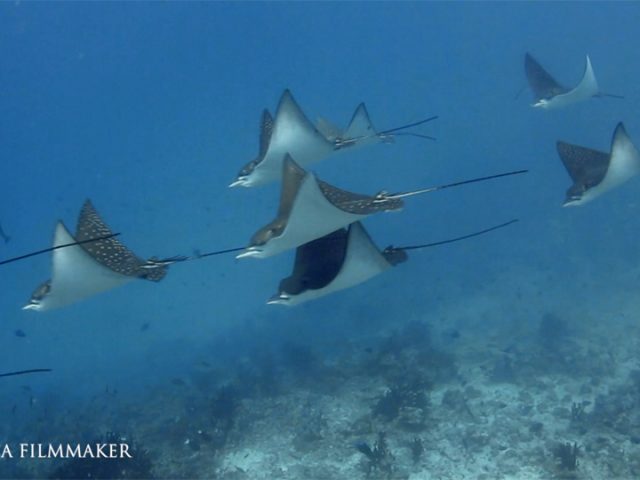
The "Eagle Rays" are a group of cartilaginous fish in the family "Myliobatidae", consisting mostly of large species living in the open ocean rather than on the sea bottom. Eagle rays feed on mollusks and crustaceans, crushing their shells with their flattened teeth. They are excellent swimmers and are able to breach the water up to several metres above the surface. Compared with other rays, they have long tails, and well-defined, rhomboidal bodies. They are ovoviviparous, giving birth to up to six young at a time. They range from 0.48 to 9.1 m (1.6 to 29.9 ft) in length. Eagle rays live close to the coast in depths of 1 to 30 m (3 to 98 ft) and in exceptional cases they are found as deep as 300 m (980 ft). It is most commonly seen cruising along sandy beaches in very shallow waters, its two wings sometimes breaking the surface and giving the impression of two sharks traveling together. (Wikipedia)
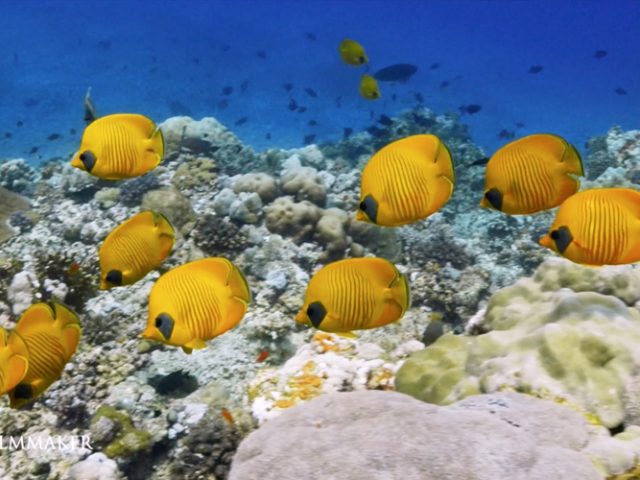
The “Masked Butterflyfish” or “Blue-Cheeked Butterflyfish”, "Chaetodon Semilarvatus", is a species of butterflyfish (family Chaetodontidae). It is found in the Red Sea and the Gulf of Aden, at depths of between 3 and 20 m. Its length is up to 13 cm (5.1 in). It is mostly yellow, with thin slate blue vertical lines on the sides and a slate blue cheek patch in lieu of the usual black eyestripe of most Chaetodon. This species is one of the few fish species to have long-term mates. In the wild, the fish eats hard corals as well as benthic invertebrates. (Wikipedia)
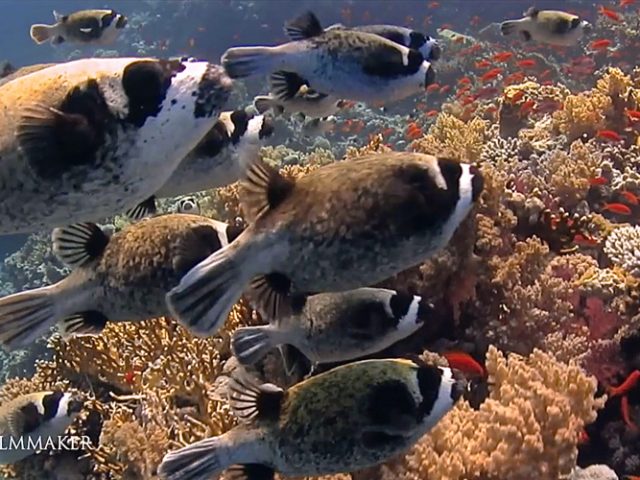
The “Masked Puffer" (Arothron diadematus) is a pufferfish in the family “Tetraodontidae". It lives in the Red Sea only. Maximum length 30 cm, olive-green/grey with a black mask over the eyes and pectoral fins, mouth has a black border. Usually solitary but schools during mating period. It lives on the coral reefs, from surface to 20m depth. (Wikipedia)
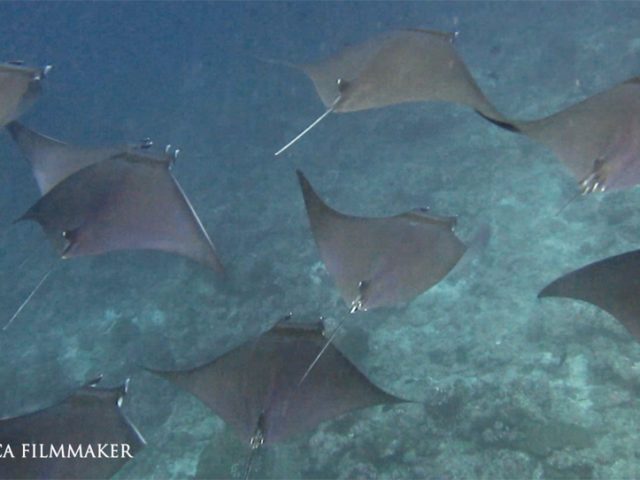
Mobula is a genus of rays in the family Mobulidae found worldwide in tropical and warm, temperate seas. Some authorities consider this to be a subfamily of the Myliobatidae (eagle rays). Their appearance is similar to that of manta rays, which are in the same family and based on geneticand morphological evidence, the mantas belong in Mobula. Species of this genus are often collectively referred to as "devil rays", "flying mobula" or simply "flying rays", due to their propensity for breaching, sometimes in a spectacular manner. It is found in tropical oceanic and coastal waters, It can be alone, in small groups or in schools, near the surface of the sea or near the seabed. As it swims, water passes into its mouth and exits through its gill slits, which filter out small particles and absorb oxygen from the water. It feeds mainly on mysids and other zooplankton but also consumes small schooling fish. (Wikipedia)
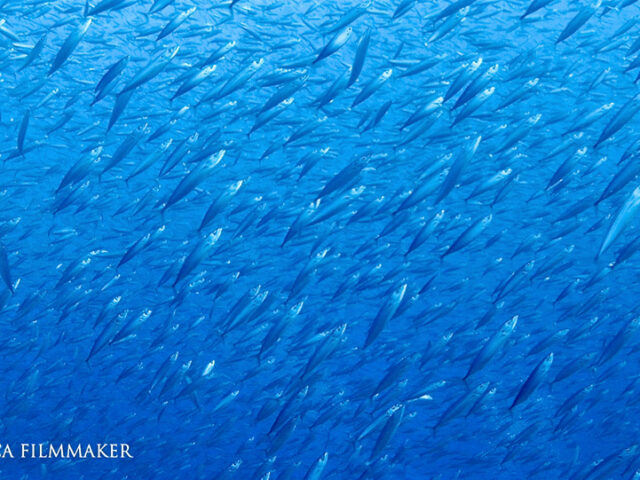
"Sardine" are common names that refer to various small, oily forage fish in the herring family Clupeidae. One criterion suggests fish shorter in length than 15 cm (6 in) are sardines, and larger fish are pilchards. Sardines feed almost exclusively on zooplankton, "animal plankton", and congregate wherever this is abundant. (Wikipedia)
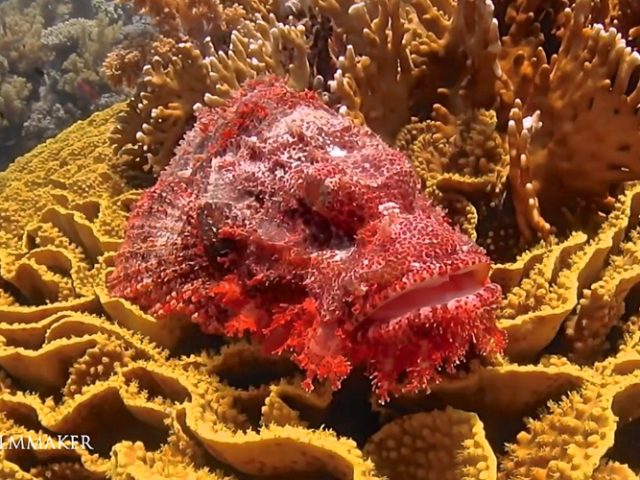
“Scorpaenidae" (also known as the Scorpionfish) are a family of mostly marine fish that includes many of the world's most venomous species. As the name suggests, scorpionfish have a type of "sting" in the form of sharp spines coated with venomous mucus. The family is a large one, with hundreds of members. They are widespread in tropical and temperate seas, but mostly found in the Indo-Pacific. General characteristics of family members include a compressed body, ridges and/or spines on the head, one or two spines on the operculum, and three to five spines on the preopercle. The dorsal fin has 11 to 17 spines, often long and separated from each other, and the pectoral fins are well-developed, with 11 to 25 rays. The spines of the dorsal, anal, and pelvic fins all have venom glands at their bases. Most species are bottom-dwellers that feed on crustaceans and smaller fish. Many inhabit shallow waters, but a few live as deep as 2,200 m (7,200 ft). Like many perciform fish, scorpionfish are suction feeders that capture prey by rapidly projecting a suction field generated by expansion of the fish's buccal cavity. (Wikipedia)
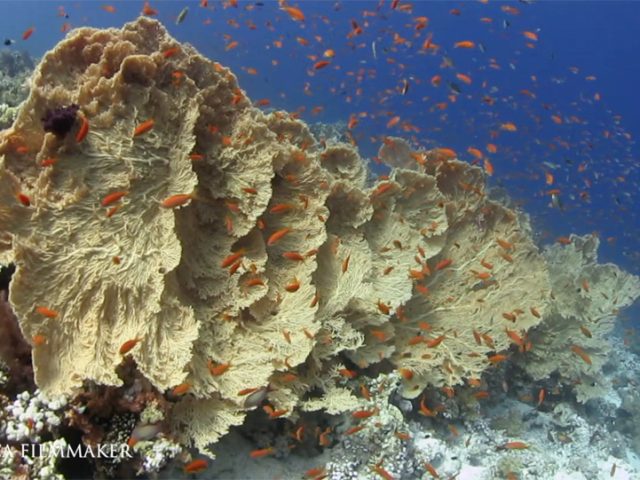
Alcyonacea, or soft corals, are an order of corals that do not produce calcium carbonate skeletons. Formerly known as gorgonians, they are sessil colonial cnidarians found throughout the oceans of the world, especially in the tropics and subtropics. Common names for subset of this order are sea fans and sea whips. They may be brightly coloured, often purple, red or yellow. About 500 different species of gorgonians are found in the oceans of the world, primarily in shallow waters, though some have been found at depths of several thousand feet. Each gorgonian polyp has eight tentacles, which catch plankton and particulate matter for consumption. This process, called filter feeding, is facilitated when the “fan” is oriented across the prevailing current to maximise water flow to the gorgonian, hence food supply.They are integral members of the reef ecosystem and provide habitat for fish, snails, algae and a diversity of other marine species. (Wikipedia)
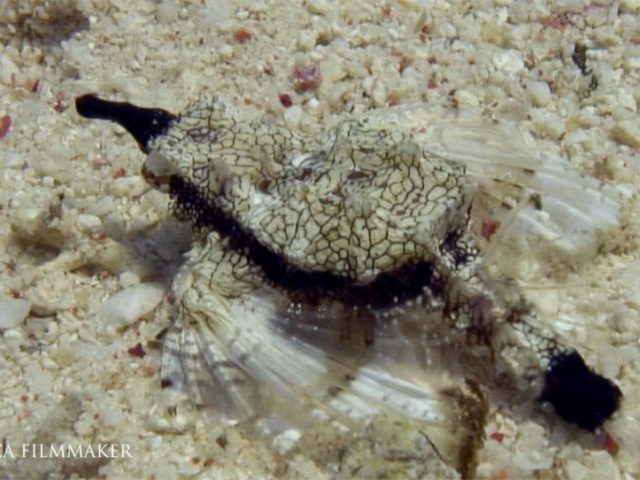
The seamoths make up a family of fish, the Pegasidae, within the order Gasterosteiformes. They are named for Pegasus, a creature from Greek mythology. Seamoths are notable for their unusual appearance, including flattened bodies, the presence of large, wing-like, pectoral fins, a long snout and a body encased in thick, bony plates. They are found primarily in coastal tropical waters of the Indo-Pacific. Seamoths have modified pelvic fins that allow them to "walk" across the sea bottom where they live; it has ventral jaws, located behind their long rostrum and are toothless. Their mouth is highly specialized and can form a tube-like mouth used to suck worms and other small invertebrates from their burrows. (Wikipedia)
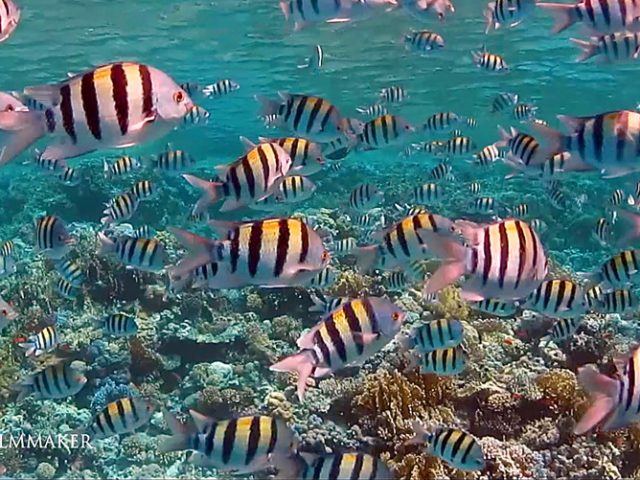
The “Sergeant Major" or “Píntano" (Abudefduf saxatilis) is a species of damselfish. It grows to a maximum length of about 22.9 centimetres (9.0 in). Sergeant majors earn their name from its brightly striped sides, known as bars, which are reminiscent of the insignia of a military sergeant major. Abudefduf saxatilis is found in the Atlantic Ocean. Populations in the western part of the Atlantic Ocean are found from the north eastern coast of the United States south to the Gulf of Mexico, the Bahamas, islands around the Caribbean Sea, the eastern coast of Central and South America all the way to Uruguay, Red Sea. Adult males have a more bluish coloration and its stripes are less visible. There is a dark spot around its pectoral fin. This fish feed upon the larvae of invertebrates, zooplankton, smaller fish, crustaceans, and various species of algae. Individuals of this species form aggregations of about several hundreds of individuals. (Wikipedia)
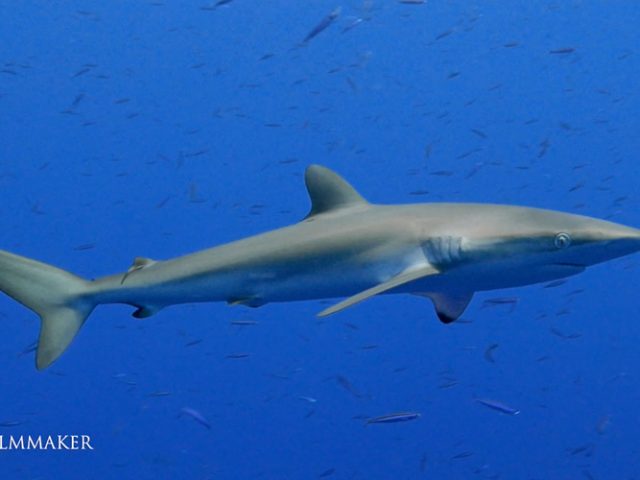
The “Silky Shark" (Carcharhinus falciformis), also known by numerous names such as “Blackspot Shark”, “Grey Whaler Shark”, “Olive Shark", is a species of requiem shark, in the family Carcharhinidae, named for the smooth texture of its skin. It is one of the most abundant sharks in the pelagic zone, and can be found around the world in tropical waters. Highly mobile and migratory, this shark is most often found over the edge of the continental shelf down to 50 m (164 ft). The silky shark has a slender, streamlined body and typically grows to a length of 2.5 m (8 ft 2 in). It can be distinguished from other large requiem sharks by its relatively small first dorsal fin with a curving rear margin, its tiny second dorsal fin with a long free rear tip, and its long, sickle-shaped pectoral fins. It is a deep, metallic bronze-gray above and white below. With prey often scarce in its oceanic environment, the silky shark is a swift, inquisitive, and persistent hunter. It feeds mainly on bony fish and cephalopods, and has been known to drive them into compacted schools before launching open-mouthed, slashing attacks. This species often trails schools of tuna, a favored prey. Its sense of hearing is extremely acute, allowing it to localize the low-frequency noises generated by other feeding animals, and, by extension, sources of food. The silky shark is viviparous. The large size and cutting teeth of the silky shark make it potentially dangerous, and it has behaved aggressively towards divers. However, attacks are rare, as few humans enter its oceanic habitat. (Wikipedia)
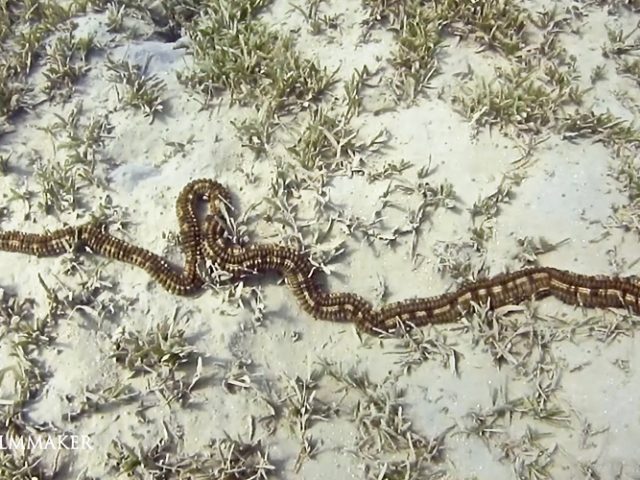
Synapta maculata, the snake sea cucumber, is a species of sea cucumber in the family Synaptidae. It is found in shallow waters in the tropical Indo-Pacific Ocean. Sometimes growing as long as 3 m (10 ft), it is one of the longest sea cucumbers in the world. Its colouring is variable, being some shade of yellowish-brown with wide longitudinal stripes and patches of darker colour. The tentacles of Synapta maculata surround the mouth and are used in surface feeding. They are about 2.5 cm (1 in) long when extended and have a short stem and a feather-like blade with thirty to forty pairs of pinnules. The outer surfaces of the tentacles have numerous bulges and are adhesive while the inner surfaces are smooth, with clusters of cilia on the proximal parts. The tentacles are in continuous motion; they flatten themselves against the substrate or seagrass leaf blades and collect food particles by adhesion, then bend inwards until the tips are in the mouth, where the food is scraped off by the buccal sphincter muscle. The whole process takes only a few seconds, and several tentacles can deliver their loads at the same time. If the animal is disturbed, the tentacles can contract back into the pharynx, but before long they are out again, collecting more particles. (Wikipedia)
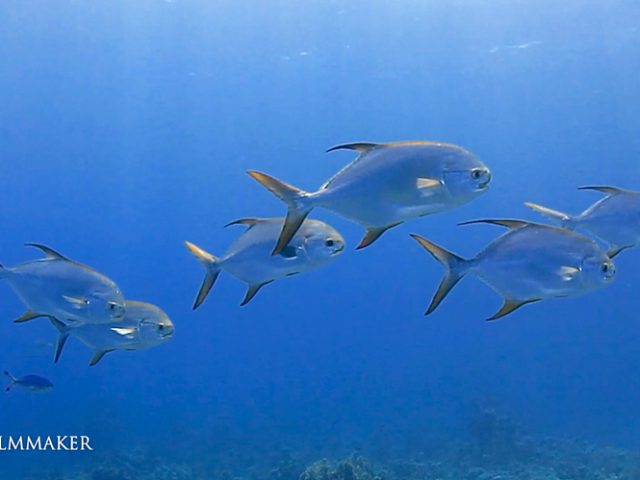
"Trachinotus Blochii”, are marine fish in the genus “Trachinotus" in the family Carangidae (better known as "jacks"). Pompano may also refer to various other, similarly shaped members of the Carangidae, or the order Perciformes. Distribution Indo-Pacific: Red Sea and East Africa to the Marshall Islands and Samoa, north to southern Japan, south to Australia. Their appearance is deep-bodied and mackerel-like, typically silver and toothless, with a forked tail and narrow base. Max length 110 cm, common lenght 40cm; weight 3.4 Kg. Adults feed primarily on sand mollusks and other hard-shelled invertebrates. (Wikipedia)
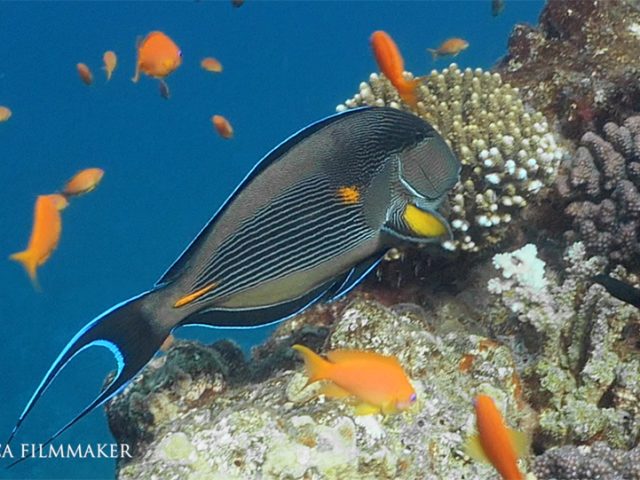
The sohal surgeonfish (Acanthurus sohal) or sohal tang, is a Red Sea endemic which grows to 16 in (40 cm) in the wild. Its striking blue and white horizontal stripes have made it what many consider the 'poster fish' for the Red Sea reef environment. Like other tangs, the sohal tang is compressed laterally, making it extremely maneuverable and fast along the reef. It has a horizontal, blade-like spine along the base of its tail on both sides, which folds into the fish, pointing anteriorly towards the head. During defense and aggression, tangs flick the spine at other fish or intruders, causing physical harm. The surgeonfish are named for this scalpel-like spine. Its primary diet consists mostly of vegetable matter, but occasionally includes the flesh of other animals. Sohal tang range includes all reef environments in the Red Sea, to 90 ft or deeper. It is one of the most aggressive tangs and combined with its large size for a tang, is a dominant fish along the Red Sea reef. (Wikipedia)
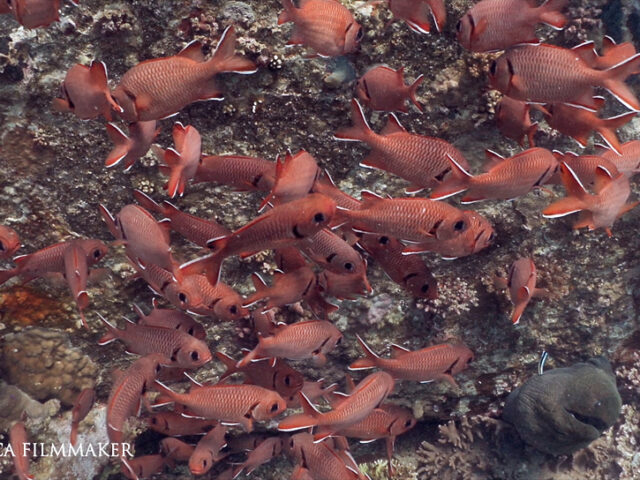
The blotcheye soldierfish (Myripristis berndti) is a species of soldierfish belonging to the family Holocentridae. The body is oval and laterally compressed and the scales are quite large; the basic colour is silvery pink to pale yellowish, with red scale margins; the opercular membrane is black. The dorsal fin is large and spiny, ranging from yellow to orange-yellow; the other fins are red with white edges. Its eyes are large, as this fish is mainly nocturnal. The lower jaw protrudes beyond the upper jaw when mouth is closed. They usually aggregate in mixed-species and mainly feed on plankton. (Wikipedia)
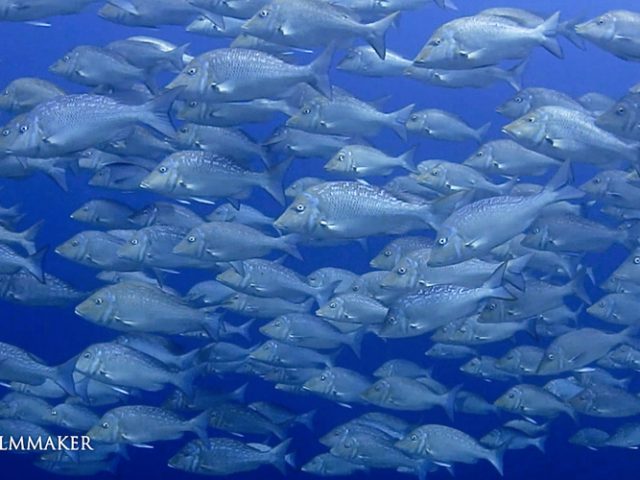
"Lethrinus Nebulosus" is a species of emperor fish. Common names include “Spangled Emperor”, “Green Snapper", “Morwong", “North-west snapper". This species is commonly found at approximately 87 cm in length, but grows to 70 cm. It is yellow to yellowish-brown or bronze-silver in colour, the belly being lighter. It has scattered blue markings over the body. The cheeks have no scales and may have a vertical blue markings. It has whitish or yellowish fins with a yellowish-edged dorsal fin. This fish occurs in the waters of East Africa to the southern parts of Japan. It also lives in Australian coastal waters, Red Sea, Persian Gulf and New Caledonia. Lethrinus nebulosus inhabits both marine and brackish waters at depths of between 10 and 75 metres. It is a non-migratory species and is found on coral and rocky reefs, seagrass beds, mangrove swamps, as well as over sandy substrates. Juveniles may be found in large schools. This species feeds mainly on mollusks, echinoderms and crustaceans. It also eats polychaetes and other fish, but less commonly. (Wikipedia)
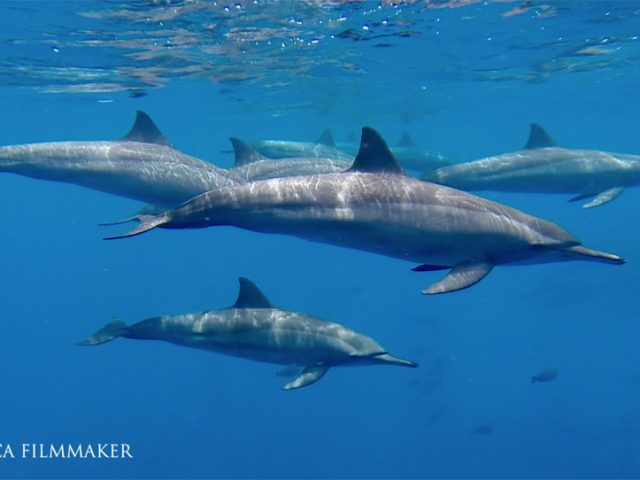
The spinner dolphin (Stenella longirostris) is a small dolphin found in nearly all tropical and subtropical waters between 40°N and 40°S. The species primarily inhabits coastal waters, islands or banks. However, in the eastern tropical Pacific, spinner dolphins live far from shore. They may use different habitats depending on the season. It is famous for its acrobatic displays in which it spins along its longitudinal axis as it leaps through the air. It is a member of the family Delphinidae of toothed whales. Spinner dolphins are small cetaceans with a slim build. Adults are typically 129–235 cm long and reach a body mass of 23–79 kg. This species has an elongated rostrum and a triangular or subtriangular dorsal fin. They generally have tripartite color patterns: the dorsal area is dark gray, the sides light gray and the underside pale gray or white. Also, a dark band runs from the eye to the flipper, bordered above by a thin, light line. However, the spinner dolphin has more geographic variation in form and coloration than other cetaceans. It feeds mainly on small mesopelagic fish, squids, sergestid shrimps and will dive 200–300 m to feed on them. (Wikipedia)
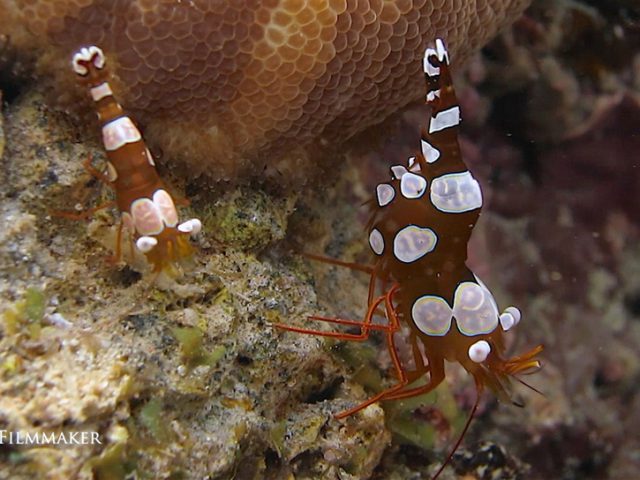
"Thor amboinensis", commonly known as the "Squat Shrimp", is a species of shrimp found across the Indo-West Pacific, in parts of the Atlantic Ocean and the Red Sea. It lives symbiotically on corals, sea anemones and other marine invertebrates in shallow reef communities. It's a small shrimp growing to a length of about 13 millimetres (0.5 in), olive brown colour with symmetrically placed white patches edged with thin blue lines. It characteristically carries its abdomen curved upwards with its tail fan above its head. (Wikipedia)
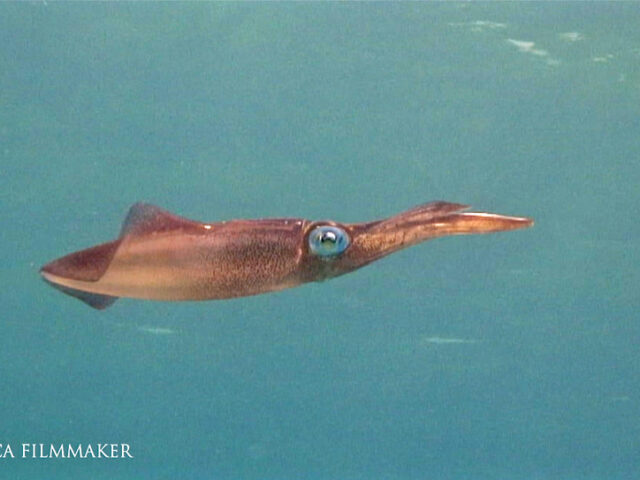
Squid are cephalopods in the superorder Decapodiformes with elongated bodies, large eyes, eight arms and two tentacles. Like all other cephalopods, squid have a distinct head, bilateral symmetry, and a mantle. The two long tentacles are used to grab prey and the eight arms to hold and control it. The beak then cuts the food into suitable size chunks for swallowing. Squid are rapid swimmers, moving by jet propulsion and largely locate their prey by sight. They can change colour for camouflage and signalling; some species are bioluminescent, using their light for counter-illumination camouflage, while many species can eject a cloud of ink to distract predators. (Wikipedia)
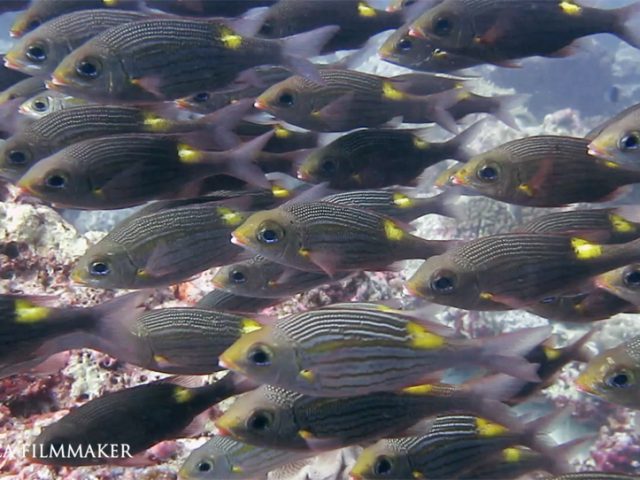
Holocentrinae is a subfamily of Holocentridae containing 40 recognized species and one proposed species. Its members are typically known as squirrelfish and all are nocturnal. All three genera in the subfamily are found in the Atlantic and Holocentrus is restricted to this ocean. Most species in genera Neoniphon and Sargocentron are from the Indo-Pacific region and several of these occur in the Indian Ocean west of the southern tip of India. (Wikipedia)
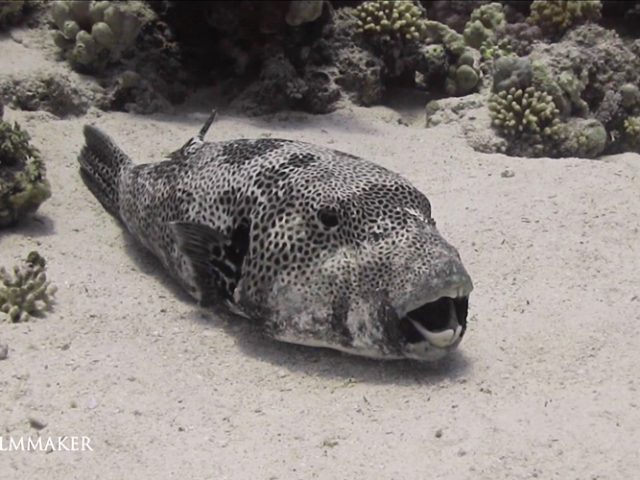
Arothron stellatus, also known as the stellate puffer, starry puffer, or starry toadfish, is a demersal marine fish belonging to the family Tetraodontidae. It is found in shallow water in the Indo-Pacific region. It is a medium-sized fish which grows up to 120 cm (47 in) in length; Its body is oval shaped, spherical and relatively elongated, the skin is not covered with scales but is prickly. The head is large with a short snout that has two pairs of nostrils and the mouth is terminal with four strong teeth. The background coloration goes from white to grey, and the body is harmoniously dotted with black spots. The ventral area is usually clearer. This species is found in tropical and subtropical waters from the Indian Ocean and Red Sea as far as Polynesia, southern Japan, the western, northern and eastern coasts of Australia. It is a relatively uncommon species and lives close to external reef slopes and sheltered lagoons with clear water. It contains a highly toxic poison, tetrodotoxin, in its ovaries and to a lesser extent its skin and liver, which protects it from voracious predators. To ward off potential enemies, they can inflate their bodies by swallowing air or water. (Wikipedia)
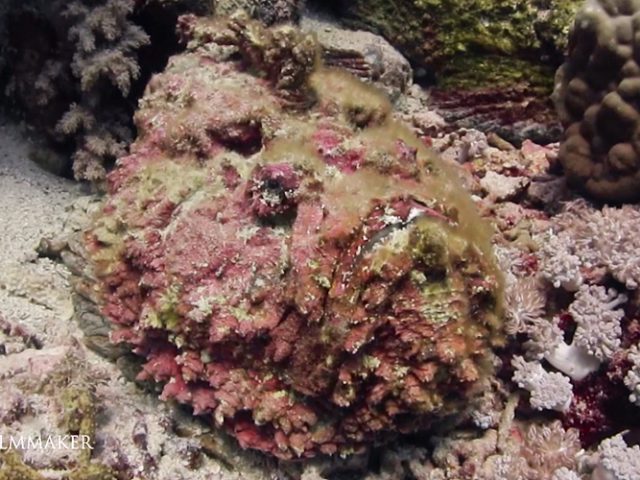
The “Stonefish”, genus “Synanceia”, whose members are dangerously venomous and even fatal to humans. They have potent neurotoxins secreted from glands at the base of their needle-like dorsal fin spines which stick up when disturbed or threatened. The vernacular name of the species, the stonefish, derives from its grey and mottled camouflage similar to the color of a stone (corals). Swimmers may not notice them and inadvertently step on them, triggering a sting. When the stonefish is disturbed, it may inject an amount of venom proportional to the amount of pressure applied to it. They are found in the coastal regions of the Indo-Pacific and the Red Sea, they eat mostly small fish, shrimps and other crustaceans. (Wikipedia)
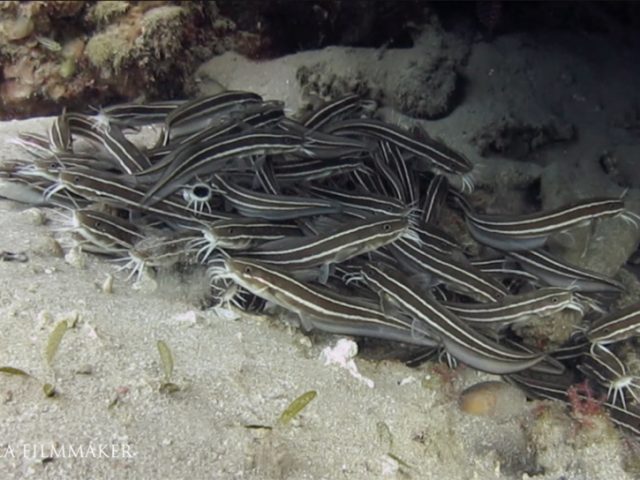
Common name striped eel catfish (Plotosus Lineatus), is a species of eeltail catfishes belonging to the family Plotosidae. It can reach a maximum length of 32 cm (13 in), its body is brown with cream-colored or white longitudinal bands.Tthe mouth is surrounded by four pairs of barbels, four on the upper jaw and four on the lower jaw. The first dorsal and each of the pectoral fins have a highly venomous spine, they may even be fatal. Juveniles of Plotosus lineatus form dense ball-shaped schools of about 100 fish, while adults are solitary or occur in smaller groups of around 20 and are known to hide under ledges during the day. Adult catfish search and stir the sand incessantly for crustaceans, mollusks, worms and sometimes fish. It occurs in the Indian Ocean, in the western Pacific Ocean and sometimes enters freshwaters in East Africa and Madagascar. (Wikipedia)
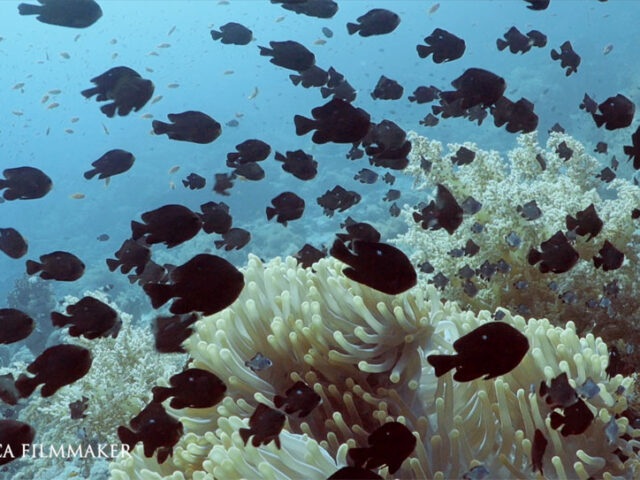
The threespot dascyllus (Dascyllus trimaculatus), also known as the domino damsel or simply domino, is a species of damselfish from the family Pomacentridae. It is native to the Indo-Pacific from the Red Sea and East Africa, to the Pitcairn Islands, southern Japan, and Australia. Its grey to black body has two lateral white spots and one between the eyes like domino hence the name; the threespot dascyllus grows up to 13 cm in length. Coloration is somewhat variable; the spot on the forehead may be absent and the lateral spots very much reduced. It feeds on algae, copepods and other planktonic crustaceans. Generally, adults are found in small groups around coral heads or large rocks. Juveniles may be found associated with large sea anemones or sheltering between the spines of diadema sea urchins or branching corals. (Wikipedia)
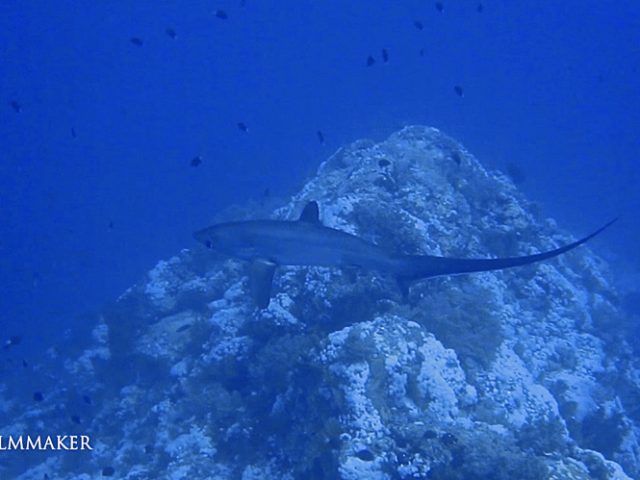
“Thresher Sharks" are large lamniform sharks of the family “Alopiidae" found in all temperate and tropical oceans of the world; the family contains four species, all within the genus “Alopias”. Although occasionally sighted in shallow, inshore waters, thresher sharks are primarily pelagic; they prefer the open ocean, venturing no deeper than 500 metres (1,600 ft). Common threshers tend to be more common in coastal waters over continental shelves. They are solitary creatures, some species however do occasionally hunt in a group of two or three contrary to their solitary nature. Named for their exceptionally long, thresher-like heterocercal tail or caudal fins (which can be as long as the total body length), thresher sharks are active predators; the tail is used as a weapon to stun prey. The thresher shark has a short head and a cone-shaped nose. The mouth is generally small, and the teeth range in size from small to large. They are fairly slender, with small dorsal fins and large, recurved pectoral fins. With the exception of the bigeye thresher, these sharks have relatively small eyes positioned to the forward of the head. Coloration ranges from brownish, bluish or purplish gray dorsally with lighter shades ventrally. Pelagic schooling fish (such as bluefish, juvenile tuna, and mackerel), squid and cuttlefish are the primary food items of the thresher sharks. They are known to follow large schools of fish into shallow waters. Crustaceans and occasionally seabirds are also taken. (Wikipedia)
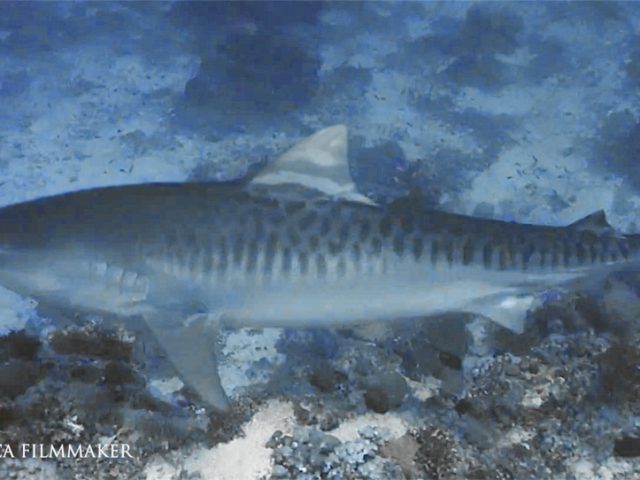
The tiger shark (Galeocerdo cuvier) is a species of requiem shark and the only extant member of the genus Galeocerdo. It is a large macropredator, capable of attaining a length over 5 m (16 ft 5 in). Populations are found in many tropical and temperate waters, especially around central Pacific islands. Its name derives from the dark stripes down its body, which resemble a tiger's pattern, but fade as the shark matures. Tiger shark teeth are unique with very sharp, pronounced serrations and an unmistakable sideways-pointing tip. Such dentition has developed to slice through flesh, bone and other tough substances such as turtle shells. Like most sharks, its teeth are continually replaced by rows of new teeth throughout the shark's life. It is a solitary, mostly nocturnal hunter. Tiger shark notable for having the widest food spectrum of all sharks, with a range of prey that includes crustaceans, fish, seals, birds, squid, turtles, sea snakes, dolphins and even other smaller sharks. It also has a reputation as a "garbage eater”, consuming a variety of inedible, man-made objects that linger in its stomach. Though apex predators, tiger sharks are sometimes taken as prey by groups of killer whales. It is considered a near threatened species due to finning and fishing by humans. It is second only to the great white in recorded fatal attacks on humans. (Wikipedia)
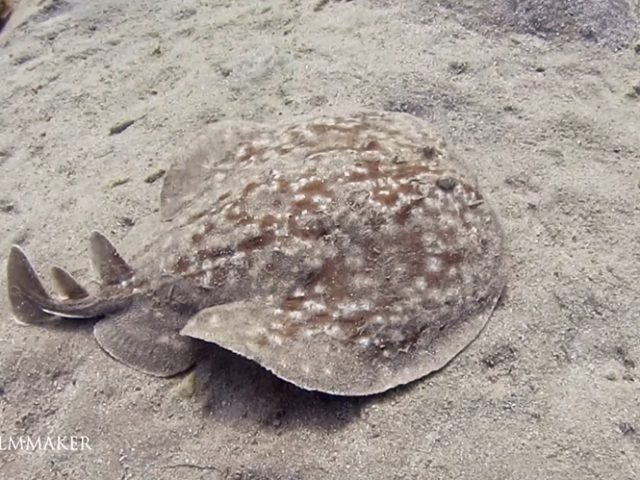
“Torpedo" is a genus of rays, commonly known as “Electric Rays”, “Torpedo Rays", or “Torpedoes". They are slow-moving bottom-dwellers capable of generating electricity as a defense and feeding mechanism. The naval weapon known as the torpedo was named after this genus, whose own name is derived from the Latin word Torpidus meaning "numb" or "paralysed", presumably the sensation one would feel after experiencing the ray's electric shock. These generate an electric gradient, similar to the normal electric potential across most cell membranes, but amplified greatly by its concentration into a very small area. The electricity can be stored in the tissues, which act as a battery. The battery can be discharged in pulses. A ray can emit a shock into the body of a prey animal to stun it and make it easier to capture and eat, or into the body of a predator. Torpedo rays are flat like other rays, disc-shaped, with caudal fins that vary in length. Their mouths and gill slits are located on their undersides. Males have claspers near the base of the tail. Females are ovoviviparous, meaning they form eggs but do not lay them. The young "hatch" within her body and she bears them live. (Wikipedia)
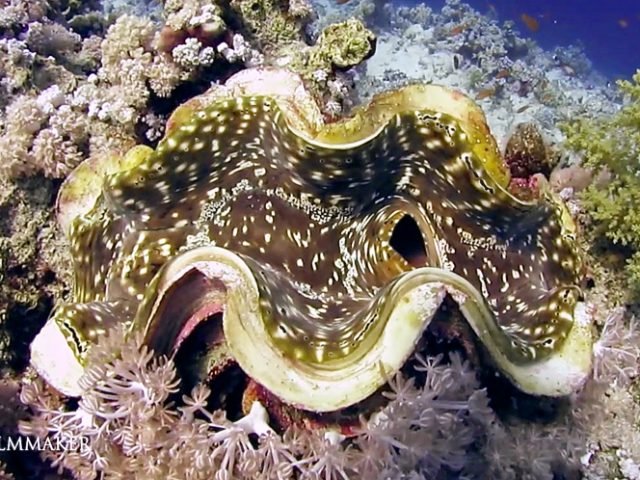
“Tridacna" is a genus of large saltwater clams, marine bivalve mollusks in the subfamily Tridacninae, the giant clams. They have heavy shells, fluted with 4 to 6 folds, when disturbed, the clam closes its shell. The mantle is brightly coloured; they live in symbiosis with photosynthetic algae (zooxanthellae). Tridacna clams are common inhabitants of Indo-Pacific coral reef benthic communities in shallower waters. (Wikipedia)
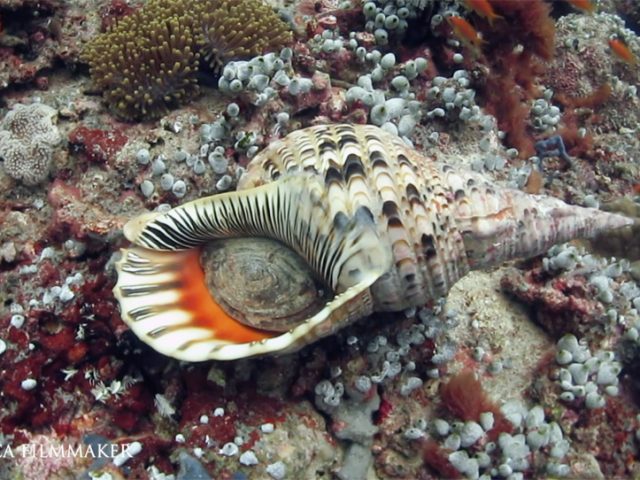
Charonia is a genus of very large sea snail, commonly known as Triton's trumpet or Triton snail. They are marine gastropod mollusks in the monotypic family Charoniidae. Species within the genus Charonia have large fusiform shells, usually whiteish with brown or yellow markings, it inhabit temperate and tropical waters worldwide. Adult tritons are active predators and feed on other molluscs and starfish. The giant triton has gained fame for its ability to capture and eat crown-of-thorns starfish, a large species (up to 1 m in diameter) covered in venomous spikes an inch long. The crown-of-thorns starfish has few other natural predators and has earned the enmity of humans in recent decades by proliferating and destroying large sections of coral reef. (Wikipedia)
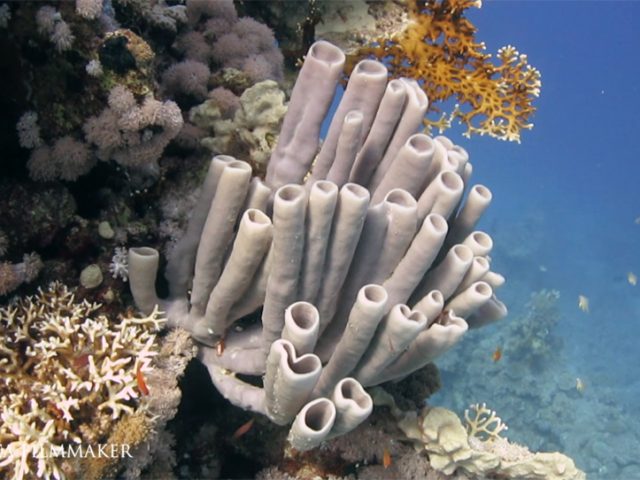
A sponge is a member of the phylum Porifera. It is a simple animal with many cells, but no mouth, muscles, heart or brain. It is sessile: it cannot move from place to place the way most animals can. A sponge is an animal that grows in one spot like most plants do. The basic body plan is a jelly-like layer sandwiched between two thin layers of cells. Their bodies are full of pores and channels allowing water to circulate through them; most of them feed on bacteria and other microorganisms, a few of them eat tiny crustaceans. There are more than 10,000 species of sponge, most sponges live in the ocean, a few live in fresh water. All sponges take in water through pores (little holes) in their bodies, the water goes out through a big tube in the center. Most sponges filter (take out) little bits of food from the water going through their bodies. Animals that get food this way are called filter feeders. (Wikipedia)
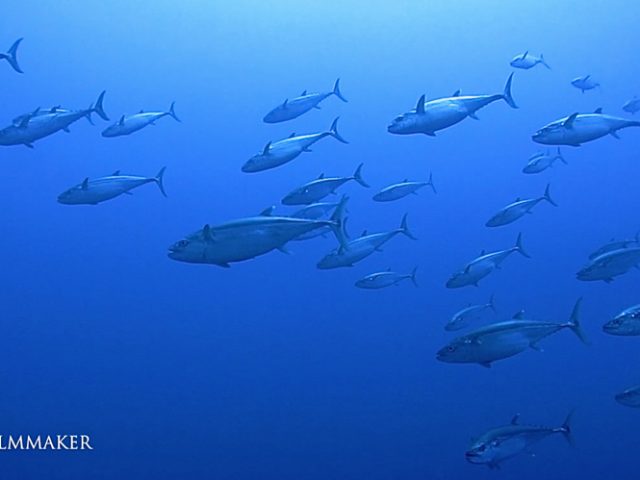
A “Tuna" is a saltwater fish that belongs to the tribe “Thunnini", a subgrouping of the Scombridae (mackerel) family. The Thunnini comprise 15 species across five genera, the sizes of which vary greatly, ranging from the bullet tuna (max. length: 50 cm (1.6 ft), weight: 1.8 kg (4 lb)) up to the Atlantic bluefin tuna (max. length: 4.6 m (15 ft), weight: 684 kg (1,508 lb)). The bluefin averages 2 m (6.6 ft), and is believed to live up to 50 years. Tuna, opah, and mackerel sharks are the only species of fish that can maintain a body temperature higher than that of the surrounding water. An active and agile predator, the tuna has a sleek, streamlined body, and is among the fastest-swimming pelagic fish – the yellowfin tuna, for example, is capable of speeds of up to 75 km/h (47 mph). It has two closely spaced dorsal fins on its back; The first is “ epressible", it can be laid down, flush, in a groove that runs along its back. Seven to ten yellow finlets run from the dorsal fins to the tail, which is lunate, curved like a crescent moon and tapered to pointy tips. The caudal peduncle, to which the tail is attached, is quite thin, with three stabilizing horizontal keels on each side. The tuna's dorsal side is generally a metallic dark blue, while the ventral side, or underside, is silvery or whitish, for camouflage. (Wikipedia)
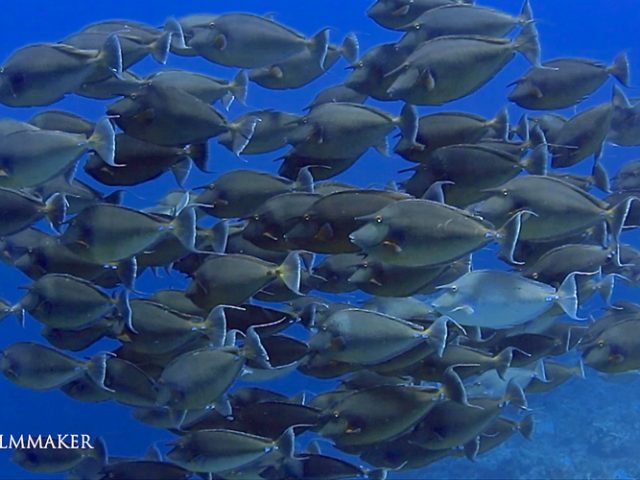
“Naso" is a genus of fish in the surgeonfish family, Acanthuridae. Fish of this genus are known commonly as "Ridolfi Fish" because of the "rostral protuberance", a hornlike extension of the forehead present in some species. This genus is distributed across the Indo-Pacific from Africa to Hawaii. Unicornfish primarily live around coral reefs and eat mostly algae. The “Bluespine Unicornfish" or “Short-Nose Unicornfish" (Naso unicornis) is a tang from the Indo-Pacific. It grows to a size of 70 cm in length. Inhabit channels, moats, lagoon and seaward reefs with strong surge. (Wikipedia)
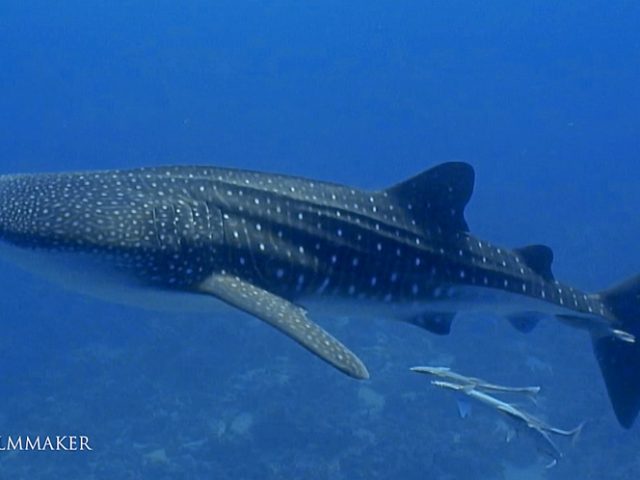
The “Whale Shark" (Rhincodon typus) is a slow-moving, filter-feeding carpet shark and the largest known extant fish species. The largest confirmed individual had a length of 12.65 m (41.5 ft) and a weight of about 21.5 t (47,000 lb). The whale shark is found in open waters of the tropical oceans and is rarely found in the water below 21 °C (70 °F). Modeling suggests a lifespan of about 70 years, but measurements have proven difficult. Whale sharks have very large mouths and are filter feeders, which is a feeding mode that occurs in only two other sharks, the megamouth shark and the basking shark. They feed almost exclusively on plankton and small fish and pose no threat to humans. The whale shark inhabits all tropical and warm-temperate seas. The fish is primarily pelagic, living in the open sea but not in the greater depths of the ocean, although it is known to occasionally dive to depths of as much as 1,800 metres (5,900 ft). (Wikipedia)

The great white shark (Carcharodon carcharias), also known as the great white and white shark, is a species of large mackerel shark which can be found in the coastal surface waters of all the major oceans. It is notable for its size, with larger female individuals growing to 6.1m. in length and 1,905–2,268 kg in weight at maturity. The great white shark has a robust, large, conical snout. The upper and lower lobes on the tail fin are approximately the same size which is similar to some mackerel sharks. Great white sharks, like many other sharks, have rows of serrated teeth behind the main ones, ready to replace any that break off. When the shark bites, it shakes its head side-to-side, helping the teeth saw off large chunks of flesh. It can swim at speeds of 25 km/hr (16 mph) for short bursts and to depths of 1,200 m (3,900 ft). Great white is one of the primary predators of marine mammals, up to the size of large baleen whales, it is also known to prey upon a variety of other marine animals, including fish and seabirds. It is the only known surviving species of its genus Carcharodon, and is responsible for more recorded human bite incidents than any other shark. The species faces numerous ecological challenges that have led to international protection, it is also protected by several national governments such as Australia. (Wikipedia)
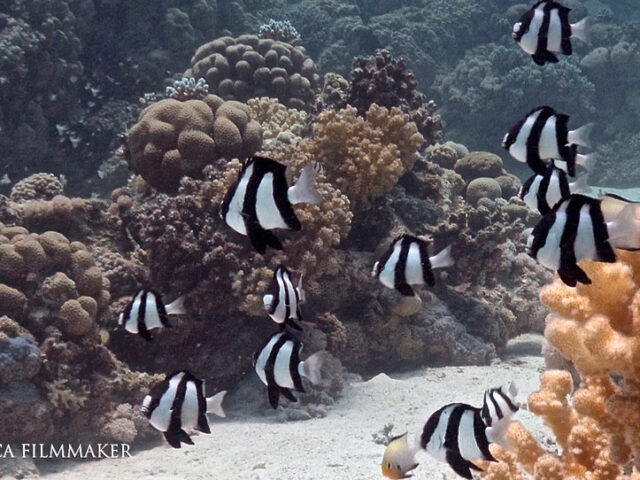
Dascyllus aruanus, known commonly as the whitetail dascyllus or humbug damselfish among other vernacular names, is a species of marine fish in the family Pomacentridae. It is up to 10 centimetres (3.9 in) in length but its common size is 6 centimetres (2.4 in) and is white with three black vertical bars. Associated with coral reefs, most usually in groups above Acropora coral heads. Males may be aggressive against other fish while they tend eggs. Whitetail dascyllus is widespread throughout the tropical waters of the Indo-Pacific region, Red Sea included. (Wikipedia)
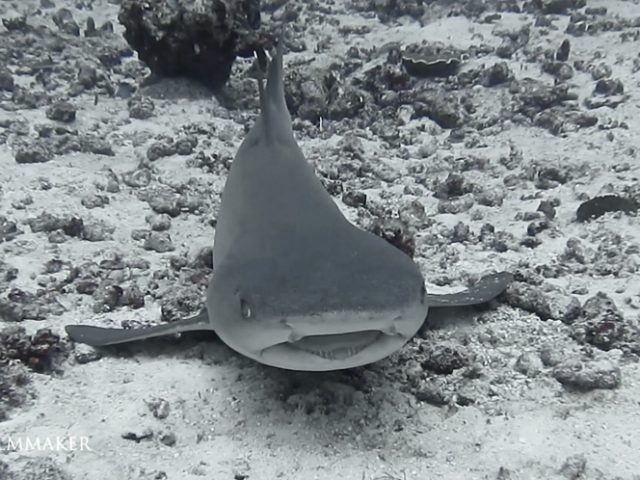
The “Whitetip Reef Shark" (Triaenodon obesus) is a species of requiem shark, in the family Carcharhinidae, and the only member of its genus. A small shark usually not exceeding 1.6 m (5.2 ft) in length, this species is easily recognizable by its slender body and short but broad head, as well as tubular skin flaps beside the nostrils, oval eyes with vertical pupils, and white-tipped dorsal and caudal fins. One of the most common sharks found on Indo-Pacific coral reefs, the whitetip reef shark occurs as far west as South Africa and as far east as Central America. It is typically found on or near the bottom in clear water, at a depth of 8–40 m (26–131 ft). During the day, whitetip reef sharks spend much of their time resting inside caves. Unlike other requiem sharks, which rely on ram ventilation and must constantly swim to breathe, this shark can pump water over its gills and lie still on the bottom. At night, whitetip reef sharks emerge to hunt bony fish, crustaceans and octopus in groups. Their elongate bodies allowing them to force their way into crevices and holes to extract hidden prey. Individuals may stay within a particular area of the reef for months or years, frequently returning to the same shelter. This species is viviparous. Whitetip reef sharks are rarely aggressive towards humans, though they may investigate swimmers closely. (Wikipedia)
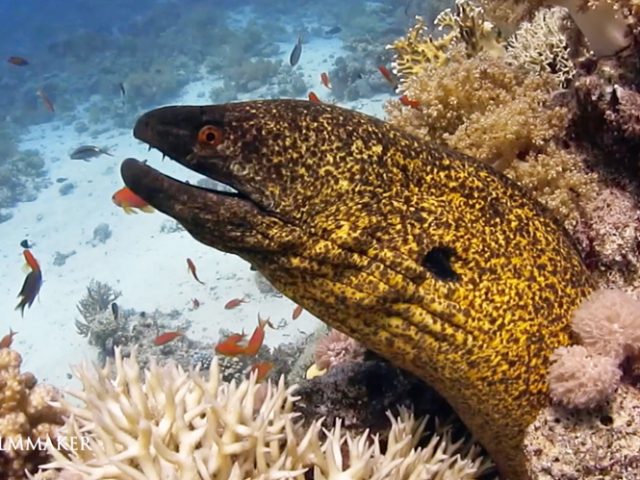
The “Yellow-Edged Moray" (Gymnothorax flavimarginatus) is a moray eel of the family Muraenidae. Its length is up to 7.87 feet (240 cm). It is brown with fine yellow mottling, orange eye. Inhabits reef and lagoon. Often with only head protruding. It feeds on small fish and crustaceans. This moray eel was recently identified as natural predator of the lionfish Pterois miles in its native habitat in the Red Sea. (Wikipedia)
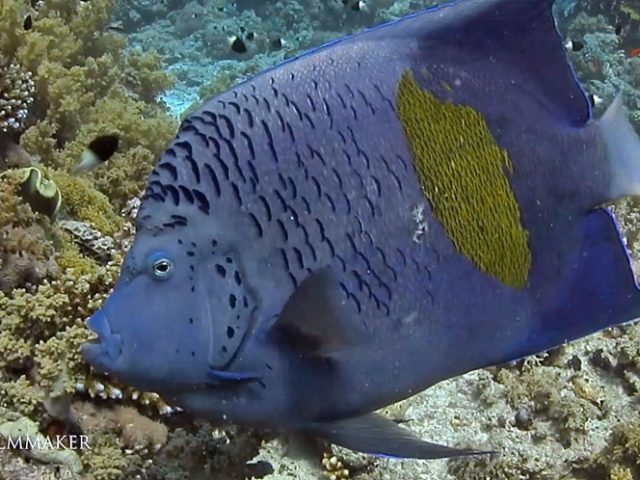
"Pomacanthus maculosus" is a marine angelfish with common names including “Halfmoon Angelfish", “Yellowband Angelfish". The species lives mainly in coral and rocky areas, in shallow to moderate depths (forty feet), though it is more often in silty reef areas than in rich coral growth. This angelfish grows to a size of 50 cm in length and it is distributed throughout the Persian Gulf, the northwestern Indian Ocean and the Red Sea. The Yellowbar has a diet typical of angelfishes: its main food is sponges, it also eats small anemones, algae, tubeworms and shrimps. (Wikipedia)
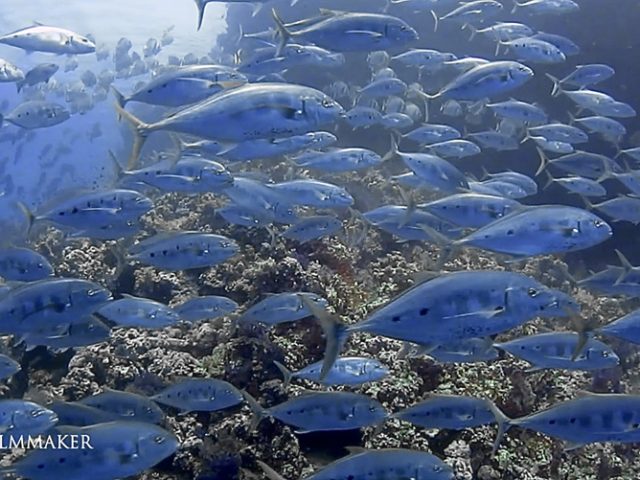
The “Yellowspotted Trevally" (Carangoides fulvoguttatus), also known as the “Yellowspotted Kingfish”, “Goldspotted Trevally" or “Tarrum", is a widespread species of large inshore marine fish in the jack family “Carangidae". The yellowspotted trevally inhabits the tropical and subtropical waters of the western Indo-Pacific region, Red Sea, from South Africa in the west to Japan and Australia in the east. The species is known to grow to a maximum length of at least 1.2 m, and is distinguished by gill raker and fin morphology, as well as the distinctive golden spots which give the fish its name. The yellowspotted trevally generally prefers inshore rocky and coral reefs, but is occasionally found over deep offshore sand banks to a depth of 100 m. It is a predatory fish, taking fish, cephalopods and crustaceans. (Wikipedia)
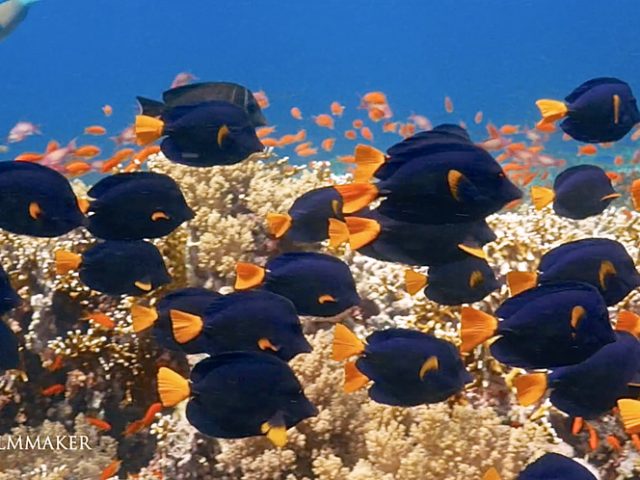
"Zebrasoma Xanthurum”, “Purple Tang", is a species of reef surgeonfish in the family Acanthuridae. Purple tangs grow to a maximum length of near 25 cm (9.8 in). Their bodies are purple in color with a yellow tail. The heads of purple tangs are covered with black spots, and black horizontal lines run down the sides of the bodies of some specimens. The center of their bodies are sometimes a darker color of purple relative to the rest of their bodies. On most specimens, the tips of their pectoral fins are yellow. Like all members of the genus Zebrasoma, purple tangs have large dorsal and anal fins and an extended snout that is used to forage for algae within rocks. When the dorsal and anal fins are fully extended, the fish looks like a disk. As typical of all surgeonfish, purple tangs have a sharp spines on each side of their caudal peduncle, which are used for defense. It has been historically noted that purple tangs are only found in the Red Sea, but it has now been understood that this is not completely true. Purple tangs have now been found in the Gulf of Aden, Persian Gulf, and the Arabian Sea. Purple tangs typically inhabit coral reef ecosystems, where they are found eating filamentous algae in the reef. They have been found at depths ranging from 2 to 20 m (6.6 to 65.6 ft). Adults are typically found swimming in shoals, while juveniles remain solitary. (Wikipedia)
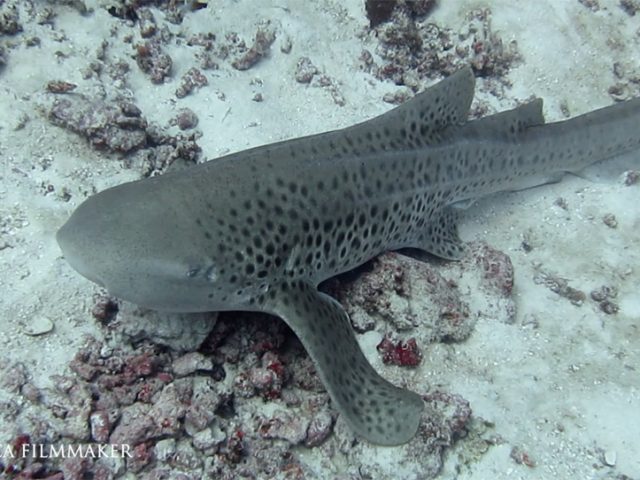
Or "Leopard Shark" (Stegostoma fasciatum) is a species of carpet shark and the sole member of the family “Stegostomatidae". It is found throughout the tropical Indo-Pacific, frequenting coral reefs and sandy flats to a depth of 62 m (203 ft). Adult zebra sharks are distinctive in appearance, with five longitudinal ridges on a cylindrical body, a low caudal fin comprising nearly half the total length, and a pattern of dark spots on a pale background. Young zebra sharks under 50–90 cm (20–35 in) long have a completely different pattern, consisting of light vertical stripes on a brown background, and lack the ridges. This species attains a length of 2.5 m (8.2 ft). Zebra sharks are nocturnal and spend most of the day resting motionless on the sea floor. At night, they actively hunt for molluscs, crustaceans, small bony fish and possibly sea snakes inside holes and crevices in the reef. Though solitary for most of the year, they form large seasonal aggregations. The zebra shark is oviparous: females produce several dozen large egg capsules, which they anchor to underwater structures via adhesive tendrils. (Wikipedia)
